














One device, delivering coffee and tea, hot and iced at the touch of a button with a bulk brewer 2-4 liters. The TONE IBS –Intelligent Brewing System - allows the barista to adjust the key brewing parameters and find the optimal extraction. The intuitive interface facilitates programming and total control of water volume, temperature and time of extraction. Perfect for the barista’s daily operations.
The TONE NITRO incorporates an integrated cooler and uses nitrogen from the air instead of high-pressure nitrogen cylinders to deliver maximum performance and space efficiency in the workplace. The addition of nitrogen enriches your beverages by giving them a smooth, velvety texture with a foamy surface no matter whether iced coffee/ tea or sophisticated cocktail creations. Nitro has a 5 liters plug & play canister and works in unison with Touch 01 to deliver a total solution that generates a wow factor.


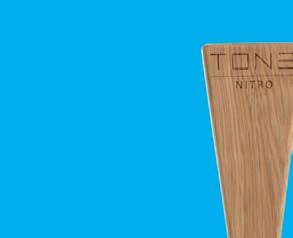
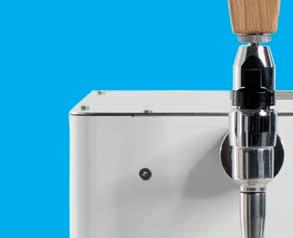






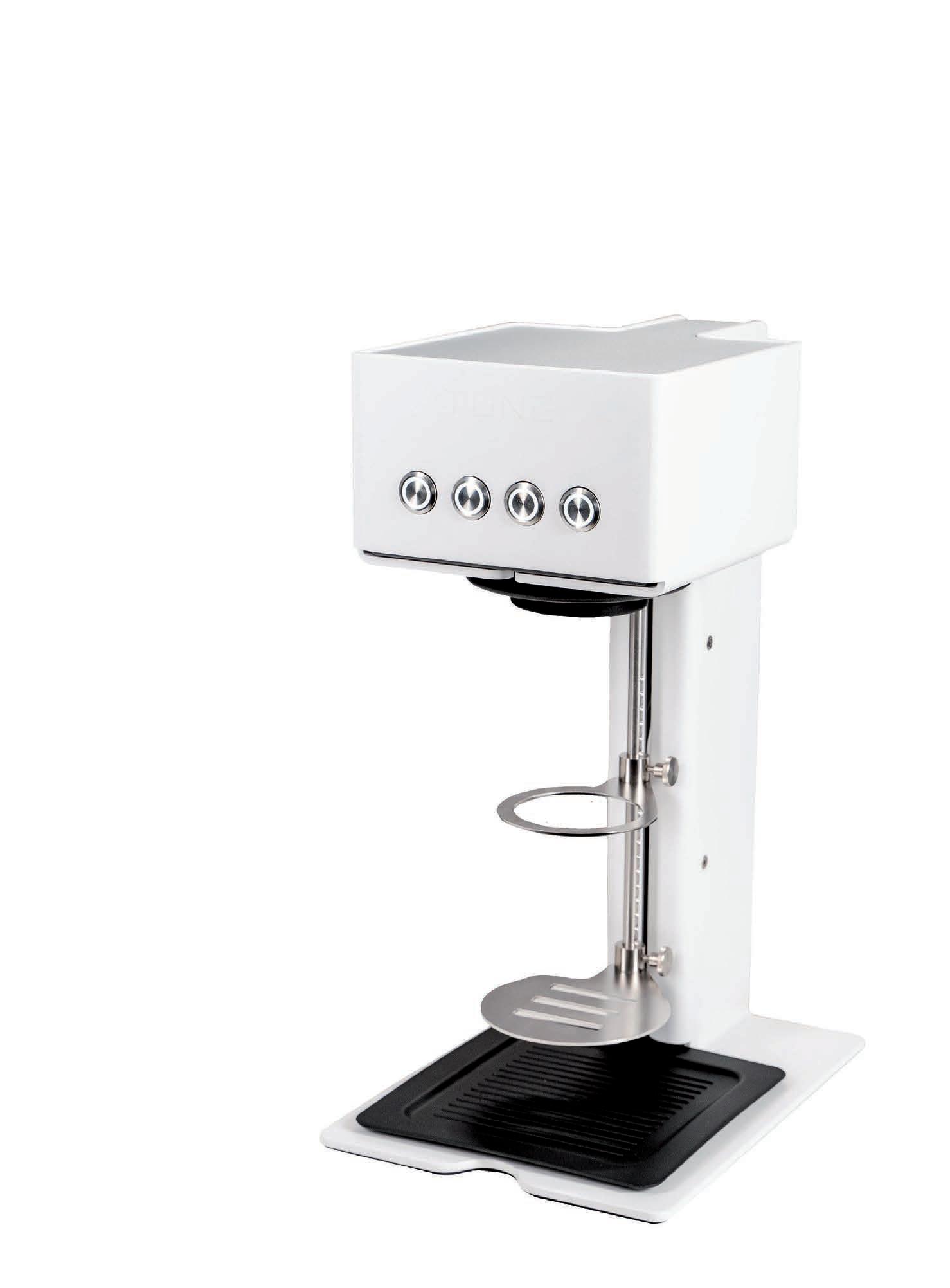




TONE‘s powerful Touch 03 single serve brewer unleashes the full potential of coffee and tea at the touch of a button. The intelligent recipe development system enables 100% customization of coffee and tea beverages including the ability to vary product, volume, flow, strength, and temperature.
The Touch 03 offers controlled agitation, programmable flow rates, and detailed adjustment of pulse patterns at different stages of brewing (e.g. blooming-, turbulence-, development-).
The boilerless standalone brewing system sustainably channels brew water through a highly innovative heating element that eliminates the need for a traditional heating phase. The barista is empowered to easily adjust brew recipes to profile various coffee and tea beverages by varying temperature, brew time, and a host of other parameters.
The most revolutionary brewer on today‘s market has all the operational capability to take the modern brew bar to the next level.

sales@baristagroup.com.au
www.baristagroup.com.au
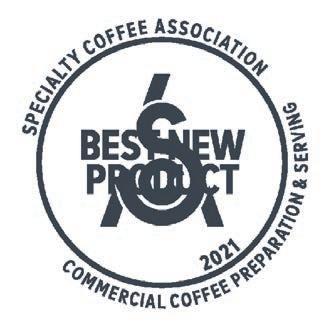
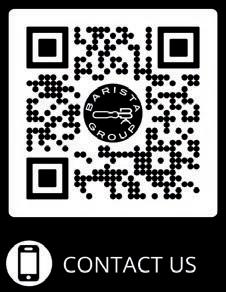
internationalcoffeeexpo.com internationalcoffeeexpo@primecreative.com.au

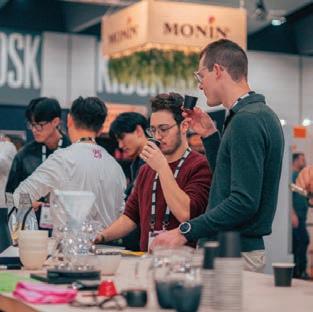


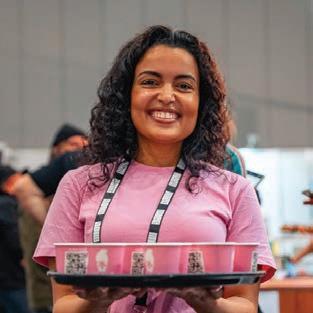

Brunetti’s Giorgio Angele shares his secrets to surviving eight decades in the industry, and his memories of early Australian café culture
Kay-Lene Tan on competiting against her role models and her new restaurant project 24 DOWN TO A FINE ART
Lavazza reveals its line of coffees exclusive to the Australian market, crafted in collaboration with local artists 28
What other businesses can learn from Single O’s Asian expansion
Why engaging the local community is key to the success of new cafés
How Riverina Fresh is embracing innovation and sustainability
36 THE SILENT PARTNER
The Bean Cartel Co-Founder on surviving business failure and the importance of a female perspective
45 C HANGING LANES
From pints to cappuccinos, what one couple learnt switching hospitality lanes
46 C REATIVE DISRUPTION
MONIN on its mission to disrupt the status quo
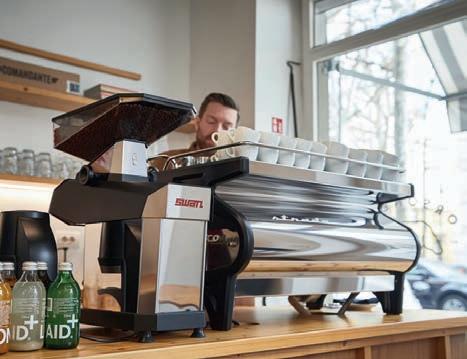

52 BLOOMIN' LOVELY
Why Paradox Coffee Roasters prefers a holistic approach
64 THE HYBRID HOSTEL
How Smeg helped YHA modernise its venues across Australia 67 MISSION ACCOMPLISHED
Melbourne International Coffee Expo 2024, wrapped
32 TR ADITION MEETS INNOVATION
How La Marzocco is embracing automation in its innovation era
40 INTUITIVE TECHNOLOGY
The low-down on Victoria Arduino’s new semi-automatic espresso machines
43 GAME-CHANGING TECHNOLOGY
The products Barista Group partners can’t live – or work – without
48 MILKING THE SYSTEM
How the new Viper Milk Dispensing System is helping reduce plastic polution
60 CONTEMPORARY
C RAFTSMANSHIP
Meet WMF Ambassador and German Latte Art Champion Daniel Gerlach
72 PRECISION POURING
Franke spotlights its new PrecisionFoam technology
51 THE X FACTOR
Jura introduces the new X10 automatic coffee machine
Everything you need to know about the latest xBloom model
53 THE SUITE SPOT
Cropster highlights its new automation software for roasters and café owners
54 A EUREKA MOMENT
How the Atom W 75 grinder uses automation to deliver consistency, reliability, and praticality
55 POWERING PRODUCTIVITY
IMA Coffee Hub on its latest automation-based software
56 AUTOMATION NATION
Barista Equip reccommends the must-have automatic products for businesses of all shapes and sizes
63 ESPRESSO PRECISION
Jack Simpson shares his Mazzer Philos grinder recipe
80 ESPRESSO YOURSELF
Try Victor Vu’s jungle-inspired raccoon design
CAFÉ SCENE
75 THE PATH TO DECARBONISATION
Emma McDougall lays out NZSCA’s green plans for roaster members
76 CAFÉ SCENE
Venues across Australia and New Zealand for your hit list
82 GET TO KNOW
Meet Australia’s Richest Barista champion Junnie Phyu and find out how she plans to spend her prize money


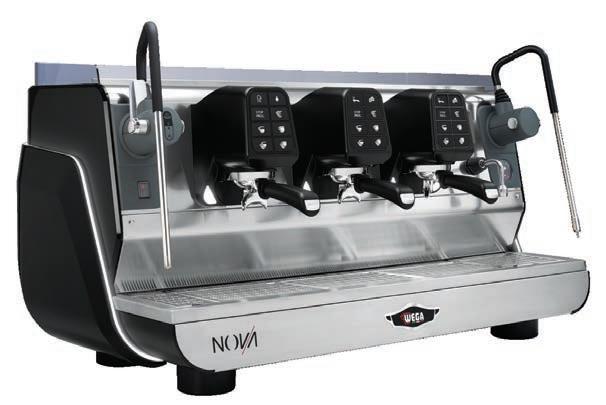
Elegance advances with the all new WBar Pro from Wega. Forged for the modern barista, its comprehensive, intelligent design is styled for optimum user functionality.
With raised groups, barista lights and electronic shot timers, the WBar Pro provides complete control for the coffee connoisseur. Paired with an optional auto steamer at the touch of a button, the WBar Pro is unapologetically functional and aesthetic.
Nova: the beauty of necessity. Enjoy a design based on principles of ergonomics and ease of use – it improves the user experience and the system’s overall performance, with particular attention paid to the interactive design.
Every edge and angle is crafted for a seamless brewing experience, bringing satisfaction to every barista before a drop is poured or a cup is sipped.

Alfa Bakehouse, 97 Victoria Street, Seddon, Melbourne, Victoria, 3011 alfabakehouse.com.au
When the Lavazza team were considering the location for the BeanScene covershoot to capture their new line of coffee blends, Alfa Bakehouse in Seddon, Melbourne, was the natural choice.

The spacious café, and its sister outpost in Yarraville, were the first two venues in Australia to stock Lavazza’s Retreat blend. The coffee is one of three in the brand’s new Mosaic line of blends developed exclusively for the Australian market.
“Alfa Bakehouse is one of a select few flagship cafés that are trialling the coffees before they launch officially in August,” says Martina Elfinsson, Lavazza Australia Brand Manager.
“It’s really exciting to collaborate with the team at Alfa to capture the Mosaic line in one of the first places it’s being served. It’s also great to photograph the blends in Melbourne, in the same city in which they’re roasted.”
During Mosaic’s two-year development process, Lavazza’s coffee specialists collaborated with artists and tastemakers across Australia to encapsulate the country’s landscape, spirit, and coffee culture. One of those creatives was Daimon Downey, who distilled the project into three vibrant artworks – one for each coffee – with his contemporary take on the traditional art of mosaic.
Enthused by the bold designs, BeanScene photographer Blake Storey knew they had to feature in some way on the cover. With Retreat being served at Alfa Bakehouse, the rainforest-inspired artwork that decorates its bag was the clear winner for the backdrop.
A huge version of Daimon’s original design was printed with the brief to capture the coffee and artwork in one shot.
“We weren’t 100 per cent sure how it would turn out, there was a worry it might look like wallpaper. The print also arrived 10 times bigger than we expected, but I don’t think we could have wished for anything better – the resulting pictures are fantastic,” says Editor Kathryn Lewis.
“The distinction between the bold green print and the clean white cup creates a striking contrast, while Alfa Bakehouse Head Barista Rosella Jacinto’s latte art draws the eye to the most important element: the coffee.”
For more information, visit alfabakehouse.com.au

CHIEF OPERATING OFFICER
Christine Clancy christine.clancy@primecreative.com.au
PUBLISHER
Sarah Baker sarah.baker@primecreative.com.au
EDITOR
Kathryn Lewis kathryn.lewis@primecreative.com.au
JOURNALIST
Aisling Geraghty aisling.geraghty@primecreative.com.au
ART DIRECTOR/DESIGN
Daz Woolley
HEAD OF DESIGN
Blake Storey
BUSINESS DEVELOPMENT MANAGER
Adele Haywood adele.haywood@primecreative.com.au
C LIENT SUCCESS TEAM LEADER
Janine Clements janine.clements@primecreative.com.au
PHOTOGRAPHY
Kogi Shimamura, Blake Storey CONTRIBUTORS
Emma McDougall, Victor Vu
HEAD OFFICE
Prime Creative Pty Ltd 379 Docklands Drive, Docklands, Victoria 3008 p: 03 9690 8766 f: 03 9682 0044 enquiries@primecreative.com.au beanscenemagazine.com.au
SUBSCRIPTIONS 03 9690 8766 subscriptions@primecreative.com.au BeanScene magazine is available by subscription from the publisher. The rights of refusal are reserved by the publisher.
All articles submitted for publication become the property of the publisher. The Editor reserves the right to adjust any article to conform with the magazine format.
COPYRIGHT
BeanScene magazine is owned by Prime Creative Media and published by Christine Clancy. All material in BeanScene magazine is copyright and no part may be reproduced or copied in any form or by any means (graphic, electronic or mechanical including information and retrieval systems) without written permission of the publisher. The Editor welcomes contributions but reserves the right to accept or reject any material. While every effort has been made to ensure the accuracy of information Prime Creative Media will not accept responsibility for errors or omissions or for any consequences arising from reliance on information published. The opinions expressed in BeanScene magazine are not necessarily the opinions of, or endorsed by, the publisher unless otherwise stated.












Contributors
Each issue of BeanScene we profile a few of our talented contributors.
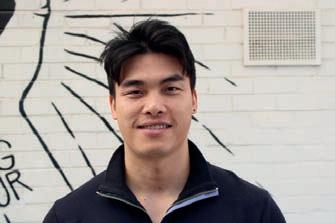
Victor Vu is the ASCA Australian Latte Art Champion. He placed seventh in the 2024 World Latte Art Championhip (WLAC) in Denmark in June. Born in Vietnam, Victor worked for three years in hospitality before coming to Australia to perfect his latte art skills. Victor won the 2018 Milklab Barista Battle, 2020 and 2024 ASCA Australian Latte Art Championships, and placed fifth in the 2022 WLAC. He currently works at Ona Coffee Melbourne.


Creativity is a thread that runs through the coffee community. Whether a barista, roaster, importer, or businesses owner, almost every person I’ve met who works in this industry has a creative streak that empowers them to push boundaries, explore new realms, and view coffee through an artistic lens.
Emma McDougall is the Communication and Administration Coordinator for the NZSCA. After gaining a degree in hospitality management, Emma has worked in Sydney, Dublin, Auckland, London, and, most recently, Wellington. She has owned and managed cafés and tech-judged the New Zealand Barista Championship in 2015 and 2016. Now, she gets to help run them. One of the greatest joys she gets from the coffee industry is watching young people progress through their coffee journey.



‘Like’ us on Facebook
@BeanSceneCoffeeMag
Follow us on Instagram
@beanscenemag
Follow us on LinkedIn
@BeanSceneMag
Just look at the designs presented in the World Latte Art Championships last month. Australian competitor and BeanScene columnist Victor Vu adorned lattes with a zoo’s worth of intricate jungle animals, inspired by his childhood love of nature.
Of course, it’s not just the latte artists who showcase their creativity in their work. Art is often a medium through which roasters tell the story of the innovative coffees they’ve crafted, the farmers who grew their beans, and the brand they’ve built.
Take a walk down any shopping street and there’s a good chance the local café has the most eye-catching shopfront. Crafting a multi-sensory experience that incorporates an inspiring backdrop to the coffee experience is so instilled in Australian café culture now that there’s a whole sub-brand of interior design influenced by the coffee shop aesthetic.
What’s more, the coffee industry’s branding is some of the most avantgarde and boundary pushing: no logo is too obscure, no coffee bag too wacky, no ad too out-of-the-box.
As such, creativity is also a thread that runs through this issue of BeanScene. This edition’s cover story details how the team at Lavazza Australia created a new blend specifically for antipodean coffee drinkers by collaborating with a group of artists and tastemakers. The result of their two-year project is a beautiful collection of blends and coordinating artworks that not only encapsulate the coffees but also Australia’s vibrant and diverse landscape.
We also hear from MONIN and Stitch Coffee on how the flavour specialist and Sydney roaster blended their creativity to develop a unique canned cold-brew to catch the attention of Melbourne International Coffee Expo attendees, and how MasterChef: Dessert Masters semifinalist Kay-Lene Tan channels her passion for coffee through her innovative dishes that look more like pieces of fine art than desserts to be devoured in mere minutes.
As part of this issue, it was an honour to interview one of Melbourne’s long-standing creative visionaries. The patriarch of the Brunetti collection of artisan cafés and cake shops, Giorgio Angele is in the eighth decade of his career as a pastry chef and continues to turn out beautiful cakes, pastries, and confection. He tells me about Melbourne’s early coffee culture and the key to running a business that survives financial crashes, pandemics, and all manner of global crises.
It’s this unrelenting creativity that makes the coffee scene such a wonderful thing to be a part of. It’s never boring, there’s always something new, and it never fails to surprise and delight me.
KATHRYN LEWIS EDITOR
BeanScene Magazine
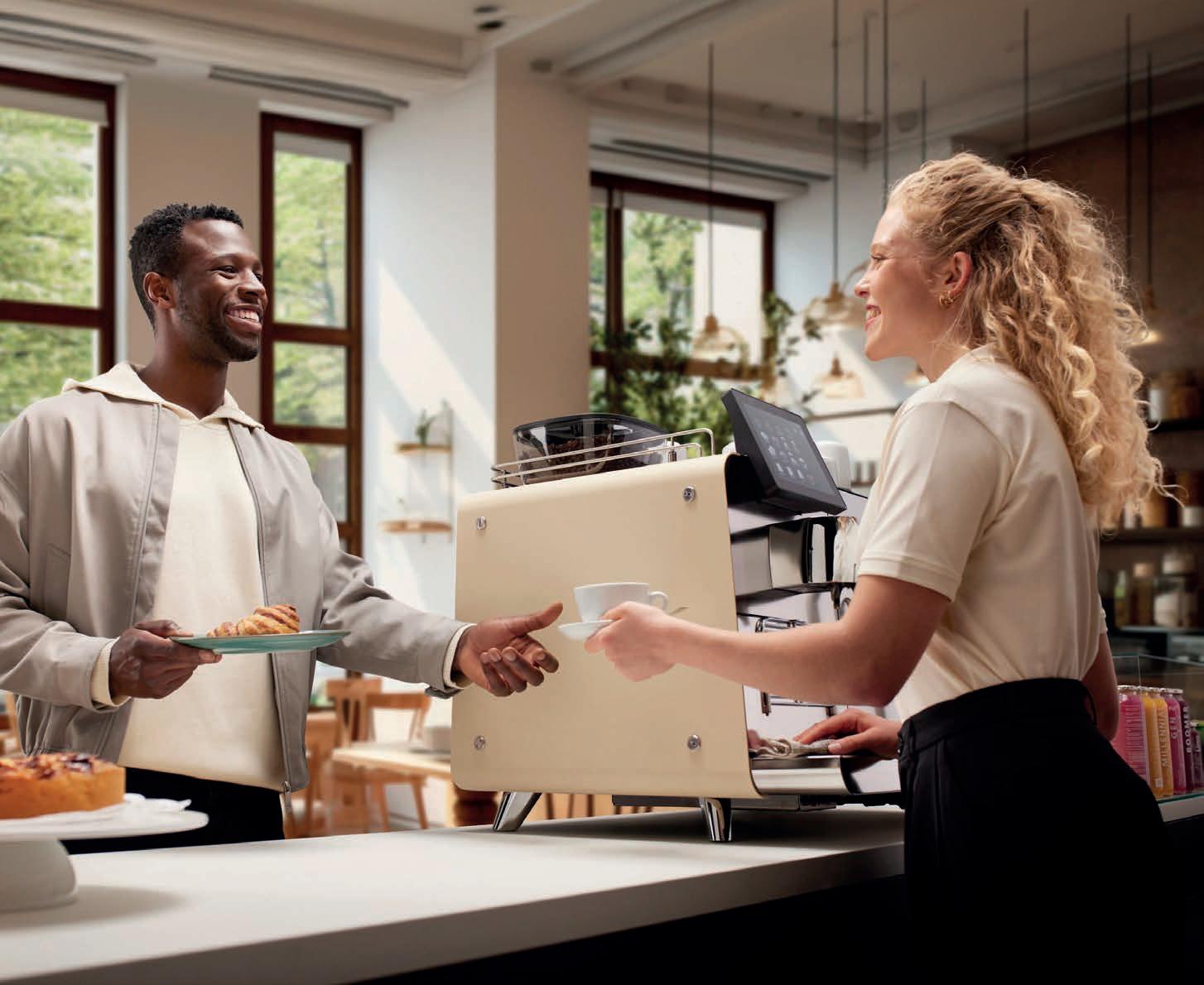

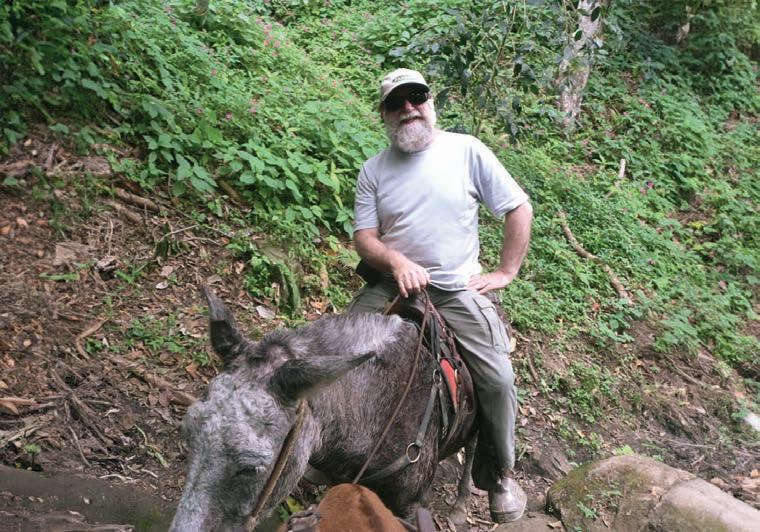
On 4 May, the Australian coffee industry lost a true icon and leader in Jasper Coffee Co-Founder Wells Trenfield.
After a battle with Multiple System Atrophy, Wells passed away peacefully at home and will be long remembered for his commitment to sustainable coffee production and devotion to enriching the
The third and final group of World Coffee Championship finals took place at World of Coffee in Copenhagen from 27 to 29 June. Over the three-day event, 86 competitors battled it out in the World Latte Art, World Coffee in Good Spirits, World Coffee Roasting, and Cezve/Ibrik Championships to be crowned world champion in their field.
Yi-Chen Xie of Taiwan earned first place in the World Latte Art Championship, with Manuela Fensore of Italy and Guoqiang Liu of China placing second and third respectively. ASCA Australia Latte Art Champion Victor Vu made it to the semifinals with his jungle-inspired designs.
In the World Coffee in Good Spirits Championship, Seung Chan Wi of South Korea took the top spot, with Sandro Roth of Switzerland runner-up and Andrea Villa of Italy in third place. Australian Coffee in Good Spirits champion Serene Yu ranked seventh in the preliminary round, narrowly missing out on the finals with a score of 398.
on, adapting new initiatives as they became available and relative. This includes introducing Fairtrade to Australia, becoming organic certified in 2003, the first Australian carbon neutral coffee roasting certification in 2009, and B Corp certification in 2015.
“Sustainability has always shaped how we do business. It also extends to how people can sustain their livelihood,” Wells told BeanScene in a former interview.
Wells’ family fondly recalls his deep
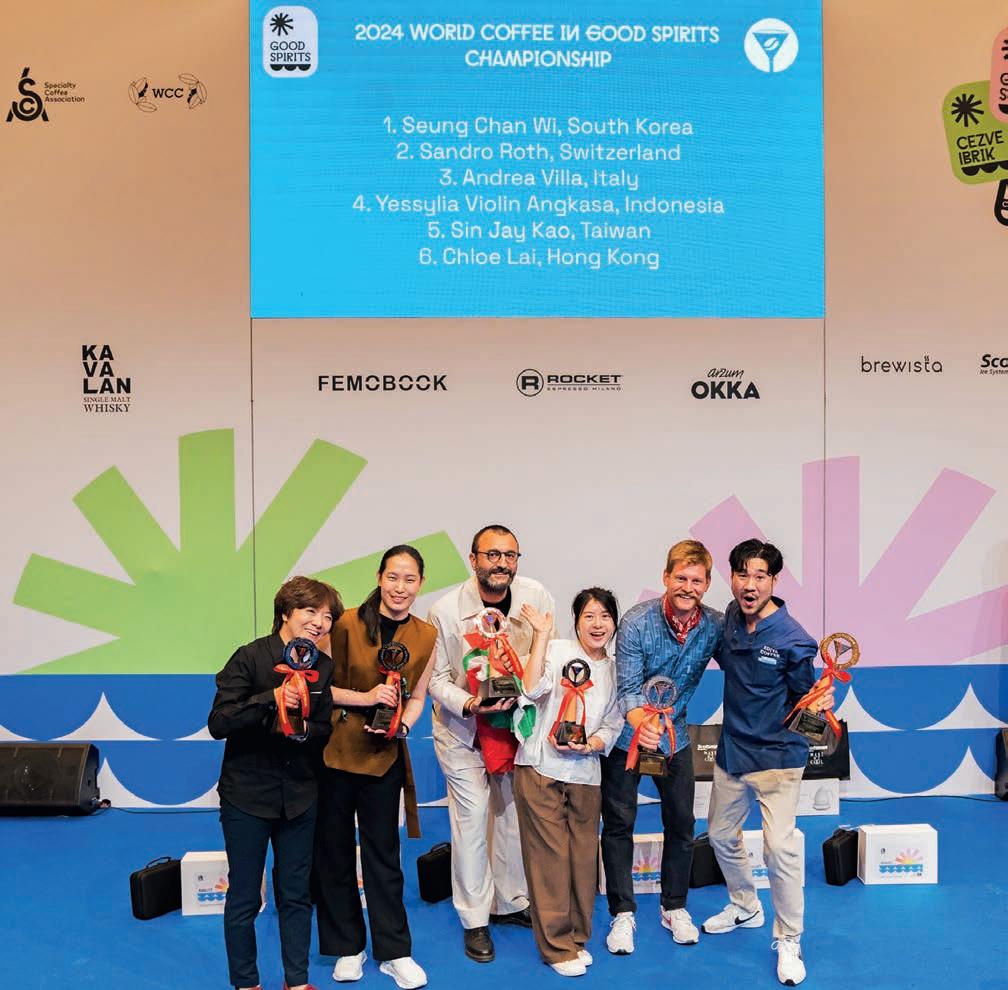
The World Coffee Roasting Championship crowned TaiYang Lui of China its winner, with Mateusz Derkacz of Poland and Andrea Trevisan of Austria placing second and third respectively.
Jordan Tachnakian of France won the 2024 Cezve/Ibrik competition, closely followed by Kevser Atmaca of Turkey in second place and Ivan Bilousov of Ukraine in third.
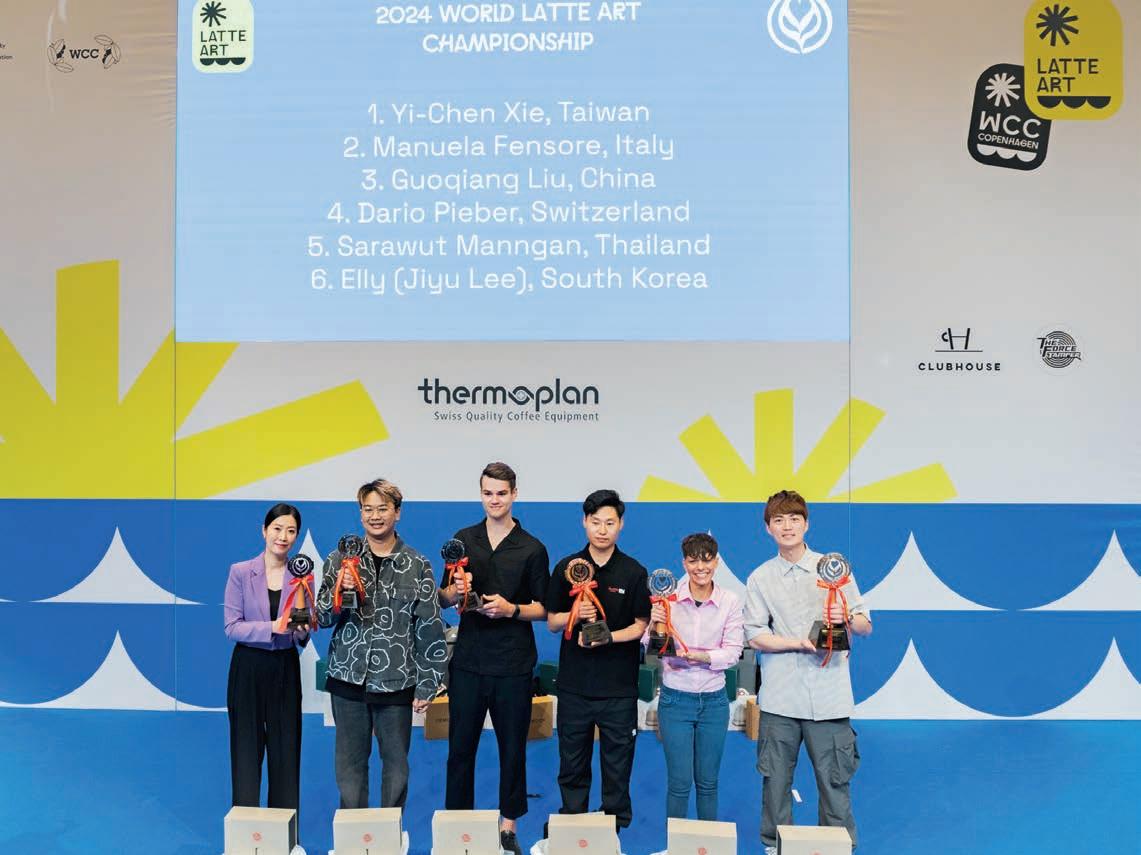
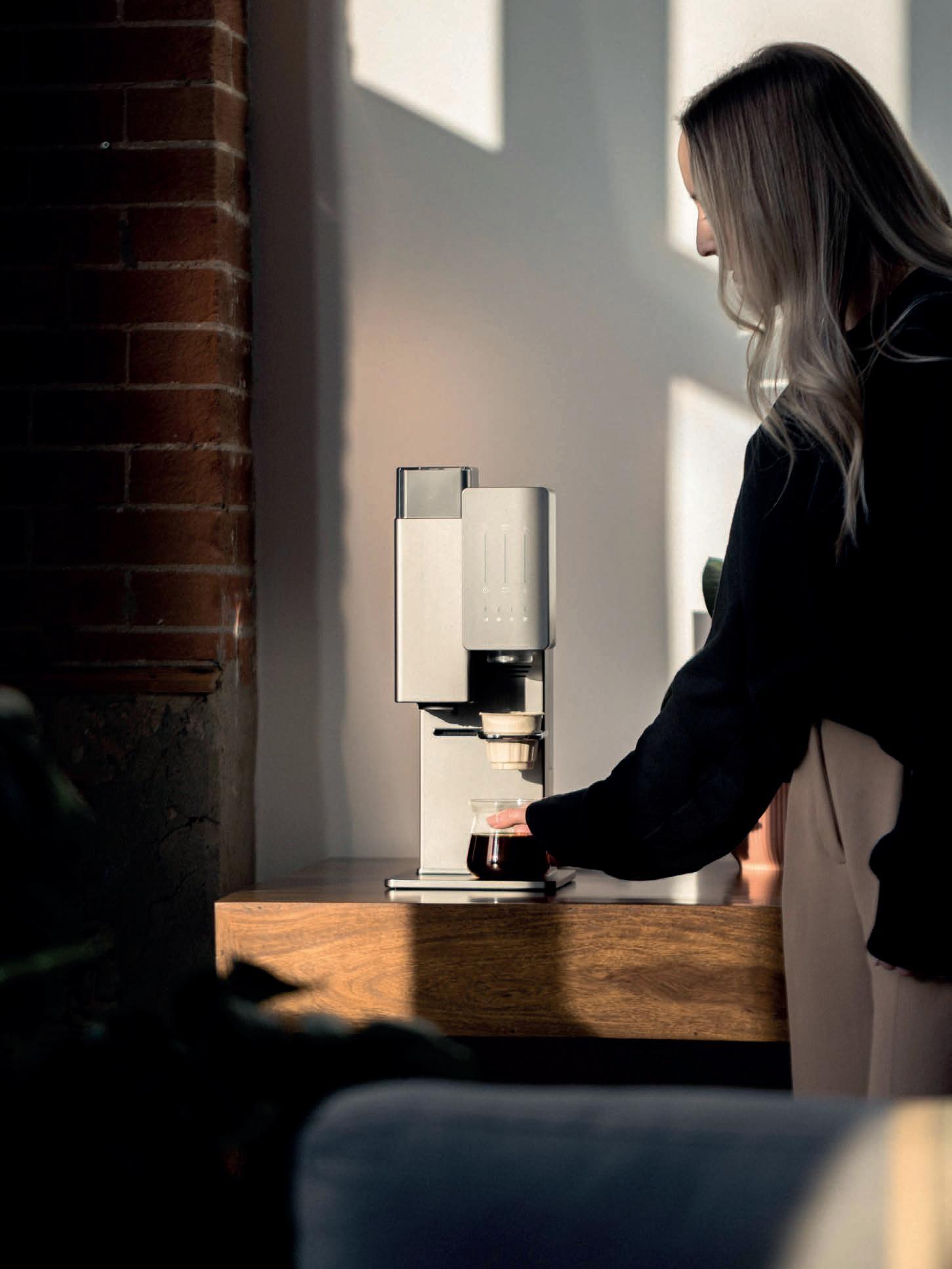



Crafted with the best roasters, savoured one cup at a time. From bean to cup, elevate your coffee-drinking experience today. For wholesale enquiries, please contact us via support@coffeetools.supply or scan the QR code.
The Tone Touch 04 is the latest innovation from Swiss precision brewer manufacturer Tone Kaffeemaschinen AG. The next generation of the Touch boilerless technology, this model is optimised to brew one to four litres of coffee. Available from late 2024, the Touch 04 allows the barista to control agitation, flow rates, and pulse patterns at any stage of brewing – from blooming to turbulence to development – to optimise extraction. Furthermore, new Tone Beverage Manger software enables users to share unlimited recipes via iOS, Android, and Microsoft apps.
For more information, visit baristagroup.com.au
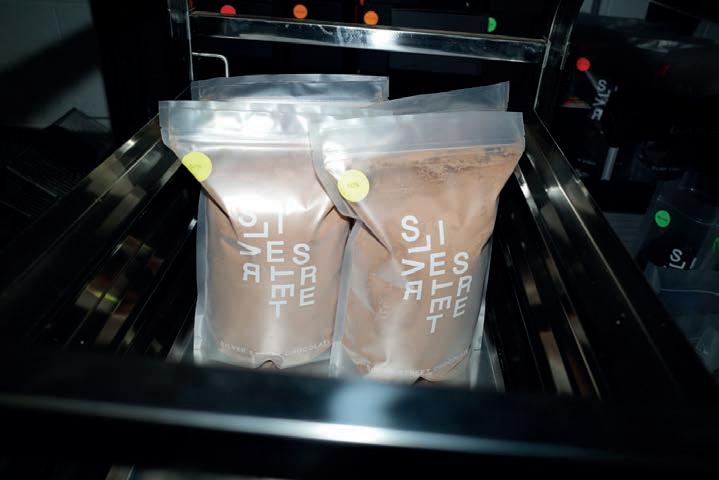

Transparent sourcing is the number one focus for the team at Silver Street Chocolate, and their two 50 per cent cocoa drinking chocolates are prime examples of the care and attention they put into the task. One is sourced from the Kamuri Estate in Papua New Guinea, and the other from Duran, Ecuador. Both products deliver their own unique characteristics from their origins for an unforgettable drinking experience. “We produce products that are thoughtfully curated to the needs of hospitality professionals. With a keen understanding of the unique demands of the industry, we strive to provide a connection to people, product, and place,” say the Silver Street Chocolate team.
For more information, visit silverstreetchocolate.com.au
PureBrew+ is the latest release from Victoria Arduino, designed to elevate the coffee-tasting experience through innovative technology. The single-cup brewer uses native Victoria Arduino systems alongside a new patented double-mesh conical filter to deliver filtered coffee with unique characteristics. Every parameter (dose, volume, and temperature) can be adjusted by choosing one of the various water-pulse profiles (light, medium, and dark) to extract up to 500 millimetres of high-quality coffee, tea, and infusions in less than three minutes, with repeatable and consistent results.
For more information, visit victoriaarduino.com


The Chocolate Society’s premium drinking chocolates and syrups are designed to elevate any café offering. Using quality ingredients, each product is crafted in Australia and packaged in a bright and bold design. Included in the range is the delicious Classic Drinking Chocolate and Premium Drinking Chocolate blends, as well as popular premium syrup flavours Hazelnut, Vanilla, Caramel, and Raw Sugar. Perfect for hot and cold beverages, all the drinking chocolates are gluten-free, dairy-free, and vegan friendly. In addition, the premium syrups are made from natural flavours.
For more information, visit thechocolatesociety.com.au


Arkadia’s Matcha Chai has undergone a makeover, with new packaging but the same great taste it’s known and loved for. Arkadia’s signature selection of chai spices has been expertly blended with high-grade matcha powder in this delicious, creamy drink. As one of the industry’s popular drink trends, matcha is a must have on every menu. Whether served hot or cold, Arkadia Original Matcha Chai can take cafés through the seasons. The team at Arkadia love to pair their Matcha Chai with White Drinking Chocolate to create one of their latest winter recipe innovations.
For more information, visit arkadiabeverages.com.au
With cartel-like tenacity and unshakeable high standards, we control the entire process from farm to cup, ensuring no what ifs. The buck stops with us.
We independently source the finest beans globally, supporting local farmers. Our commitment extends to origin roasting, precise blending, and utmost respect for our customers.
Organised and dedicated, we ensure seamless operations and offer expert barista training.
Like the way we roll? Come join the Cartel family and get your café buzzing!
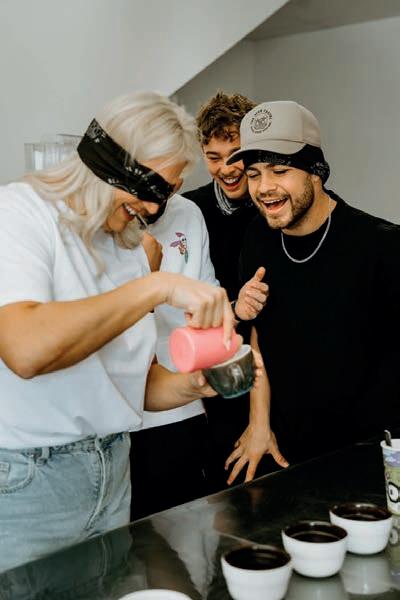

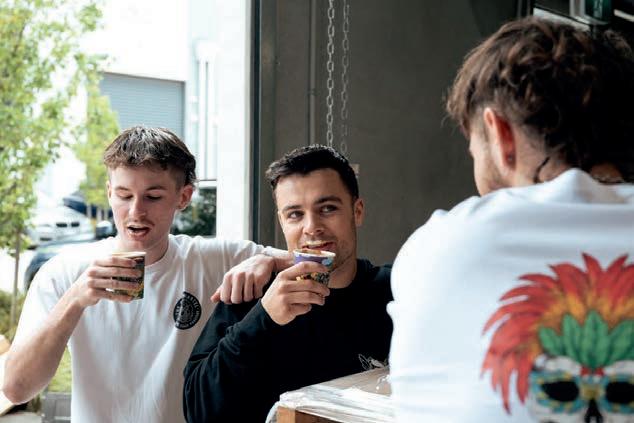



Since taking over the business with his sons in 1991, Brunetti Classico has become a Melbourne institution. Giorgio Angele continues to work in its Carlton kitchen, crafting the same treats he made back home in Rome when he started his career eight decades ago.

In the eighth decade of his career as a pastry chef, Giorgio Angele of iconic Melbourne brand Brunetti Classico was honoured in the 2024 King’s Birthday Honours list. The 91-year-old shares his story and experiences of early Australian café culture.
By Kathryn Lewis
When I arrive at Brunetti Classico on Lygon Street at 10.30 on a Tuesday morning, 91-year-old baker
Giorgio Angele has already been up for five hours – four of those spent in the kitchen of the iconic Melbourne café in which we meet. Three or four days a week he wakes up at around 5.30am, makes himself a black coffee using his trusty mokapot, and heads to work to craft the same traditional Italian cakes and pastries he’s been making for more than 80 years.
His shift should be almost over when I arrive, but I’m tearing him away from preparing almond biscotti and, when I leave an hour later, he retreats to his work bench to start on a batch of nougat. A few months ago, Giorgio was awarded a Medal of the Order for services to the hospitality industry in the King’s Birthday Honours List 2024, yet this recognition has only inspired him to continue doing what he loves and pass on his expertise to the next generation of bakers.
“The Medal of the Order was a big surprise, I didn’t know anything about it until I received it,” says Giorgio.
“We will celebrate when I go to the ceremony as it will also be grandson’s birthday. I still feel good and strong, so I have no plans to retire any time soon. If I stopped, I don’t know what I would do, this is my hobby.”
To many, being the patriarch of family business that has grown to become one of Melbourne’s most loved hospitality institutions is much more than a hobby, but for the nonagenarian, his daily duties in the kitchen haven’t changed a great deal from when he started his career in the 1940s.
Born in Rome, Italy, Giorgio began working at just 10 years old. After spending the mornings at school, he would head to his uncle’s bar in the afternoons, where he would serve aperitivo and coffee to locals and tourists.
“My cousin was one of the best pastry chefs in Rome. At first, I just served at
“I STILL FEEL GOOD AND STRONG, SO I HAVE NO PLANS TO RETIRE ANY TIME SOON. IF I STOPPED, I DON’T KNOW WHAT I’D DO, THIS IS MY HOBBY.”
the bar, but later I learned how to make croissant, cornetti, and other traditional pastries. We didn’t just prepare them for our own bar, we also supplied hotels such as Hotel Santa Chiara [located a cent’s toss from the Trevi Fountain and the Pantheon],” he says.
Giorgio fell in love with baking and, as soon as he could, gave up school to pursue his dream of becoming a pastry chef. He
and his cousin went on to bake for some of the most iconic cafés in Rome, working in the beating heart of the city’s traditional coffee culture.
“Coffee was ingrained in Roman life. We were near lots of offices, so people would come in early to get coffee,” he says.
“There was one café, Sant’Eustachio, where the coffee was so famous they covered up the espresso machine so you couldn’t see how they prepared it. The coffee was like cream.”
After honing his craft for several years, in 1956 Giorgio applied to be a pastry chef for the Italian Olympic team who were heading to Melbourne for the summer games. His application was successful and, despite never leaving Italy before, the 23-year-old embarked on the 29-day voyage to Australia.
While the athletes enjoyed the luxury of air travel, Giorgio and other chefs from across Europe sailed over with the ingredients to ensure their athletes had all the home comforts they could desire.
“It was 1956, so sourcing spaghetti, parmigiano, and other traditional Italian ingredients in Australia wasn’t easy,” he says.
Part of a team of five Italian chefs (one head, two classic, and two pastry), each morning Giorgio would bake fresh pastries for the athletes, as well as sweet treats and cakes to power them through the games.
“The head chef was very good and would let me sneak out to go and watch the football,” he says.
After spending three weeks in the Olympic village and then cooking for guests at Mario’s Restaurant, a popular venue among Melbourne’s Italian community at
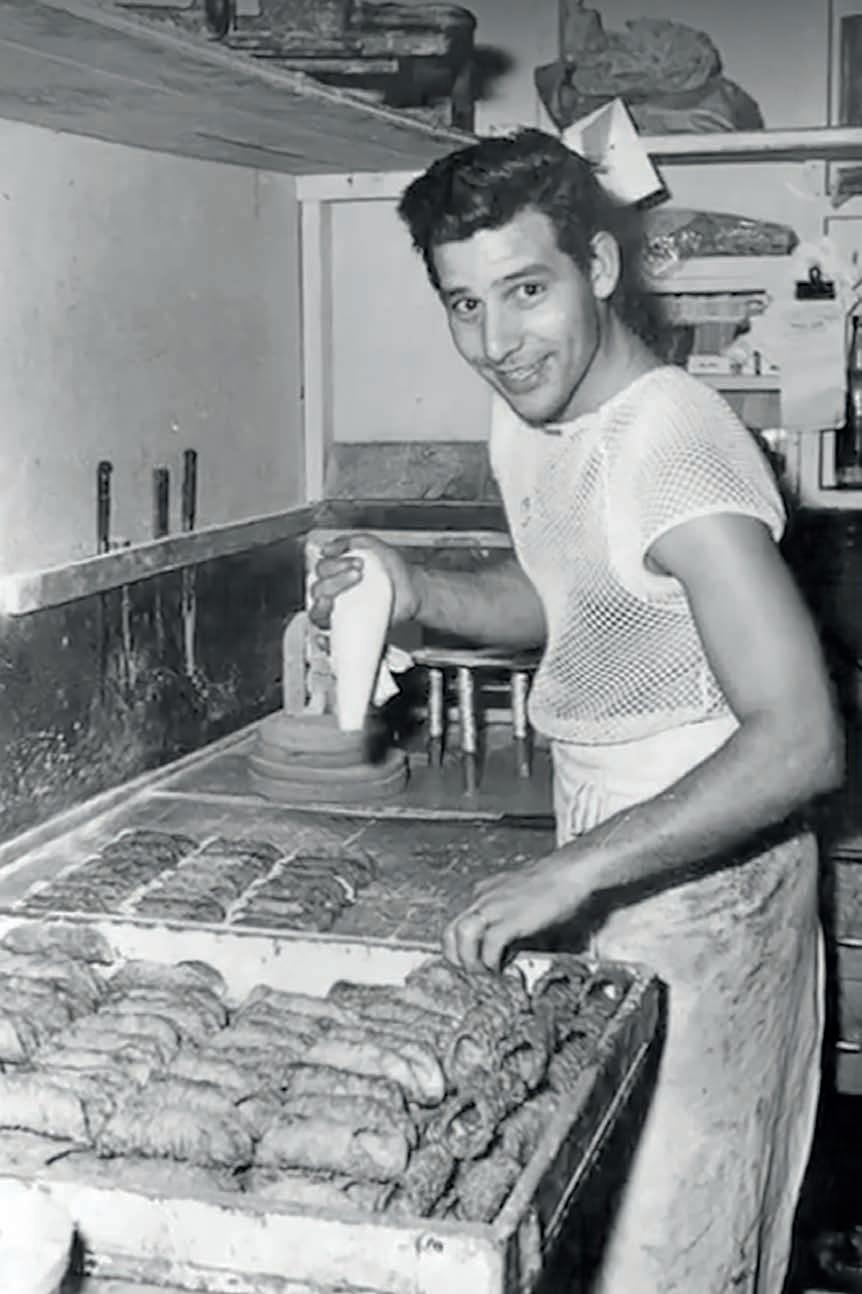
lunch at an Italian restaurant with friends before leaving, he was asked to stay for three more months to run a cake shop in the city.
Three months turned into a year, and then Giorgio got a call about a small cake shop in Melbourne’s Kew suburb that needed a new owner and pastry chef.
“It was a tiny shop in an area with few Italians. I didn’t want to, but at first I had to bake things Australians wanted to eat, such as pies, coconut macaroons, and apple slices,” he says.
“It was very quiet, so I ended up cooking for the other shop owners nearby; I’d cook pasta and spend lunch with the local pharmacist, butcher, and greengrocer.”
To go back to making the kind of cakes
Italian community. After watching the bus drivers pass his window each day, he came up with the idea of catching the empty busses back to Carlton and delivering his classic masterpieces to the Italian businesses in the area.
“I caught the bus to Lygon Street every evening with boxes and boxes of cakes. I did this for three or four months until a friend of mine bought a car and he started doing deliveries for me,” he says.
With many of the Italians who emigrated to Australia in the early 20th century settling in Carlton, Lygon Street was the heart
of Italian coffee culture in Melbourne. Giorgio recalls the cafés and bars being a busy hub of Italian chatter in the afternoons, with people gathering to socialise and drink coffee after work.
“For many of the Italians who didn’t speak much English, this was one of the few places they could come to socialise. There were other venues in the city, but Lygon Street was the central place where people would come to drink coffee and chat,” he says.
“Australians started to embrace this coffee culture too, but it was a slow process because they already had their tradition of drinking tea. As the Australians and Italians started to mix more, the locals embraced my cakes and the tradition of espresso.”
As Giorgio’s cake shop became more popular over the years, he also expanded his operation. He started to sell coffee beans alongside his cakes, choosing to work with Vittoria Coffee, a family-owned business roasting Italian-style coffee in Australia since 1958. He also launched a successful biscuit business.
Not one to rest on his laurels, in the 1960s Giorgio introduced the panettone to the people of Melbourne, a career highlight he is particularly proud of.
“In the 1960s, very few people outside of the Italian community had heard of panettone. It’s a special process using naturalised yeast. I started making them on a small scale, then as they grew in popularity we had to expand,” he says.
Today, for many Melburnians, the Christmas panettone is synonymous with the Brunetti brand. Giorgio says in the early days, his shop at the time was close to the Channel Nine studios, resulting in a stream of celebrities popping in for their holiday panettone.
Despite Brunetti Classico being one of Melbourne’s most well-known hospitality brands today, it was more than 30 years into Giorgio’s career in Australia that he, and his sons, took on the Brunetti operation.
It was first established in 1985 as an authentic pasticceria in Carlton, and in 1991 Giorgio and his family took on the business from the original owners who were moving back to Italy.
“At the time it was just a small shop on Faraday Street; we kept the name because it had built a good reputation,” he says.
Over the past 30 years, Brunetti Classico has gone from strength to strength, opening a spacious venue in

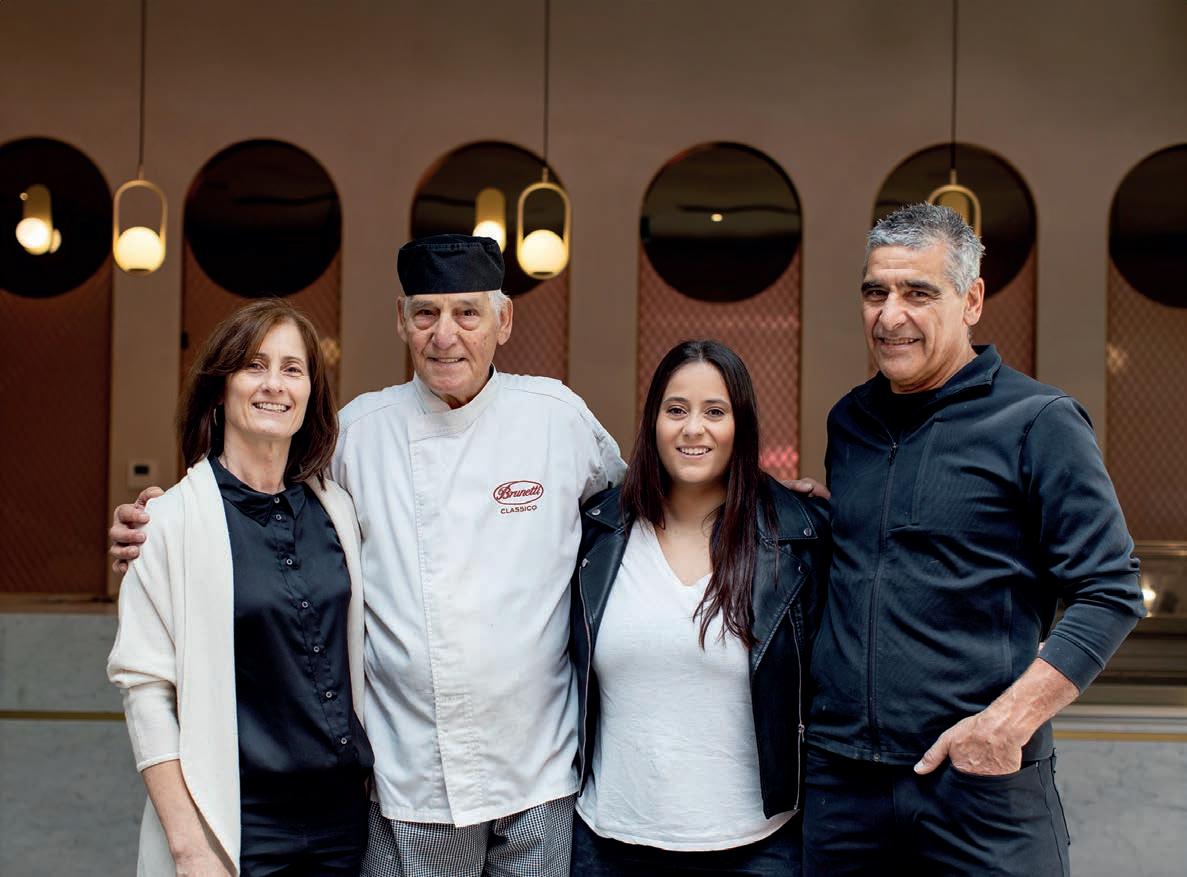
as well as five other venues in the city, including two in Melbourne’s Tullamarine Airport. Creating thousands of cakes each week, it’s hard to believe the kitchen is still located within the Lygon Street
30 chefs, yet he still uses traditional Italian recipes that were passed down to him from his family.
The success of the business, he says, is down to ensuring the quality remains high.
quality of my cakes,” he says.
“We still import many of our ingredients from Italy, and quality will always be part of our philosophy. It means people continue to keep coming back.”

For hot and cold speciality coffees –versatile, robust and reliable.
not capsuled.
The X10 can prepare 35 speciality coffees, nine of which are cold-extracted. This allows it to bring Cold Brews into the professional sector. It is ideal for offices, self-service areas and catering, in settings where up to 100 cups of coffee are prepared every day.The optional connection to the JURA MDB interface unit offers maximum payment system flexibility. And the free JURA Pocket Pilot ensures access to a new generation of mobile payment and management solutions.
Discover the professional fully automatic coffee machines from JURA.
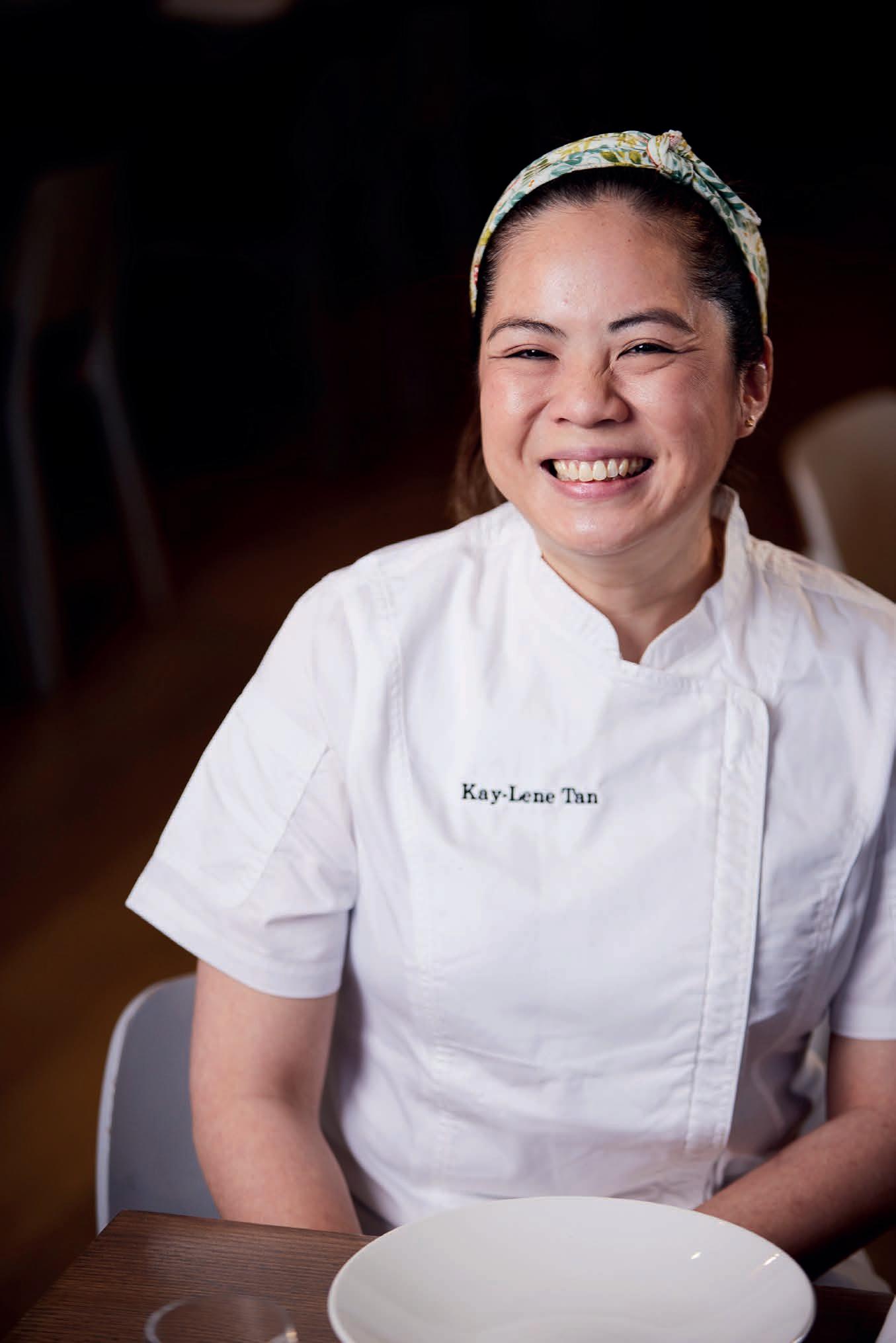
Following her appearance on MasterChef: Dessert Masters, talented pastry chef Kay-Lene Tan has been catapulted into the limelight. Her next project, a new restaurant with celebrated chef Adam D’Sylva, is due to open in November 2024 and will deliver Kay-Lene’s elegant desserts in a relaxed neighbourhood setting.

The MasterChef: Dessert Masters semi-finalist reveals what it was like to compete against her role models and the quarter-life crisis that inspired her to pursue her dream career.
The past year has been exceptionally busy for Kay-Lene Tan. From taking on the role of Head Pastry Chef at The Ritz-Carlton Hotel in Melbourne to being a semi-finalist in the first ever series of MasterChef: Dessert Masters, the talented chef has been catapulted into the limelight – and she’s loving it.
When BeanScene catches up with Kay-Lene in winter 2024, she’s taking a wellearned career break before embarking on an exciting new venture with friend and TV chef Adam D’Sylva. Decca, a European-style neighbourhood restaurant and wine bar, is due to open in the Melbourne suburb of Alphington in November and Kay-Lene will oversee the pastry department.
“Adam has constructed a dedicated pastry bar for me. It’s the first of its kind in Melbourne, so I’m incredibly excited,” she says.
“The plans are all falling into place and it’s going to be a really cool project. Adam and I have a long-established working relationship and he’s been exceptionally generous in trusting me with Decca’s pastry section.”
That relationship started in 2013 when Kay-Lene was hired as the Executive Pastry Chef of Tonka, Adam’s modern-Indian restaurant in the heart of Melbourne’s CBD. After almost six years in the role she was promoted to Head Chef, leading the kitchen team for two years until she made the move to cook among the clouds on the 80th floor of The Ritz-Carlton in early 2023.
Reading the Singaporean chef’s resumé is like flicking through a fine-dining guide to the best restaurants in Melbourne and Singapore. With stints at Joël Robuchon Restaurant, Pollen Singapore, and The European, one would assume Kay-Lene had been in the industry for decades. But, just two years before she landed a job at the world’s most Michelin-star-adorned chef’s restaurant in Singapore, she was on a completely different career path.

At new restaurant Decca, Kay-Lene will have a dedicated pastry bar.
“I was working in documentary production in Singapore until my midtwenties, when I had what I describe as a quarter-life crisis,” Kay-Lene says.
“I’m a big believer in the idea that when you have a job you love, you never work a day in your life. I was seeing all my friends finish their degrees and start these amazing careers and I didn’t feel the same. It spurred me on to figure out what my real passion was.”
Growing up in a Peranakan household, food had always been a huge part of KayLene’s life and something that brought her family together. Inspired she had found her passion, she enrolled in the At-Sunrice GlobalChef Academy in Singapore.
“When I graduated from the Academy, it just so happened Joël Robuchon was opening his flagship restaurant in Singapore. I applied for a job and was placed in the pastry section,” she says.
“I was thrilled to be able to pursue pastry because I love the attention to detail and
precision of the craft. The discipline of it really appeals to me.”
In 2018, Kay-Lene was awarded the Hostplus Hospitality Scholarship, which gave her the invaluable opportunity to travel and do stages in the kitchens of some of the best chefs in the world. During the eightweek paid scholarship, she worked alongside Dominique Crenn at Atelier Crenn in the United States and Ana Roš of Hiša Franko in the Slovenian countryside, both of whom hold three Michelin stars.
Kay-Lene says the experience of working with these female chefs at the peak of their careers has been one of the highlights of hers, and hugely influential.
“In the 15 years I’ve been in the industry, the working dynamic has changed greatly, and one of the goods things is that there are a lot more female chefs now,” she says.
“My biggest struggle earlier in my career was juggling the 90 to 100 hour working weeks. However, over the past 10 years there’s been a much wider understanding

that there needs to be a better work-life balance in hospitality.”
In 2023, Kay-Lene was once again given the opportunity to cook alongside the masters of her trade – this time as a peer.
“Competing on MasterChef: Dessert Masters was the pinnacle of my career so far; truly the most amazing, humbling, terrifying, and stressful experience of my life,” she says.
“To this day, I still can’t believe I was asked to be on the first season. The cast was insane; Adriano Zumbo and Kirsten Tibballs are the godfather and godmother of the Australian pastry scene.”
While the competition was tough, KayLene made it all the way to the semi-finals, placing fourth out of 10 professional pastry chefs, and tying with Kirsten. She says she learnt an incredible amount during the competition, which reaffirmed her love of the creative process.
“One of the beauties of working in hospitality is that everyone’s always going to have their own unique take on a certain ingredient or dish because we bring a lot of our personalities to the plate, as well as our experiences and stories,” she says.
“It’s amazing that you can give 10 pastry chefs the same brief and every single one of them will deliver a different twist on it. It’s what makes going out to eat so interesting.”
Another thing she gained from the show was friendships, and to this day she regularly keeps in touch with the other contestants via a WhatsApp group chat.
“We’ll check in with each other to see how everyone is doing. A few months ago, I met [fellow contestant] Anna Polyviou in
Singapore and took her to all my favourite places to eat,” Kay-Lene says.
It was in Singapore, in her teens, that KayLene fell in love with coffee, a passion which is apparent in this interview, where her first words are: “coffee runs through my blood”.
“My coffee drinking habits started way before I became a chef. When I was studying for my diploma, I spent hours and hours hanging out with my friends in Starbucks, drinking double-shot vanilla lattes. We’d sit there from three o’clock in the afternoon until 10 o’clock at night,” she says.
Her taste for sweetened coffee stems from the traditional kopi coffee served in cafés across Singapore, which Kay-Lene drank with her family. The coffee beans are often roasted with butter and sugar for a rich, dark flavour, and then served with syrupy condensed milk.
Since moving to Melbourne, Kay-Lene has been indoctrinated into Australian coffee culture.
“Melbourne has ruined me. I can’t drink kopi or Starbucks anymore; they’re just too sweet,” she says.
“People in Australia take their coffee very seriously. However, what I’ve noticed recently when I’ve returned home is that Singaporeans who have studied in Australia have introduced a slice of that specialty coffee culture to Singapore.”
As Kay-Lene’s career has progressed and she’s worked at different restaurants across Melbourne, she’s always been quick to find a local coffee spot for those much-needed between-service flat whites.
“When I was working at Tonka, Tom Thumb on Flinders Lane was my go-to.
At The Ritz-Carlton it was Commonplace Coffee Brewers, and at Tarts Anon I got the chance to enjoy Square One Coffee, which is served in the shop,” she says.
With such a penchant for good coffee, it’s not surprising that it features regularly as a flavour in her desserts.
“I enjoy the nuance of the different ways coffee can be roasted, such as in Singapore with the butter and sugar. When I was developing the dessert menu for Coda [another of chef D’Sylva’s restaurants in which Kay-Lene worked], I created a Vietnamese tiramisu, which played on the unique flavour profiles of Vietnamese iced coffee,” she says.
“I also recently did a collaboration with Italian restaurant Al Dente Enoteca, for which I created a coffee-based dessert. It was inspired by one of my core memories as a child of visiting an iconic bakery in Katong with my mum, where we would have a slice of marble cake with a cup of kopi – I can still smell it now. For my dish at Al Dente, I created a marble sponge which I topped with a kopi syrup and mascarpone.”
With a European menu planned for her new venture with Adam in Alphington, there’s a good chance Kay-Lene’s take on the classic tiramisu will be delighting diners in Melbourne again soon.
“Decca is in the suburbs, so it’s going to be a different crowd than the CBD clientele I’m used to,” she says.
“Adam and I both have the same vision to create a neighbourhood restaurant that people will want to come to every day. In terms of pastry, I’m going to be celebrating the classics, but with my own spin.”
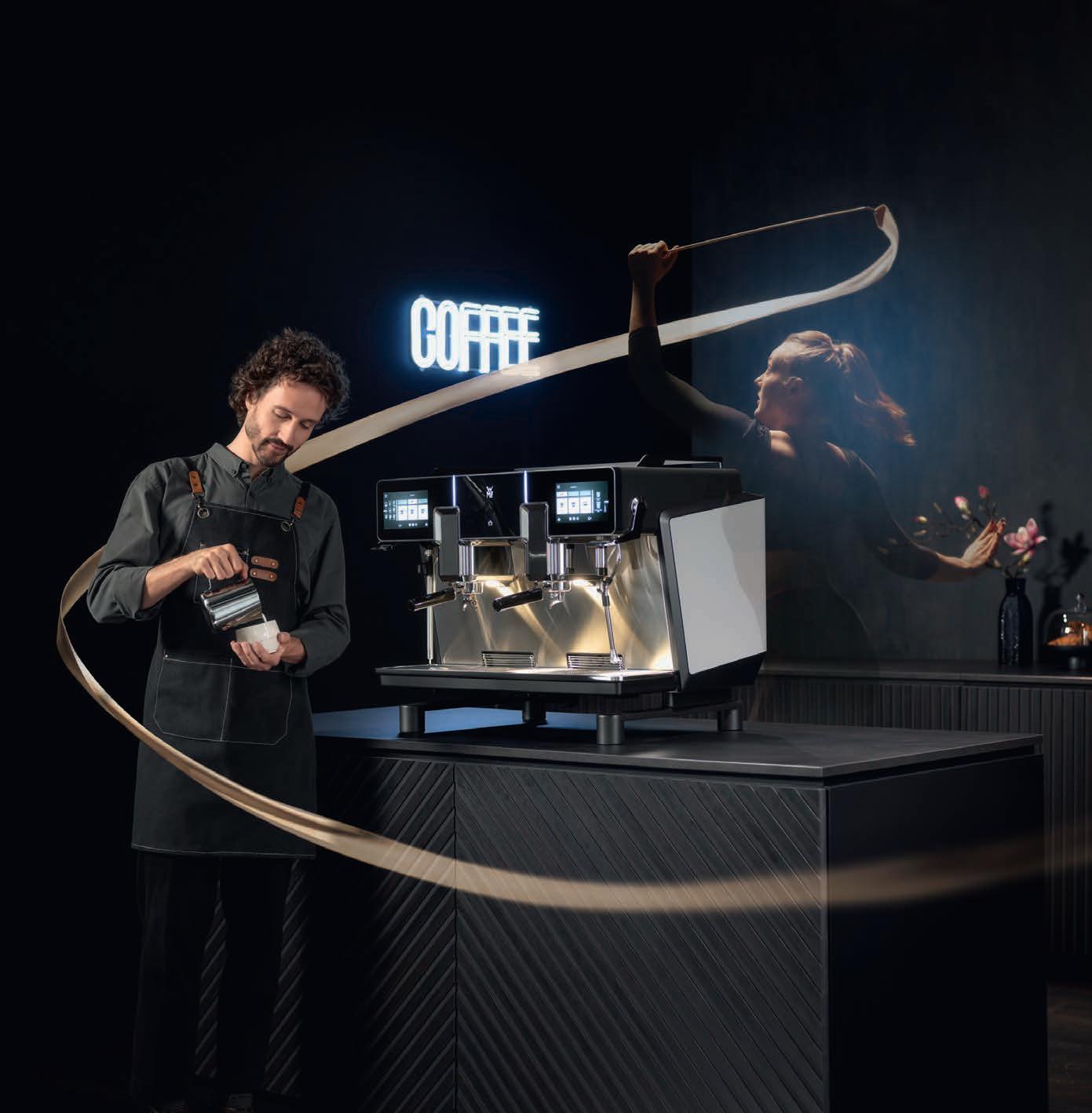


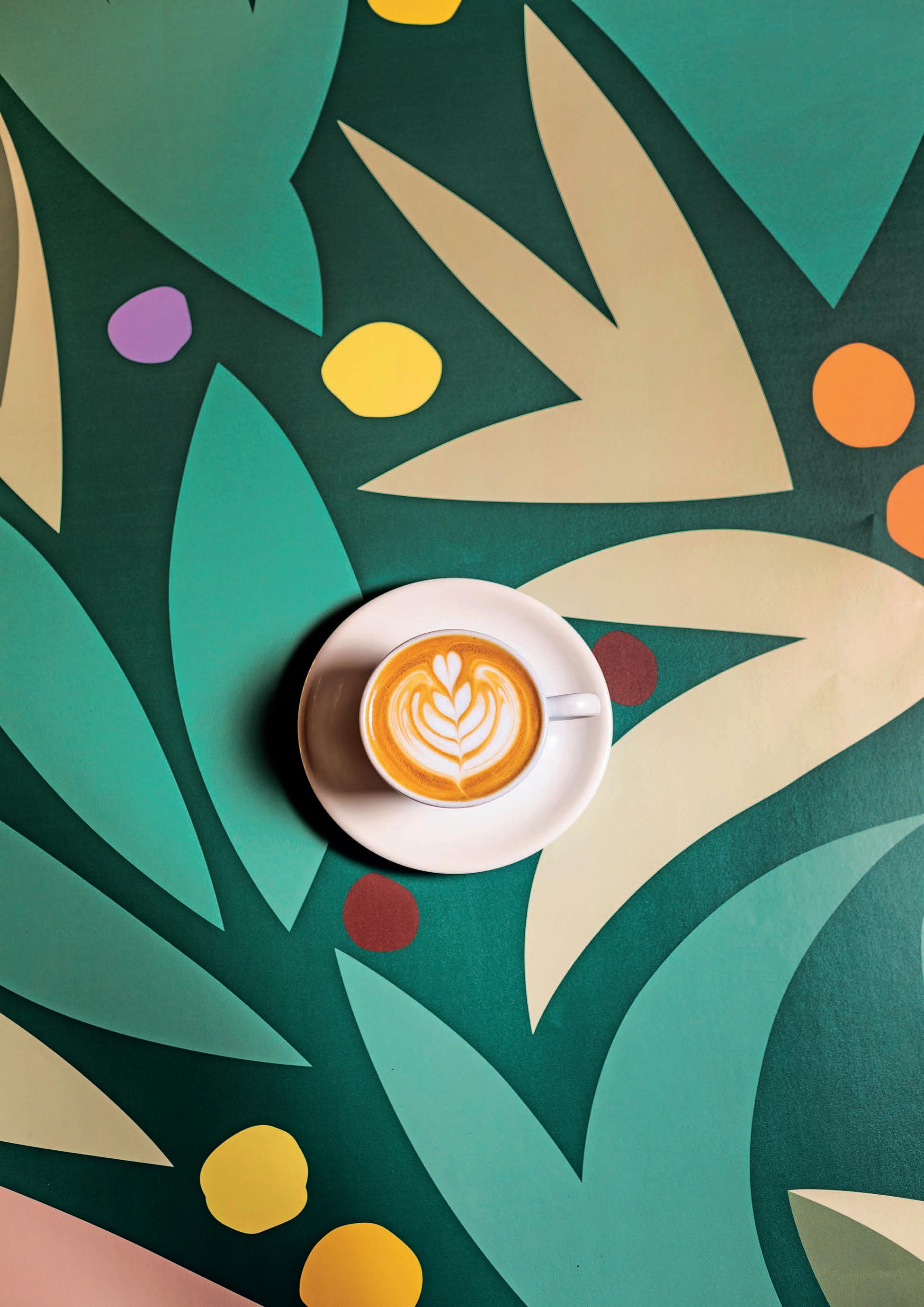
How Lavazza collaborated with artists and tastemakers to develop Mosaic, a new line of premium coffees set to capture Australian palates across the café and restaurant landscape.

For thousands of years, artists have used small fragments of materials to create a bigger picture through the method of mosaic. For the team at Lavazza Australia, this idea of combining multiple elements to piece together a story was the perfect fit for its new project propelled by collaboration and inspired by the natural beauty of Australia.
Over the past two years, the coffee specialists at Lavazza have been working on a collection of blends that capture the spirit of Australia and its unique coffee culture. Named Mosaic in honour of the creative and collaborative process behind it, the unique range marks a new era of Lavazza in the country.
“Lavazza has been in Australia for 50 years, and our coffee is roasted right here in Melbourne, so to celebrate we are releasing a new line that embraces the country’s contemporary coffee community,” says Nick Ferrara, Lavazza Trainer and Ambassador.
“We approached the Mosaic range very differently than any other coffee we’ve launched here previously. We wanted to show that we understand the market and are part of the market, so this line is quintessentially Australian.”
While many of Lavazza’s coffee ranges are sold internationally, Mosaic has been developed exclusively for cafés and restaurants in Australia.
To understand what coffee drinkers in
of coffees on the market. This 360-degree approach included interviews with premium café customers to understand their perceptions of Lavazza, mapping the local coffee market by conducting a series of tastings over 12 months, and inviting consumers to in-depth sensory tastings of existing products.
“We wanted to comprehend what consumers look for in a great coffee, so we invited 100 people, both external and internal, to blind taste our existing blends and competitors’ roasts. We asked them to grade each coffee on strength, bitterness, and sweetness,” says Nick.
“We plotted the results on a graph with Earthy/Chocolaty on one end of the scale, Fruity/Acidic on the other, and Body/Strength as a vertical axis. What we noticed from the results was that, surprisingly, most people only really care about the levels of bitterness and sweetness, and that strength isn’t an important factor.
“As we wanted to cover the whole spectrum of tastes in the Australian market, we used the graph to plot where our three new blends should sit among the most popular parameters. We decided on one at the chocolaty end of the scale, one in the middle, and another towards the fruitier side.”
With taste profiles locked in for the coffees they wanted to create, the team got stuck into the next phase of development: blending. The testing started with cupping eight individual origins to understand their characteristics and flavours, then
“We created a spider chart with markers of Fruity, Floral, Sweet, Nutty, Cocoa, and Biscuit for each blend we wanted to create. We then tried each proposed blend black, with dairy milk, and with a range of alternative milks,” says Nick.
As the team were developing coffees for busy Australian cafés that require a crowd-pleasing blend to appeal to their diverse customers, it was vital that the coffees worked well in various serves and with different types of alternative milks.
Alongside this in-depth research and market comparison, the Lavazza team partnered with three of Australia’s most experienced makers and artists. These artists were selected to provide rich insight and perspective into the Australian palate from their respective disciplines.
Pana Barbounis, chocolatier and pioneer of Pana Organic, challenged conventions and inspired the Lavazza team to explore notes of chocolate, biscuits, and nuts; distiller Carlie Dyer of Starward Whisky shared her innovative approach to blending techniques and understanding flavour; and artist Daimon Downey distilled the creativity of the project and the Australian coffee scene into Mosaic’s striking packaging and branding.
“Working alongside Daimon, we approached the artistic concept of mosaic through a contemporary Australian lens, while also ensuring we stayed true to


Lavazza commissioned Daimon to craft three pieces of original artwork, one for each of the new blends in the Mosaic collection. His brief was to weave a distinctly Australian narrative and highlight the country’s contrasting landscapes.
The result was three beautiful prints, inspired by the art of mosaic. The first reflects the country’s coastline and features blue hues; the second is inspired by the desert with warm tones of red and orange signifying the outback’s vibrant contrasts; and the third references Australia’s rainforests in its soothing green tones.
Each print was matched with one of the team’s winning blends: Tidal, Ochre, and Retreat.
According to Nick and Peter, Tidal is the blend that sits at the fruitier end of the scale. Made up of 100 per cent Arabica from South America and Papua New Guinea, it’s medium roasted to elevate its sweetness and distinct flavours of plum and green apple.
Ochre is described as the ultimate crowd-pleaser. Straddling the line between chocolatey and fruity, the blend of Brazilian, Ethiopian, and Colombian beans delivers fruity notes without the acidity. The Lavazza
team define it as “smooth yet robust, with notes of Pink Lady apples and nuts, with a chocolate aftertaste”.
Completing the trio is Retreat, representing the full-bodied end of the scale. Designed for the milk-based coffee drinker, the mix of high-quality Arabica and Robusta promises low acidity and notes of chocolate, nuts, toffee, and malt.
When it’s launched in August 2024, the Mosaic collection of blends will be joined by a rotating seasonal single origin. While all the coffees are roasted and packed at the roastery in Melbourne, to ensure standards remain high, Lavazza Australia follows the European Union’s strict protocols and requirement.
“These protocols aren’t mandatory in Australia, but we have chosen to continue with the same high standards upheld in Europe. Each product, therefore, goes through 11 quality-assurance steps,” says Nick.
Eager to ensure the coffee continues to taste good long after it is roasted, the team invests heavily in the quality of Lavazza’s packaging. Before the beans are packaged, they are flushed with nitrogen to remove oxygen (which can cause coffee to go stale) and carbon dioxide from the silos in which
they are stored to help extend the shelf life of the product. To keep the coffee tasting as fresh as possible for as long as possible, the bags feature a one-way valve to ensure carbon dioxide can escape without oxygen getting in.
Nick, Peter, and the Lavazza team can’t wait to share the new Mosaic range with coffee lovers across Australia. The coffees will be available in quality cafes across the country from August 2024, with an industry launch party at Starward Distillery in Melbourne to mark the occasion.
“We were determined to bring something fresh and innovative to the industry, and that required almost two years of research and development to create this new portfolio that truly delivers to the Australian coffee palate,” says Peter.
“We want to ensure this brand comes alive and we can’t wait to see people enjoy it. There’s an authentic story behind each coffee that captures the personality of Australia.”
For more information, visit mosaiclavazza.com.au

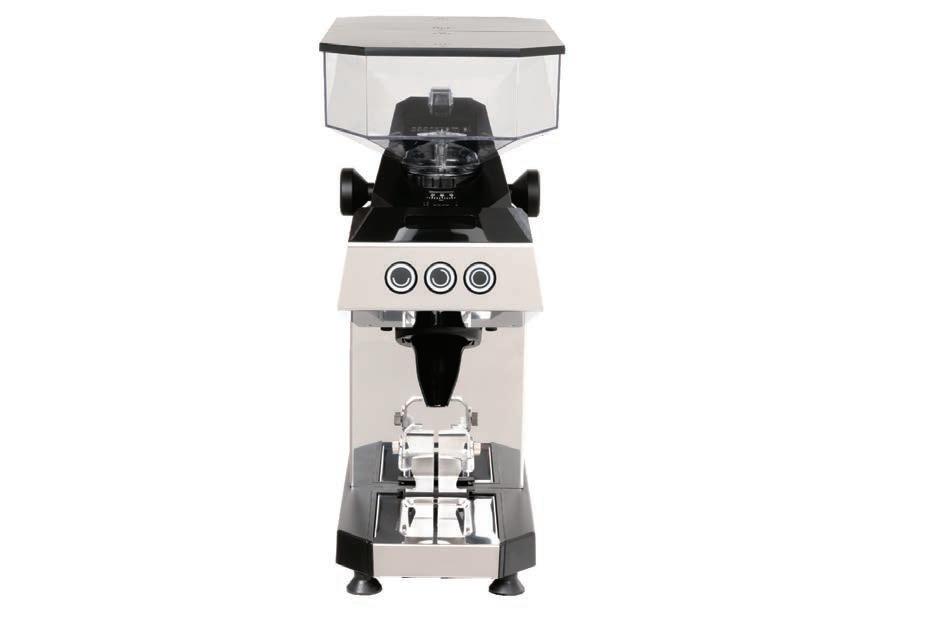


Recent interest in Asia has seen a rise in Australian coffee roasters heading north to explore new markets, but for Single O, Japan has been part of its operation for over a decade. CEO Mike Brabant shares the roaster’s learnings and challenges.
Long-standing Surry Hills
roaster Single O has always gone about business differently. From the company’s origins in the early 2000s, founders Emma and Dion Cohen have forged their own path instead of trailing the pack.
It’s this desire to pioneer trends rather than follow them that led the roaster to Asia in 2014, a decade before the current boom in interest. While its venues in Japan – of which there are now three: a roastery and café in Ryogoku, a coffee shop in Hamacho, and a new coffee bar in Shibuya which opened in July 2024 – have been successful, it was a chance encounter that inspired Single O to enter the Asian market.
“This is one of my favourite stories, and it all starts with one person,” says Single O CEO Mike Brabant.
“In 2008, Yu Yamamoto joined us on an overseas exchange from Japan, initially working as a dishwasher at our Surry Hills retail store. One day he tried an espresso and fell in love with it, and from there he worked in the café as a barista, going on to become a roaster and eventually a Q Grader.”
Mike believes that Yu, and his wife Mamiko, had possessed a desire to take Single O to Japan for some time. Despite the fact the company had no masterful strategy to expand to Asia, he says the Japanese market felt like a natural fit for the brand.
“We had the right people, Yu and Mamiko, who we trusted and knew understood the brand and the level of quality we strive for, but there were also supporting factors that made it the right time and place for us to expand,” he says.
“At the time [2014], specialty was starting to grow in Japan, a country known for its focus on quality. We could see the parallels to the scene in Sydney in 2003 when Single O started: it felt like there was excitement about specialty coffee but not a lot of it around.”
Taking the leap also made commercial sense, thanks to a few key customers, such as Bills, which had recently laid roots in Japan and wanted a roaster in the country that they knew could deliver consistent quality. The original approach for the roaster, therefore, was to grow alongside its wholesale partners in Japan as the specialty
scene matured, just like it did in Australia.
“Working with Yu and Mamiko, we found a great spot in an up-and-coming area of east Tokyo for our roastworks. We installed a 22 kilogram UG Probat roaster and started roasting ” says Mike.
Opening a retail store attached to its roastworks, which hosted a tasting bar at weekends, enabled the Single O Japan team to make connections with the local community and build a reputation for its quality with wholesale partners.
“The vision was always to take the Australian independent specialty café culture to Japan, and people loved it,” says Mike.
“The tasting bar was pretty small, we started off with just a two-group espresso machine, and we’d serve a couple hundred customers a day over the weekend, and it gradually grew.”
In 2021, despite global lockdowns and restrictions, Single O opened its second venue in Japan in Hamacho. Located close to the original roastworks, the Tokyo flagship was the brand’s first dedicated café in the country. It was Single O’s first

venue to house free-pour batch on tap, serving a rotation of washed and natural single origins. This was served alongside its signature blend as espresso and a menu of eats blending Aussie and Japanese cuisines.
Riding on the success of the flagship and responding to its growing customer base, in April 2024 the team moved the original roastworks to a roomier venue nearby with space for an on-site café, quality-control room, and training space for wholesale partners. Hot on its heels came Single O Shibuya, a coffee bar in the busy district, in July the same year. Based on its Sideshow takeaway bar in Surry Hills, the latest venue brings specialty coffee to the streets, with espresso service and self-serve free-pour batch taps serving rotating origins and blends in one of the busiest places on Earth.
With a decade of experience in the country, Mike says there have been a few ‘aha’ moments along the way, one of which was Japan’s preference for filter coffee.
“This is one of the main differences between the Australian and Japanese markets. We introduced our free-pour batch taps at our venues in Japan and 40 to 50 per cent of the coffee we serve there comes through these machines, which has greatly influenced our model for growth and reaffirmed that Japan loves to taste specialty
origin characteristics,” he says.
“It’s important to stress, however, that looking at the Asian market as a whole is a very broad perspective. While Japan is highly driven towards filter, in South Korea the espresso market is pumping.”
Convenience is another focus of the Japanese market that has influenced Single O’s venues.
“There are convenience stores on every corner, and hot and cold coffee from vending machines everywhere, so immediate access to products is essential. We’ve focused on blending that desire for convenience with quality, and the batch tap technology allows us to serve coffee in 15 seconds,” says Mike.
The Single O roasters in Japan roast the same signature blends and single origins as those in the original roastworks in Sydney.
“People who have visited our venues in both Japan and Australia will often joke that the coffee roasted in one country tastes better than the other, but we like to keep the flavour profiles consistent. We’re trying to express a specialty Australian flat white – and in Japan people are looking for that authentic Aussie experience,” says Mike.
While Single O’s expansion into Japan has been largely successful, Mike admits there have been a few bumps in the road.
“Navigating language and cultural barriers are an obvious challenge. There are times I’ve been in meetings with a translator and it’s been tricky to follow, or not understood how the region works, but that’s part of the journey” he says.
“It’s all too easy to dwell on these things. If you want to be operating overseas, you need to flip that around and embrace the differences and commonalities, and learn to adapt. You need to have a passion and desire to appreciate the nuances in any market to be successful there.”
Mike stresses how lucky the team have been to have Yu and Mamiko spearheading the project in Japan.
“We couldn’t have done it without them. Yu is a great roaster and thoroughly ingrained in the industry as a Cup of Excellence and Brewers Cup judge,” he says.
As for what’s next for Single O in Asia, Mike and the team already have their sights set on new venues in the region, although their lips are sealed for the moment.
“The main thing for us is to keep delivering quality and heart at home in Australia, and the doors tend to open from there,” says Mike
For more information, visit singleo.com.au
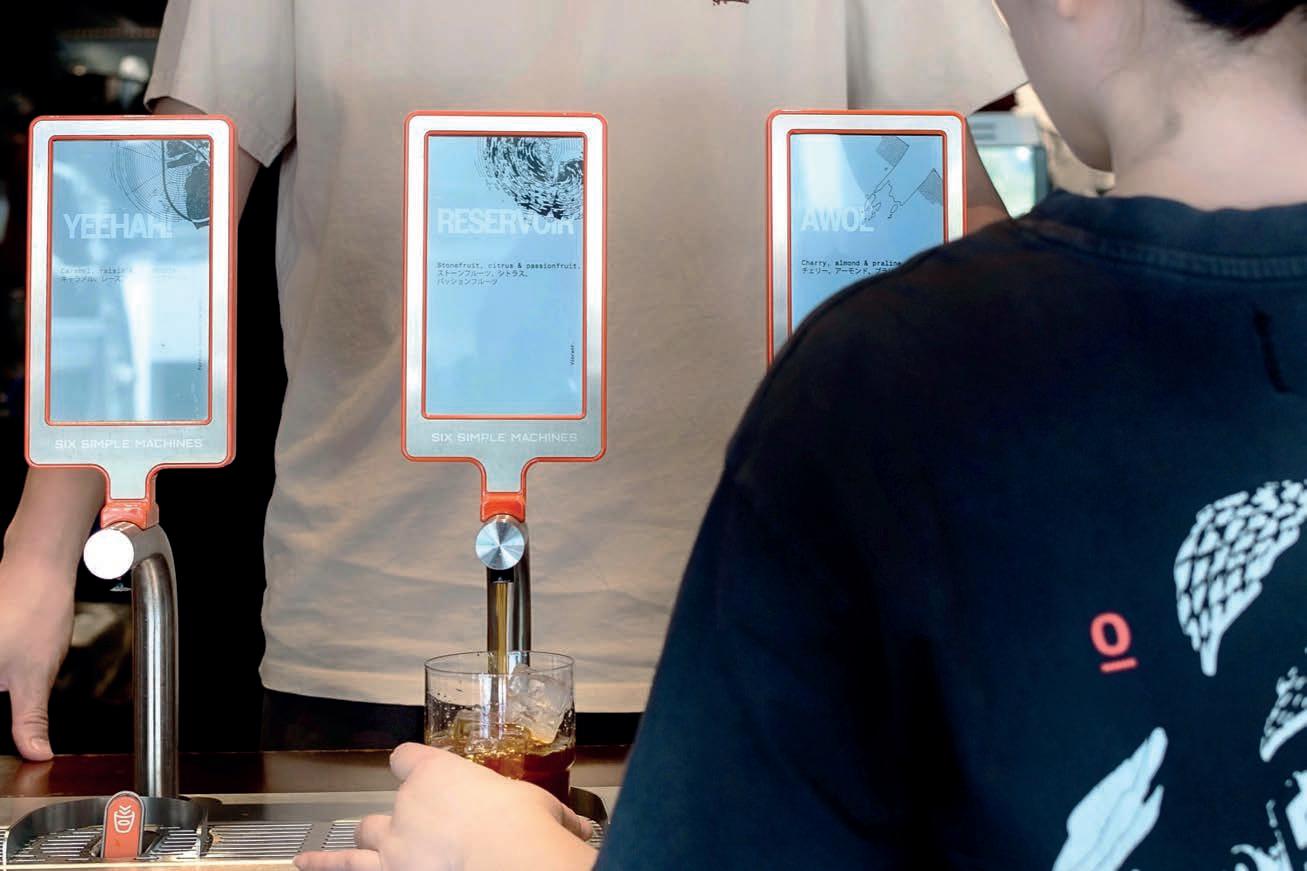

This means happier baristas, happier customers, and improved productivity.
Launching a new café in a new suburb can be a challenge, but as discovers, the key for Brewmance was immersing in the local community and tapping into Will & Co’s creative energy.

Cafés are often the heart of a community: a place for neighbours to catch up in the queue, parents to take a moment for themselves after the school run, and friends to debrief over brunch.
When long-term friends, baristas, and business partners Davide Crespi and Hoky Michael were looking to open a new café in the Sydney suburb of Crows Nest in 2022, they knew integrating into the local community was going to be crucial to the success of their venture.
“Hoky and I had been in business together for five years and already had another café in Neutral Bay. We’d had our eye on Crows Nest as an up-and-coming area and had found a great venue on the main street that was the perfect fit for the cool and vibey café we had in mind,” says Davide.
“Both of us come from small places in our home countries [Hoky in Indonesia, Davide in Italy], so creating a sense of community was really important to us. We wanted Brewmance to feel like home for the people of Crows Nest – somewhere the barista knows their name and they can see a friendly, familiar face.”
To engage with the local community, Davide and Hoky needed a draw. Noticing a gap in the market for a contemporary coffee shop serving specialty-grade beans, the duo got in touch with Bondi roaster Will & Co.
“From the moment we opened Brewmance, working with the team at Will & Co was a no-brainer,” says Davide.
“Not only do their values align with ours, but they also understand the energy we want to bring to our project – and their coffee is beautiful.”
Will & Co’s Eight-O-Eight blend was the coffee that won over Davide and Hoky, and to this day keeps regulars coming through Brewmance’s doors. The roaster also provides a rotating single-origin option to appeal to the more adventurous customers who want to try unique coffees and learn about different origins and processing methods.
In addition to helping Davide and Hoky find the perfect coffee for their venue, the Will & Co team also shared their creative vision to get the café noticed.
“When we were getting ready to launch, they went above and beyond to help us with

clean and contemporary look. Since we’ve been working together, the team have helped us with designs and visuals to attract attention to the café, which blends seamlessly with our own branding.”
Those who visit the café can’t miss the floor-to-ceiling mural telling Hoky and Davide’s story, which was commissioned by Will & Co and completed by a local artist.
“We worked with our designer to create our logo, but the wall mural was a collaborative project with the Will & Co team. They were super responsive to our ideas and requests, and we absolutely love
relationship they’ve forged with Will & Co.
“Crows Nest has a really strong community feel and it’s great to be a part of that. While the café has a cool vibe, it’s not at all pretentious: we welcome people from all walks of life,” says Davide.
“We love the interaction we have with our regulars. One of the things that makes us unique is that we like to personalise the latte art to each customer. We’ll scribble notes into their drink to make them smile –they love it as much as the coffee.”
For more information, visit willandco.com.au
A new generation of equipment embracing automation and efficiency signals the next era of innovation in La Marzocco’s century-long history.
La Marzocco is one of the coffee industry’s most recognisable brands: synonymous with both traditional Italian espresso culture and the upper echelons of the contemporary craft. The Florencebased company’s coffee machines have furnished the brand with industry clout, yet some of its latest innovations focus on the steps before and after espresso extraction.
“La Marzocco has around 100 years of experience in the traditional espresso segment, and in that time we’ve developed a series of technologies that we’ve built into our products to ensure consistency, reliability, and value,” says Aric Forbing, La Marzocco Technical Product Manager.
“We have always worked to create the world’s best espresso machines, and in the process built up a group of world-class experts who can spur development of new and exciting things.”
Two of the “exciting things” La Marzocco has released recently are the Wally Milk automatic milk steamer and the Swan grinder. Developed in response to customers’ need to increase productivity and improve workflow, both products incorporate the research and development team’s latest advancements in automation.
“The Wally Milk is a great example of how new products and technologies are driven by our customers. A lot of cafés told us milk was their choke point during busy periods, so we developed the automatic milk steamer to not only speed up the process but also provide an additional steam wand alongside the coffee machine,” says Aric.
While the team were driven to create a milk system that would alleviate bottlenecks at the espresso machine, the solution prioritises quality and safety as well as efficiency. The Wally Milk not only helps baristas move orders along but also delivers a premium output without the user having to handle hot jugs or steam wands.
“There’s a series of advancements within the Wally Milk that enables it to steam milk just like a barista would,” says Aric.
“First off, there are sensors to detect the size of the pitcher being used, a tilting platform to ensure it’s at the correct angle, and a temperature sensor which constantly monitors the temperature of the milk.
“At the top of the machine is a robotically controlled steam wand with a vortex tip to move the milk to ensure it’s uniform. Finally, there is a time-of-flight
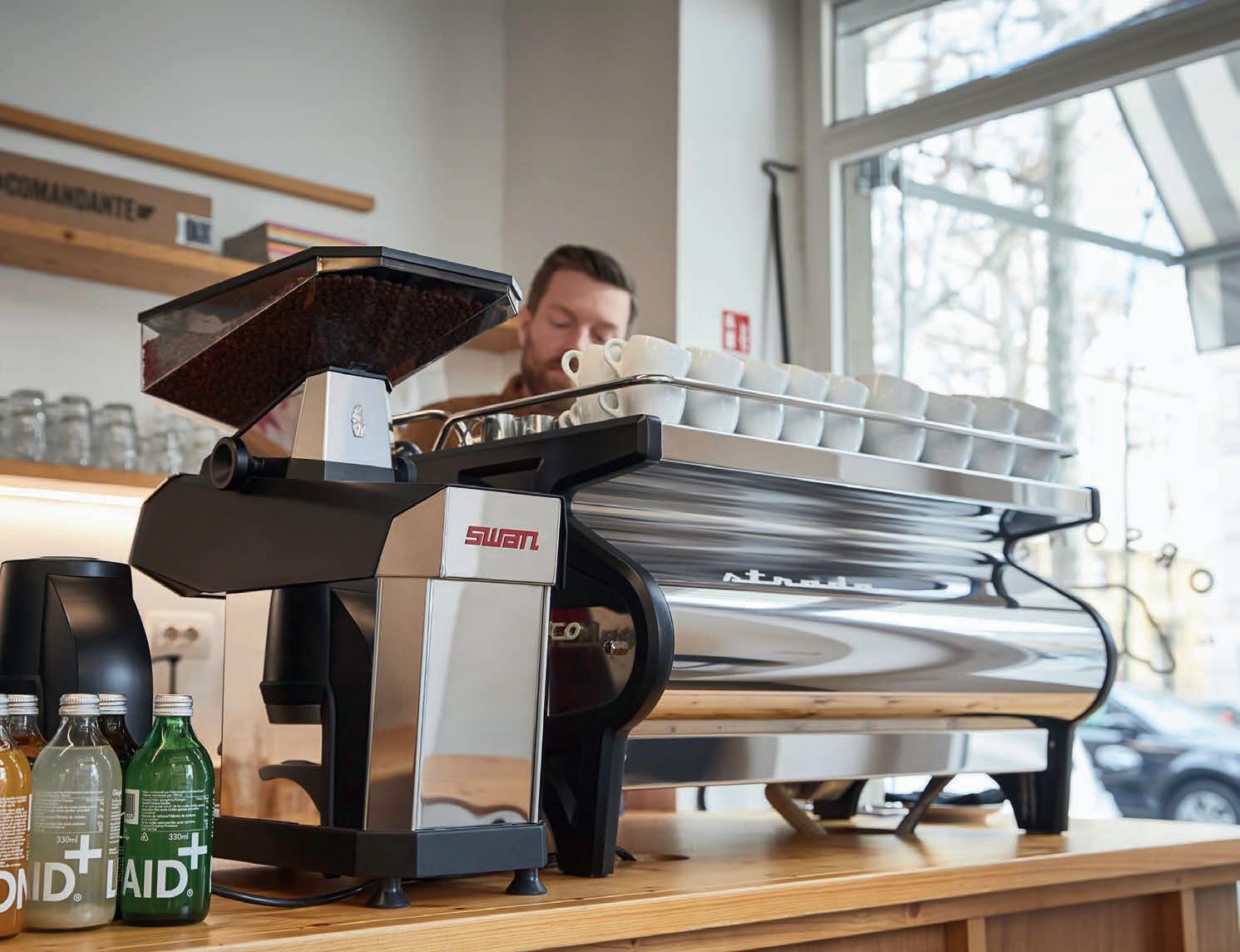

sensor which measures the amount of milk in the pitcher – this is really important because the machine doesn’t have eyes or ears to assess how the milk is stretching.”
With so many parameters measured constantly, Aric says all these technologies enable the machine to have ultimate control of the finished product, saving the barista time without compromising on quality.
The development of the Swan grinder, on the other hand, was driven by the team’s quest for a reliable grind output throughout the day, addressing the common café issue of consistency.
“We’ve put a really cool piece of
technology into the Swan that removes static from the coffee grounds, allowing them to fall directly from the burrs straight into the portafilter. This solves the issue of grounds sticking to internal surfaces of the grinder, therefore almost completely eliminating retention and producing some of the most beautiful coffee to come out of a coffee grinder,” Aric says.
The engineering team at La Marzocco custom-designed 83-millimetre burrs for the Swan to ensure they’re as efficient as possible, even in busy periods.
“The less the burrs need to spin, the less friction is produced, which means less heat

is generated. This results in less variance in flavour as the volume of coffee through the grinder increases. Simply put, the Swan’s burrs increase consistency,” he says.
Since the first La Marzocco espresso machine was released in 1939, designforward aesthetics has been a pillar of the brand. While the products continue to advance, Head of Design Stefano Della Pietra, who was mentored by master craftsman and La Marzocco visionary Piero Bambi, ensures new releases remain true to company tradition and sit within the wider family of machines.
“The Swan has the same interface as the classic Linea PB and KB90 machines, and has the same three buttons. It feels at home next to the machines,” says Aric.
According to Brydon Price, National Sales Manager of La Marzocco Australia, the company has a long tradition of pushing innovation across the whole café bar, not just the espresso machine, which was spearheaded by Piero’s nephews and company Founders, Giuseppe and Bruno Bambi.
“Innovation has always been at the forefront of what sets La Marzocco apart. This has been fundamental not just in
responding to the market but supporting its evolution. When the Bambi brothers started the company in 1927, they designed the entire espresso bar – they made the whole bench as well as the machines that went on it,” he says.
“Realistically, it wasn’t until 30 years ago with the release of the Linea Classic and the subsequent explosion of specialty coffee that La Marzocco became known as an espresso machine manufacturer on a truly global scale.”
Brydon highlights the Swift grinder, released in 2000, as an example of previous La Marzocco innovation in grinding technology, pushing boundaries with its dual hoppers and automated tamping and dosing. Today, he says the brand’s new innovations, such as the Wally Milk and Swan, are doing exceedingly well in the Australian market because they’re meeting the demands of the audience.
“The response of the local market to the Wally Milk has been very strong, yet is still only a fraction of its potential,” he says.
“Our volume of milk-based drinks and the expected consistent standards from every size and style of café is unique to Australia, and well suited to Wally Milk,
engineering team at La
custom-designed 83-millimetre burrs for the Swan grinder.
which proves its value for café owners and roasters alike.”
The Australian market has embraced the Wally Milk unlike any other, which is something Brydon puts down to the discerning nature of the country’s coffee community.
“Australian café owners and roasters are very quick to embrace new innovation in support of improvement and point of difference. It is also a vocal market when a product does not live up to expectations, so success for equipment such as the Wally Milk and the Swan is seen by international markets as a strong endorsement,” he says.
As for the future of La Marzocco, both Brydon and Aric see innovation as a driving force behind the iconic brand.
“Going forward, we will continue to embrace our heritage and progression by refreshing current models while innovating new products and exploring new markets,” says Brydon.
Both the Wally Milk and Swan are now available to experience at La Marzocco’s Melbourne and Sydney showrooms.
For more information, visit au.lamarzocco.com


How Riverina Fresh is using technology to drive sustainability and ensure consistent quality of its Australian dairy products for its café partners across the country.
Since it started supplying fresh milk to Australians in 1922, Riverina Fresh has endeavoured to have a positive impact on the communities with which it engages. Over a century later, that aim is still part of the company’s core ethos and has recently resulted in a series of innovations at its production facility in Wagga Wagga, New South Wales.
“Impact is one of our key values. Put simply, that means we care for today and we care about tomorrow,” says Riverina Fresh Executive Chairman and CEO Craig Shapiro.
“That mindset is ingrained across our entire business – from our manufacturing facilities right through to our end customers, many of which are cafes and other hospitality businesses.”
In fact, Riverina Fresh’s commitment to producing quality, sustainable dairy products extends right back to the farm gate. The team work closely with a small group of dairy farmers in the Riverina region to ensure milk standards remain as high as possible.
Like many businesses, Riverina Fresh is focused on how it can play a positive role in working towards the global goal of hitting net zero by 2050. Craig and the team constantly assess each part of their lengthy supply chain to see where opportunities exist. They have already made big changes such as installing 1300 square metres of solar panels at the Wagga Wagga factory and introducing new initiatives to minimise waste.
“There’s no silver bullet for businesses working towards net zero,” says Craig.
“Realistically, it requires small incremental changes over time. Something we’re particularly interested in is creating a circular economy to reutilise waste wherever possible.”
One such example is the company’s ongoing commitment to reducing water consumption and minimising the waste that goes into council drainage systems. The waste from the factory passes through a Dissolved Air Flotation plant, removing all the solids that would otherwise go down the drain. These solids then go to a compost facility and a pig farm where they’re recycled as feed.
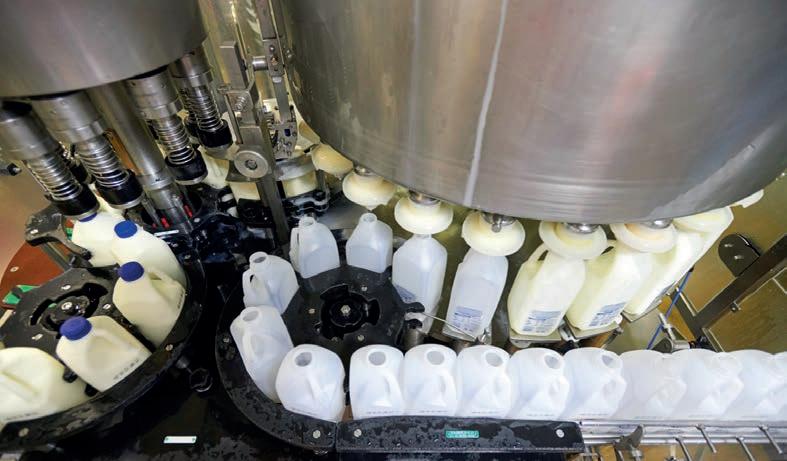
The team are also encouraging their café partners to return empty plastic milk containers when new ones are delivered, so they can be crushed and sent off to Kurrajong Recycling, a local business that supports disability employment.
“We try not to approach sustainability only through the lens of our own facilities: we also focus on the sustainability of our regional communities and work closely with other local businesses,” says Craig.
Alongside this emphasis on creating a circular economy, the Riverina Fresh team are exploring ways they can use technology to make the manufacturing facility more efficient and, in turn, more sustainable. An example of this is the implementation of IoT (Internet of Things) technology.
“Instead of getting rid of old equipment, we looked at ways of extending the life of existing machinery. By introducing IoT, we’ve been able to extract data from older machines and run the factory more efficiently,” says Craig.
“By running more efficiently we reduce our energy consumption and by upgrading older equipment we minimise waste disposal. Both outcomes have a positive sustainable benefit.”
IoT is a cloud-based system that reads data from sensors placed on equipment. Surprisingly, even older equipment has data running through it, but before using the IoT system this wasn’t automatically
captured at the Riverina Fresh factory. With the new system in place, the team can now read this data and use it to monitor how the equipment is running in real time and see where bottlenecks occur.
The bottle filler is one such piece of equipment that’s been fitted out with IoT technology. Being able to measure the number of bottles passing through it each hour allows the team to calculate the capacity at which it’s running compared with its maximum speed.
“It’s important to be able to access this sort of data to ensure the machines are running smoothly so we know there’s no compromise on the quality of the milk,” says Craig.
“That’s our ultimate goal. We want our milk to be of the highest possible quality when it meets the coffee in the cup – from the farm, through the factory and delivery, until it arrives at the café.”
This focus on quality and sustainability is shared by many of Riverina Fresh’s café partners, which Craig says have similar values around impact and sustainable farming practices.
“What we’re doing with our milk is aligned with the values of our key coffee roaster and café partners, who are conscious of where and how their beans are grown,” he says.
For more information, visit riverinafresh.com.au
The Bean Cartel Co-Founder Alison Visser on being the ‘silent partner’, surviving business loss and an ensuing mental health crisis, and why having a female voice is essential for independent businesses.
In the background of almost every family business is a key character who prefers to stay out of the limelight but is the constant that keeps the company afloat. At The Bean Cartel, that role falls to Alison Visser, Co-Founder and wife of Stacy Visser who oversees the daily running of the specialty roaster.
While many people in the Melbourne coffee scene will recognise Stacy, Alison takes a more behind-the-scenes stance. That’s not to say her work isn’t essential: she spends hours every day ensuring each client or potential customer receives a personal response to queries and messages. Plus, she painstakingly plans social media posts and marketing materials to share The Bean Cartel’s latest updates and grow the brand.
“We treat each member of our team and our clients like they’re an extension of our own family. We’re heavily invested in their success,” says Alison.
“Because of what Stacy and I went through, I feel like we have a different level of respect and care. You need to show empathy in this industry, which we have in abundance.”
Alison is referring to the difficult few years when The Bean Cartel was in its infancy. When the couple relocated from Adelaide to Melbourne to start an office coffee company in 2009, the life and businesses they’d built in South Australia were beginning to crumble. They lost everything – their house, car, and children’s private education – and, at the most challenging points, could barely afford to put food on the table.
“Within two years of moving to Melbourne we lost pretty much everything,” she says.
“I had left my career in law, more specifically my job of 14 years, so Stacy could follow his coffee dream in Melbourne. It was very challenging as it was a role I loved and never thought I’d leave. Looking back on it now, I know we were probably running away from our problems.”

It was during this early period in Melbourne, trying to get their coffee business off the ground while navigating their sinking hospitality franchises in Adelaide, that Stacy’s mental health plummeted. It was Alison who picked up the pieces and kept the promising new company afloat.
“I would drop the kids to school and come home to find him in the foetal position on the floor. It was gut-wrenching,” she admits.
“Bills and notices of demand were piling up and I didn’t know what to do. We kept getting more credit cards, but that was just
masking the problem. One day I started to break down, but then thought ‘right, I have to do something about this’, so I took a job working for someone we supplied coffee too. I was in survival mode.”
Stacy’s mental health was so poor that Alison had no other choice than to help run
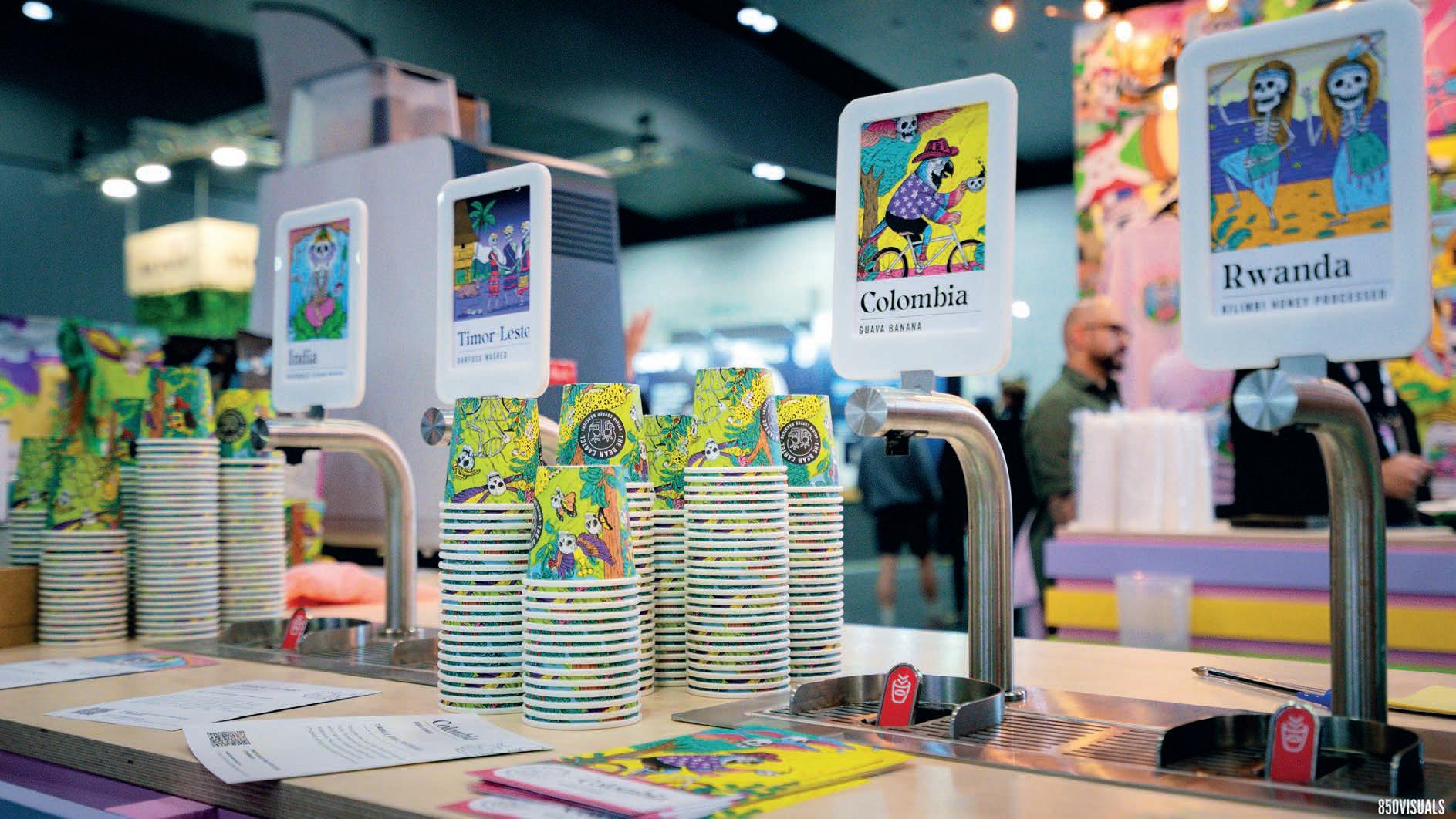
the business, manage the debt, and take care of their family. She sold her car to pay off what bills she could and started travelling around Melbourne to maintain office plants and coffee machines for less than minimum wage. She knew they needed to make changes, fast.
“Stacy sought help to address his mental wellbeing, and we put parameters into our life such as eating healthily, drinking less alcohol, spending time outside, and exercising,” she says.
Alison says there were many times when Stacy wanted to give up and go back to Adelaide, to their families, but she put her foot down.
“I said, ‘No way, we need to stick this out and you need to follow your dream.’ Our life in Adelaide was gone, I’d left my job and we’d sold our house, we couldn’t get that back,” she says.
Slowly Stacy started to get better and was able to head up the business again and, over the past decade, they have worked together
Stacy consults Alison on big decisions, such as The Bean Cartel’s recent vibrant rebrand.
to transform the office coffee company into the specialty roaster it is today. Yet, despite overcoming such great challenges and building a successful business, Alison admits she’ll never feel fully ‘comfortable’.
“It doesn’t matter how much money we have in the bank, we’ll still be cautious. There will always be a fear that we could lose everything again,” she says.
While Alison now has a more back-seat role at The Bean Cartel, Stacy still consults her on big decisions and stresses the importance of having a female opinion.
“Although I often share my thoughts with Stacy, I encouraged him to employ more female voices for our business. We already had our Warehouse Manager Lily Rice but, post-COVID, I felt we needed to add to our growing team by employing another female in a leadership role – someone who had experience in the industry,” she says.
“We were introduced to Melissa Glentis who has brought a wealth of experience
and knowledge to our team in her role as National Manager.”
As the company continues to grow, moving into new premises and expanding its roasting operation, Alison attributes the success of her and Stacy’s business – and personal relationship – to allowing space for one another.
“Living and working together 24/7 isn’t healthy for any relationship, so Stacy works from the factory at least three days a week. However, we talk about the The Bean Cartel a lot and, while I’m not often the face of the business, I have a lot of input,” she says.
“Our hope for the future is to continue to gain respect in the industry and build the business on the foundations we’ve already established. This includes supporting each member of our team with their personal growth and development, as well as garnering our own personal hopes and dreams.”
For more information, visit thebeancartel.com.au



Ahead of the launch of the Nuova Aurelia in Australia, the team at Nuova Simonelli detail their mission to create a seriously smart coffee machine.

Simonelli Group’s history dates back almost 100 years and is grounded in Italian coffee heritage. ‘Nuova’, which translates to ‘new’ in English, expresses the coffee machine manufacturer’s quest for innovation. It’s this constant exploration of new technologies and drive to optimise performance that has borne the new Nuova Aurelia, due for release in Australia in September 2024.
“Our mission is to create the smartest coffee machine, as well as the most intuitive to work with. Nuova Aurelia stands out as the masterpiece of our ideal machine for humans,” says Lauro Fioretti, Nuova Simonelli Product Manager.
When the first Aurelia model was launched in 2003, it represented the linking point of two centuries and marked a dramatic shift in coffee machine technology. According to Lauro, it was a machine of many firsts that elevated the standard quality of coffee right across the industry.
“It was the first machine to introduce certified ergonomics in order to create fluid workflow and make it as easy as possible to
use, the first single-boiler machine to feature in the [2009] World Barista Championships thanks to its great thermal stability and consistency, and the first machine to introduce full control of extraction,” he says.
Building on the success of the family of intelligent machines, the latest addition blends the Aurelia’s tried-and-tested technology and bold design with automatic innovation and technical resolutions.
“Nuova Aurelia empowers establishments with a broader range of beverages that can be made automatically and intuitively thanks to an easy-to-use set of co-working technology solutions,” says Lauro.
The Nuova Simonelli technical team have developed a suite of new automatic functionalities in response to the rise in demand for coffee machines that optimise workflow and minimise staff training. These innovations include E-Milk, C-Automation, Maximum Performance (MP), and Autopurge technologies.
“To enhance foam quality, we’ve introduced E-Milk technology, which provides automatic texturing of milk or
plant-based drinks at the preset temperature and dose. The barista can save up to nine recipes directly from the touchscreen display,” says Claudio Cingolani, Head of Research and Development and Technical Department at Nuova Simonelli.
“The sensors automatically activate the steam wand in the recipe selection directly from the steam knob display, without having to change the settings on the main touchscreen.”
The electronically controlled steam knob is made of aluminium to further speed up and simplify the operation. The steam is activated by a button, with the ability to adjust the purge manually or intuitively. The steam wand itself is crafted from a polymer that remains cool when in use, avoiding the risk of injuries for the user.
“The wand has a special milk sensor that can perceive when the wand is immersed in milk, automatically activating frothing with the preferred recipe. When the wand is in resting position, the automatic purge can be set,” says Claudio.
“These solutions are useful not only to speed up workflow, but to automatically
carry out the cleaning procedures to ensure durability of the coffee machine.”
The C-Automation technology focuses on achieving consistency while increasing speed and reducing waste. Connecting Nuova Aurelia to Simonelli’s range of GX grinders, the system monitors every extraction and, if necessary, communicates to the grinder to adjust the grind to improve beverage consistency.
“This ensures the dose is always consistent without requiring adjustments from staff, maintaining high quality without stopping workflow,” Claudio says.
The MP system is also developed to deliver optimal consistency and reduce the energy consumption of the machine. It is designed to achieve maximum control and temperature stability in every coffee extraction.
“The MP technology requires less energy, allowing for smaller boilers since only necessary water is heated. The boilers are insulated with an innovative material that prevents heat loss and increases energy efficiency,” says Claudio.
“The process is efficient, but it is also simple: the barista only has to set the temperature from the display. The machine’s electronics do the rest, keeping the temperature stable during the entire dispensing phase.”
Another interesting feature is the Autopurge technology, which reduces maintenance and waste by automatically
cleaning the group after the portafilter is detached.
Lauro believes Nuova Aurelia is the perfect fit for busy Australian cafés that don’t have lots of time to train staff but want to ensure its coffee standards remain high.
“Nuova Aurelia is a coffee machine designed for environments with high staff rotation. It is extremely intuitive, easy to use, and requires very little time for staff training,” he says.
He also thinks the machine is a great solution for non-coffee-oriented chains, roasters, restaurants, and hotels with a broader range of beverages.
Another versatile machine from Simonelli Group that provides a simple to use yet reliable solution for a spectrum of coffee-serving venues is the Appia Life Timer, which has recently become available in Australia.
“Appia Life Timer is a machine designed for those who need a product that’s trustworthy and simple to use, and enables less experienced workers to confidently serve excellent drinks,” says Lauro.
He highlights Appia Life Timer’s volumetric dosing and TFT (thin-filmtransistor) display, which enables the user to control dispensing times for a consistent result without waste. Compared to its sister product, Appia Life Standard, this new model gives the user more control and information on metrics to ensure the quality remains high.
“Appia Life Timer is an intelligent machine that electronically manages all performance criteria: the brewing time, the milk froth temperature of its Easycream system, and all the performance measures of the telemetry mode,” says Claudio.
“The telemetry system is particularly useful for coffee chains. It visualises the machine’s performance and provides data and statistics to regulate peak times, making the organisation of the business much more manageable. It also helps to organise the warehouse and the orders, thus optimising investments and employee scheduling based on the daily brewing graphics the machines provide.”
The energy-saving features of the new machine enable venue owners to manage their energy use while still preparing quality drinks. Thanks to Drytex Thermal insulation encasing the boiler, the energy consumption of the espresso machine is 13 per cent less than previous Appia models. A Life Cycle Assessment of the Appia Life Timer confirms the machine has 20 per cent less environmental impact than the Appia II.
“This is the ideal machine for large companies, chains, and any setting where there’s a requirement to make excellent coffees, but with great attention paid to economic sustainability,” says Lauro.
For more information, visit nuovasimonelli.com
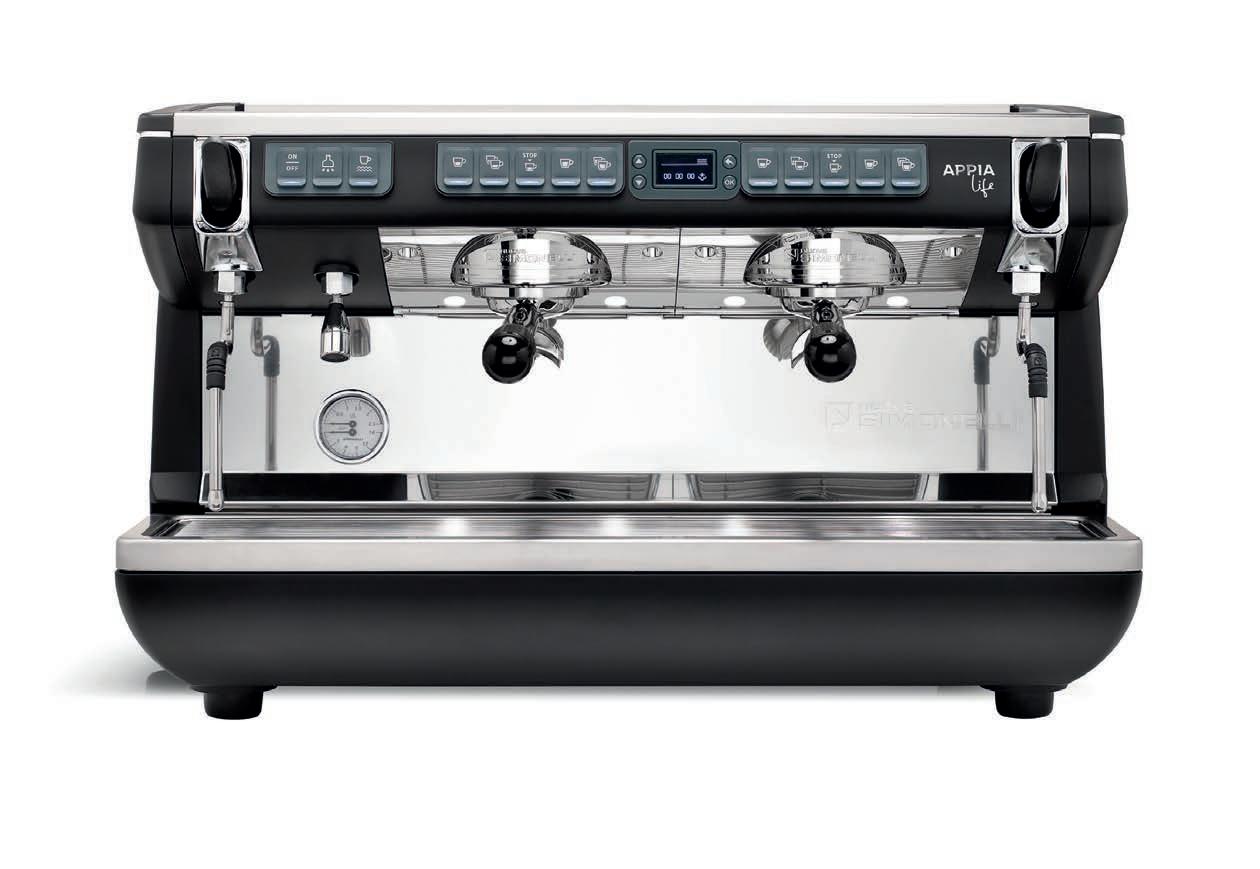

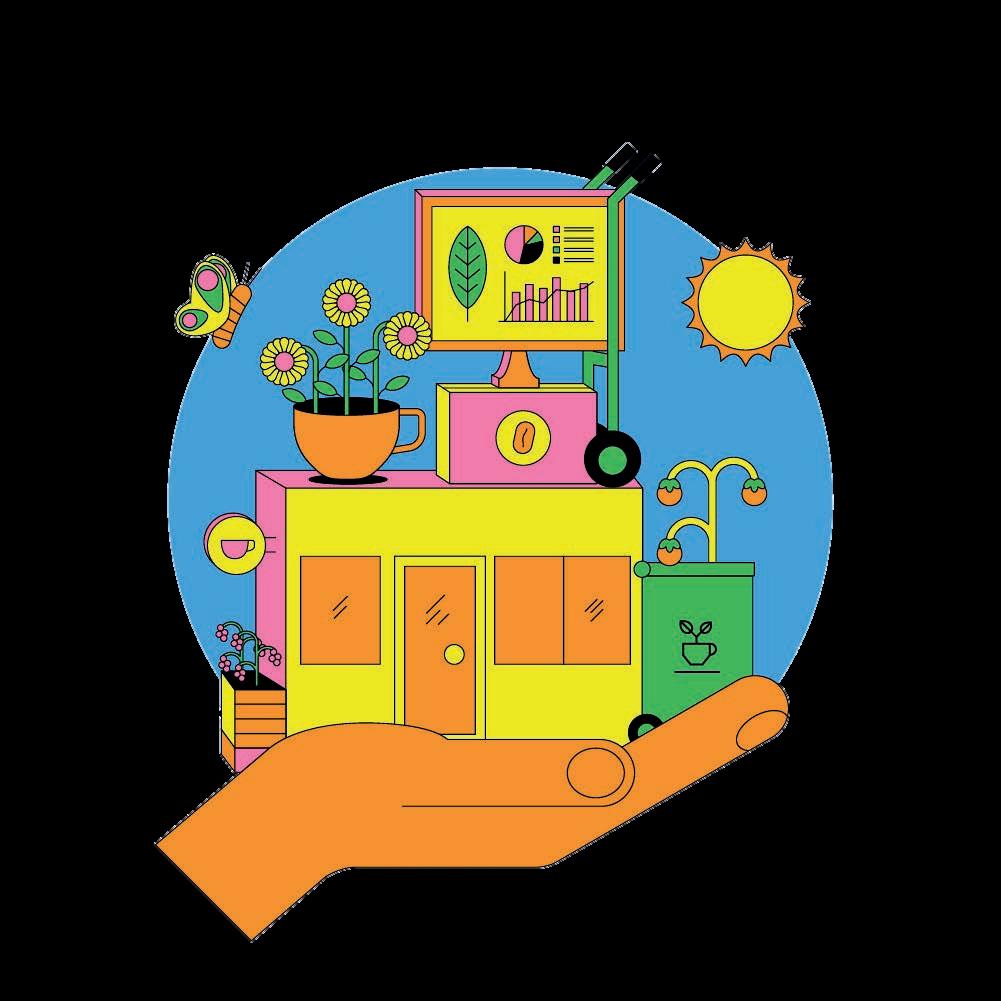

Founding Partners


Three industry professionals on how the Übermilk automatic milk steamer and Markibar Izaga W grinder have transformed their café setups.

The wheel, electricity, the mobile phone: some inventions have changed the course of history to such a degree that it’s hard to fathom life without them. In the café world, there are some pieces of equipment that evoke similar feelings, improving workflow and consistency to such a degree that some baristas and café owners consider the period
For Barista Group Marketing Manager Joe Chalhoub, the Übermilk automatic milk frother and Markibar Izaga W grind-by-weight grinder are two of the most game-changing professional coffeemaking innovations of the past decade. From independent specialty cafés seeking elite flavour to multi-venue chains in high-volume locations, Joe believes both innovations are key pieces of kit for his diverse café clients across Australia.
Batch Espresso Founder David Smith has been working with Joe for almost a decade. With five coffee shops across Sydney’s CBD serving around 500 kilograms of coffee each week, speed and consistency are a focus for
“This year we hit our target of serving over a million cups of coffee across our
“To function at such high volume, our key to success has been operating in an old-school manner that focuses on
Always on the lookout for ways to improve workflow and speed up service, David was an early adopter of Übermilk, becoming the second café in the city to introduce the technology. His friend Zach Hiotis got there first, working with Barista Group to install Sydney’s first Übermilk at Regiment Coffee, and David quickly saw the benefits of the automatic milk steamer.
“We installed our first Übermilk at our Pitt Street venue around six years ago and we haven’t looked back,” says David.
“The baristas love it because it makes their jobs so much easier. When they’d usually be steaming milk, it gives them time to concentrate on other things such as
The Übermilk is now an essential part of Batch Espresso’s setup. David says that as the mini chain of coffee shops expands, the milk steamer is factored into the

The
plans when designing a new venue, so now we always ensure there’s enough space for the Übermilk and that it has its place in the production line,” he says.
Another café owner who recommends the milk-frothing technology is Jason Korda of Gus’ Coffee in Queensland. A small franchise of coffee shops and drive-thrus, the business focuses on streamlining service and automating the coffee experience.
“We recently patented automated payment system Roboway for our drive-thru venues, and the Übermilk works hand in hand with this to modernise our workflow,” says Jason.
“Using the Übermilk, we’ve increased our volume without having to increase our workforce. The technology is very simple to use and easy to understand, so it’s made our training faster too.”
Working with Joe at Barista Group, Jason has also introduced Markibar Izaga W grinders at his venues to further streamline the coffee production line. He praises the grinder’s consistency and accuracy, highlighting that even during the morning rush the burrs never overheat.
“The Izaga’s grind-by-weight loading cell is so easy to use with our two signature blends. It’s incredibly efficient. The maintenance is straightforward too – it works perfectly for our business,” says Jason.
Similarly impressed by its functionalities, Melissa Glentis, National Sales Manager of The Bean Cartel, recommends the Markibar Izaga W to the
and beyond.
“We chose to move to the Izaga W primarily because of its consistent grind quality and advanced features that enhance the overall productivity of our café operations,” she says.
“The grinder is known for its precision and speed, which are crucial for maintaining the high standards of coffee we serve and enhancing efficiencies in the cafés.”
She highlights that customers have noticed the improved quality of the coffee, rich flavours, and shorter wait time, which she believes results in a better experience overall.
“It excels in both high-volume and speciality cafés, offering speed for busy environments and precision for qualityfocused shops,” she adds.
Melissa and the team at The Bean Cartel have worked with Barista Group for just over two years and she, along with David and Jason, say Joe’s expertise and industry experience are priceless.
“Working with Joe has been a fantastic experience,” says Melissa.
“The best thing about working with him is his deep knowledge of coffee and equipment, which he shares generously. His passion for the industry is infectious and he always goes above and beyond to ensure we have everything we need to succeed.”
For more information, visit baristagroup.com.au



John Denny and Karen Grima of Little Bean Café in New South Wales on their transition from the world of pubs and pints to cafés and cappuccinos – and how roaster Piazzo D’Oro facilitated the move.
When taking over an already established café, new owners often face the challenge of striking the balance between injecting their own personality and keeping existing customers happy. Change too much and happy regulars might go elsewhere; be complacent and you might miss out on a whole new market.
For experienced hospitality and marketing professionals, but first-time café owners, John Denny and Karen Grima, the process of taking over Little Bean Café in Mount Annan, New South Wales, was made much easier by the café’s existing partnership with roaster Piazzo D’Oro.
“Little Bean Café has been established within the Mount Annan Marketplace for around eight or nine years, and we’re the third generation to run it,” says John.
“We are now in our fourth month at the café and we’re really enjoying it. We’ve got a great clientele, it’s really diverse –from families visiting the playground area to shoppers picking up a coffee on the go and retirees stopping by to catch up with friends.”
The 50-seater venue serves a mix of takeaway and dine-in customers throughout the week, with a growing menu of house-made meals, treats, and cakes complementing the Italian-style coffee.
“Being in the hospitality industry for more than 25 years, we had the opportunity to switch to one of the other coffee suppliers we’d worked with previously, but we were really happy with the blend Piazza D’Oro was already supplying,” says John.
The coffee in question is Piazza D’Oro’s Mezzo blend, which Karen and John describe as “a characteristic coffee with notes of milk chocolate and caramel, with a tasteful finish”. The medium-roast Rainforest Alliance-certified coffee is the brand’s flagship blend, inspired by its Italian heritage.
“Leading into the acquisition of the café, we sat down with Matthew Green from Piazzo D’Oro and went through the products and how they could assist us,” says John.
“We also spent time talking to the locals to find out what they thought of the coffee. There are three cafés in this complex, so there’s a lot of competition, but the feedback

we received was overwhelmingly supportive of us continuing with Piazzo D’Oro.”
According to John, it was this customer feedback and the support Matthew provided that ultimately won him and Karen over. In the initial takeover period, John says the Piazzo D’Oro team touched base daily and helped them ease into café life.
“Now we’re a few months in, Matt still
pops in almost every week to see how we’re getting on,” says Karen.
“When we had an issue with a grinder recently, he went above and beyond to ensure we were up and running again as quickly as possible.”
As well as providing coffee and maintenance support, Piazzo D’Oro also helped Little Bean Café 3.0 off the ground with marketing assistance and materials. New flags and banners in the car park with both companies’ branding draws attention

they can get their hands on a cup of Piazzo
“The team have also helped us out with loyalty cards, and offer a promotional fund for us to utilise, which we’ll take advantage
With less than six months at Little Bean under their belt, John and Karen are taking
focusing on doing the basics well. We’ve had fantastic feedback so far, with nearly all five-


roasting, technology, and coffee innovation in Australia for years. For me and many other people he’s been a guiding voice, so he was the perfect person for the job,” says John.
Since releasing watermelon and yuzu infused cold brews at its Sydney cafés, Stitch Coffee has gained attention for its innovative signature drinks crafted with MONIN syrups. John knew Nawar was up to the challenge of developing something special for MICE, so he gave him a brief to create a canned cold-brew drink that captured Melbourne’s coffee scene. It needed to pique baristas’ interests, spark creativity, and trigger a touch of competitiveness.
“I wanted it to be a little bit jarring. It had to be good enough that the drinker thought it was delicious, but with room for them to think they could do better themselves,” says John.
The creative task force started playing around with flavours, running Stitch coffees with a kaleidoscope of fruity and herbaceous syrups. After many trial runs, blueberry was the flavour that stuck.
“The idea of using blueberry was sparked by my first ever visit to MICE in 2017. Ona Coffee had a line-up of black coffees that they were serving alongside different pairings, and my favourite was the one served with blueberries. The powdery flavour of blueberries really worked with the tannins of the black coffee as it cooled,” says John.
Nawar blended MONIN’s blueberry syrup with Stitch’s Black Field Blend coffee concentrate, adding a touch of saline solution and distilled citric acid to balance and brighten the drink.
“To stand up to the blueberry flavour, we needed a coffee that had a lot of body but little acidity. The Black Field concentrate worked well because its combination of Brazil and Papua New Guinea beans delivers smooth chocolate, caramel, and hazelnut characteristics. The addition of the citric acid helped to highlight the blueberry notes and coffee flavours,” says Nawar.
Packaged in 250-millimetre cans, the blueberry cold-brew was an all-out hit. The stock of 1000 cans produced for MICE were depleted before the three-day expo ended, with attendees coming back for second and third helpings.
For Nawar, seeing the success of the canned cold-brew at MICE has reinforced the notion that Australia is ready for more signature drinks and creative ready-todrink (RTD) beverages.
“We’ve been trialling some new RTD drinks. We’ve got a lemonade fizz that’s in production, which is similar to the yuzu cold brew we serve in our cafés. We think our customers are going to love a line of cold
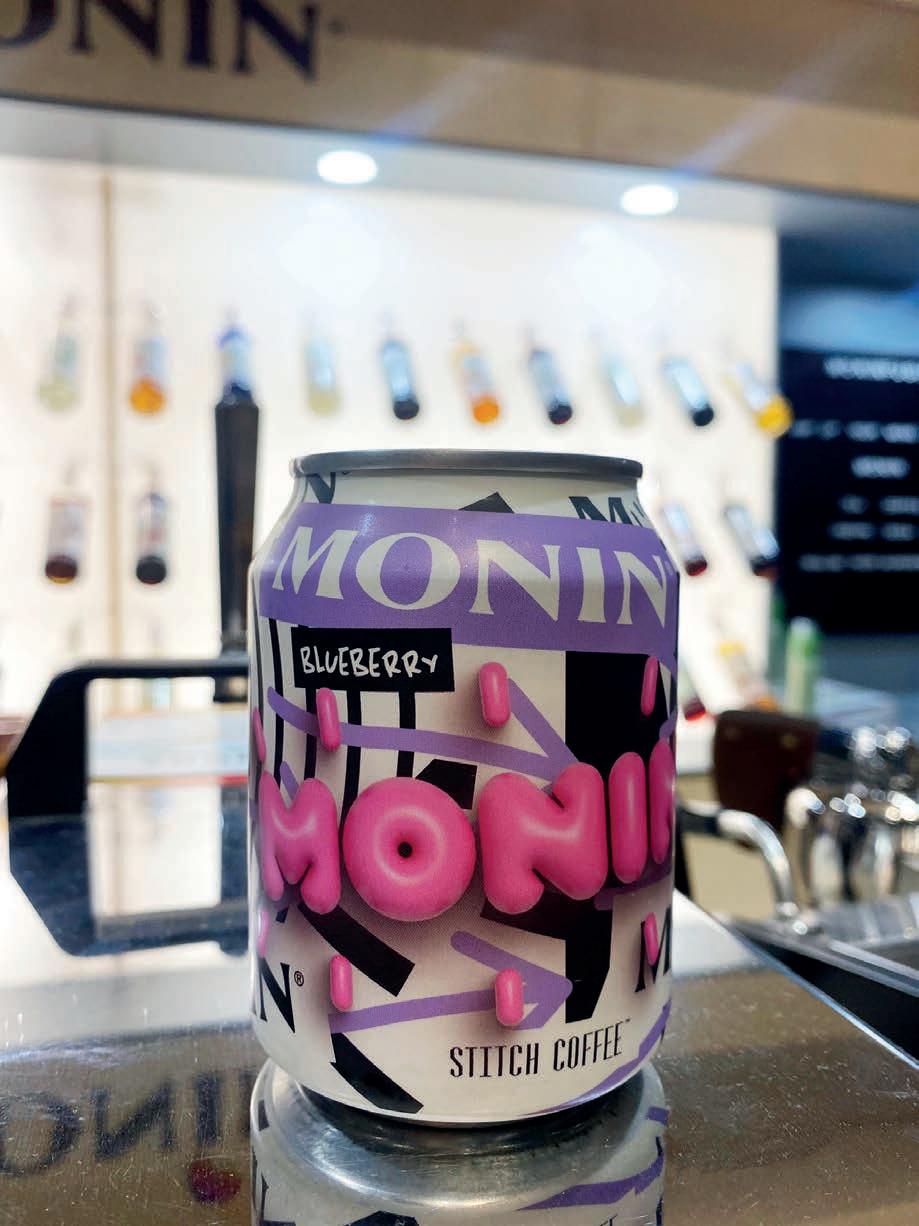
brews infused with fruit notes; people love being able to detect flavours and say, ‘that’s blueberry’,” he says.
Both John and Nawar believe Australia is on the cusp of a signature drinks revolution, inspired by coffee markets in Asia which like to play around with flavour.
“I believe there’s a new wave of signature drinks in Australia. It’s only going to get bigger moving forward. After Starbucks paved the way with frappes, making iced beverages more valuable than its hot beverages, I think specialty coffee shops are going to adopt this kind of thinking too,” says Nawar.
“There’s a new audience who are bored of iced lattes. We want to highlight that you can pair a syrup with a high-quality coffee to create a drink that’s not complicated to make but fun to drink.”
According to John, while the world used to look to Melbourne and Sydney for coffee trends, the rise of the internet means there’s
now a lot more international crossover, so trends are often of a global nature rather than national.
“The internet has made the beverage world a much smaller place, so global trends are at their peak,” he says.
“However, I’m hearing about roasters in places such as South Korea where cafés are serving 15 or more signature drinks. It’s really cool and a international trend we’re going to see more of.”
John and team are already planning their next trick for MICE2025, which takes place in March, with more creative showcases up their sleeve.
“Ultimately, MONIN is all about creativity. We want to be the reason people take a picture of their drink or try something outside of their comfort zone,” says John.
For more information, visit monin1912.com/en-apac
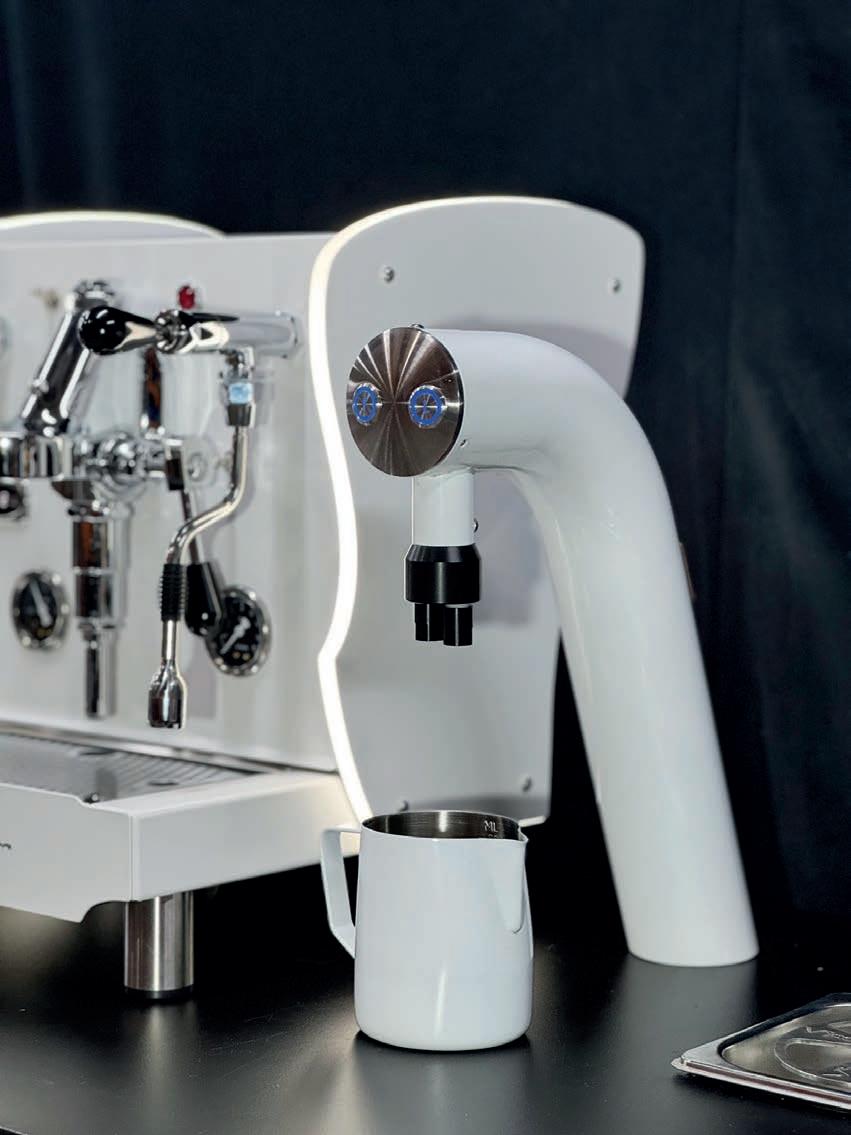
For years, Coffee Machine Technologies (CMT) has provided forward-thinking solutions for the coffee sector and partnered with companies that share its spirit for innovation.
In 2015, the company released the Viper independent milk steamer, which quickly became an in-demand product. As part of the Viper range, CMT then developed a milk delivery system (MDS), but the project was shelved when another product opportunity emerged.
Through this journey, the CMT team identified the challenges posed by current milk delivery systems, primarily attributed to high costs, complex cleaning processes, and the storage of milk in refrigerators.
Moving forward, it recognised a gap in the market for a simple, cost-effective, fully sustainable MDS. As a result, the Viper MDS was revived.
“One of our strengths is that when we see a need for a particular solution, we work aggressively to try and solve it,” says Carmelo Corallo,
The new Viper MDS features a sleek design and enables fast delivery of two types of milk using dual programmable buttons. Furthermore, a unique and simple recirculating cleaning function utilises less cleaning chemicals than other systems on the market, reducing cleaning costs up to 80 per cent.
Sustainability is a big topic in the café industry right now, so when The Udder Way presented its reusable milk kegs as a means to reduce plastic pollution, Carmelo’s attention was piqued.
According to The Udder Way Director Edward Crick, the average café uses roughly 10,000 single-use plastic containers each year.
“Given this statistic, we realised it was imperative to try and come up with a more sustainable solution for the industry,” Edward says.
“We worked with a local dairy company in Tasmania called Ashgrove to develop our first milk keg. From there, we started servicing areas around Australia and New Zealand.”
Coffee Machine
Technologies on how the Viper Milk Dispensing System streamlines workflow and helps eliminate single-use plastic.
Instead of buying a two-litre carton of milk, Edward says The Udder Way system allows users to purchase an 18-litre keg. Once emptied, it can simply be collected, washed, refilled, and returned to the café via the dairy company.
“Combined with the Viper MDS, this streamlines the process while also economising the storage in the fridge, because it saves a significant amount of space as well as waste. It’s also a lot more efficient because you can fit more in your fridge,” Edward says.
According to The Udder Way team, each food-grade keg eliminates 7000 single-use plastic bottles.
“Plastic is a fantastic product but if it’s not used sustainably it can have a detrimental effect on the environment,” says Edward.
“Our kegs have a life span of eight to 10 years and can be used up to 800 times, which equates to 302.4 kilograms of singleuse plastic waste reduction [per keg] in their lifetime.”
The Viper MDS was the perfect partner

product for The Udder Way’s technology, and a route for the new company to introduce its keg system to CMT’s wide and varied network of clients. When combined, the products created an independent, nofuss cold-milk dispenser.
“The team at The Udder Way wanted to take this product, as well as the Viper, to their clients. Therefore, we needed to give them the confidence that by combining their kegs with our MDS we would have a system that was going to work well,” says Carmelo.
“Even though we sell to different markets, both companies need each other’s products to create a fully sustainable and cost-effective solution.”
Carmelo says one of the typical limitations of milk dispensing systems is the cleaning process. When this is not done correctly it can lead to unnecessary costs and downtime. The Viper MDS overcomes this by utilising The Udder Way app to create a robust and well-organised cleaning system.
“The app takes users through the cleaning process step by step, and sends a notification when the chemicals need to be changed. It also logs each time the machine is cleaned,” he says.
According to Carmelo, the Viper MDS is tailored to suit the needs of businesses with
“WHEN WE SEE A GAP IN THE MARKET OR A NEED FOR A PARTICULAR SOLUTION, WE WORK AGGRESSIVELY TO TRY AND SOLVE IT.”
large waste outputs. He believes it is in these busy environments that the benefits of the system are most apparent.
“A high-volume café will benefit from this solution as there’s no need for the barista to access the fridge every couple of minutes,” he says.
“A latte is approximately 200 millilitres of liquid, so out of one litre you only get five cups. When you work out the maths, you can see how quickly a café gets through
hundreds of milk containers a week.”
Edward says customer feedback has been encouraging as the Viper MDS continues to gain momentum.
“We have already rolled out a unit in a university, which is using it as we speak and the feedback has been awesome,” he says.
“I think the beautiful thing about the Viper MDS is the simplicity of it and that really complements our product. You just press the button, it doses the right amount of milk, and there is nothing too technical about it.”
Edward adds that while some automated milk systems are double the price of a manual system, the Viper MDS is cost effective for those on a budget as it doesn’t create restrictions or hold up the coffee-making process.
Carmelo says CMT will continue to invest in collaborations with companies such as The Udder Way that are pioneering sustainable solutions.
“Creating a system to draw milk is just one part of it. We need both parties to come together to create something that goes full circle, and that’s why we made this partnership happen,” he says.
For more information, visit coffeemachinetechnologies.com.au

The Coffee you want, the Process you need, the Packaging you desire, the Service you wish




Jura introduces the X10 coffee machine, featuring new cold-brew technology to deliver a full spectrum of specialist beverages.
utomated coffee machine company Jura is no stranger to the ever-evolving nature of the coffee landscape.
Producing technology for the commercial market, the company was quick to act when it saw growing demand for an automated machine with coldbrew functionalities.
“We conducted a lot of research and noticed the popularity of iced coffee, not only in the European market but especially here in Australia,” says Jura Managing Director George Liakatos.
“From there we decided to create the X10, which incorporates a cold-brew system to deliver a full spectrum of hot and cold coffees.”
The X10 can produce up to nine different cold coffee specialties, made possible by the extraction process developed by Jura’s team of engineers.
“In this process, cold water passes through freshly ground coffee as it pulsates under high pressure with a slow cycle frequency. This allows the aromas of the coffee to be absorbed by the water,” he says.
It’s this functionality, George believes, that makes the X10 an ideal coffee machine for the office as it caters to “everyone’s coffee preferences.”
“Where you have a lot of people, you have a lot of different tastes. The X10 can deliver a total of 35 specialty coffees from one machine,” he says.
Throughout Jura’s history, its mission has always been to create machines that produce high-quality coffee. Although each feature of the X10 is carefully designed to do this, George believes equipping it with a good grinder was one of the most essential to achieve their goal.
“Having cold and hot brewing technology in an automated machine means you need to adjust the grinder between settings,” he says.
“For the X10, we integrated our new professional Aroma Two Plus grinder, which features a Relax Mode. This automatically removes any residual coffee in the grinder, allowing the user to adjust settings with ease. It also ensures coffee remains fresh.”
Designed for efficient workflow, the X10 also features a Claris Pro water system and a fully integrated automatic milk-system cleaning solution.
According to George, the combined benefit of these is reduced maintenance.
“In a workplace setting or where you have multiple users, you want to simplify your coffee machine as much as possible,” he says.
“Milk-system cleaning is a daily operation that can take time. With this integrated solution it only takes a couple of minutes. The beauty of this is it doesn’t disrupt workflow while it is cleaning.
“The Claris Pro water system is an excellent filtration system, which eliminates the need to decalcify or descale the system.”
Design was a key priority for the Jura team when developing the X10 as they wanted the machine to have a professional look to suit all manner of business settings.
“We invest a lot in the design of our machines, and the X10 is no different. It is very striking to look at,” says George.
“It comes in a dark inox colour, which is really elegant and gives it a timeless look.”
Following the launch of the model in the European market, George says it has been well received and he looks forward to introducing it to the Australian coffee scene in September 2024.
“Since entering the Australian market we have worked hard to deliver on quality and efficiency in our machines,” says George. “The X10’s combined features make it a great value proposition and we have existing customers who are keen to upgrade.”
For more information, visit jura.com

Hot from its launch at Melbourne International Coffee Expo 2024, the new xBloom is gaining attention for its versatility and design.
As members of the coffee industry gathered at Melbourne International Coffee Expo (MICE) in May 2024, each day a crowd of people formed around one equipment specialist’s stand.
According to Coffee Tools Distributing Director Curtis Arnold, it was the two automated pourover coffee machines, the xBloom Original and Studio, that were drawing the crowds to his stand.
“The reaction was crazy, we were one of the busiest stands,” he says.
“The xBloom is one of our best-selling brands. Following the success of the Original, we launched the Studio at MICE. The new model brings something new to the table in terms of flexibility and versatility.”
When the xBloom was first launched in 2022, Curtis was blown away by the technology and started using it in his office to craft filter coffee at the touch of a button. He then partnered with the company to share it with the Australian market.
“I was really impressed with the workflow, coffee, and machine overall and thought the automated features were fantastic. To be able to achieve a highquality cup of coffee so consistently is the unique standpoint of this machine,” he says.
The new xBloom Studio builds on the Original’s intelligent bean-to-cup functionalities, which produce filter coffee in three simple steps. It also comprises a standalone grinder, brewer, and scale, which can be used as part of the machine or independently.
“If somebody makes espresso at home as well as filter coffee, they can use the xBloom Studio’s standalone parts to help with their coffee preparation. For example, they can use the scales for precision dosing and the adjustable grinder for grinding to a specific coffee recipe,” says Curtis.
Powered by an automatic step motor, the grinder can be adjusted for specified grind sizes and auto-recalibration, achieving near-zero retention for consistently highquality coffee.
“The grinder is a key part of the machine and has 80 different dialling points, allowing the user to grind beans coarse for cold brew or fine for espresso,” says Curtis.
“This contributes to the versatility of the machine as it allows users to brew a variety of specialty coffee – be it in the office or from the comfort of their own home.”
Both xBloom models feature an autopilot mode, through which users can scan a recipe card and enjoy coffee the way the roaster intended. The recipe functionality
not only caters for the needs of the busy barista who wants to focus on consistency, but also the homeowner who wants to get a little creative with their pourovers.
“The machine is engineered to consistently execute recipes with minimal margins of error,” says Curtis.
“It ensures each brew faithfully reproduces the intended flavour profile with precision and reliability. This means any waiter, coffee enthusiast, or office worker can create an amazing cup of coffee without having a special set of skills.”
When asked about the future of automation and what it means for the industry, Curtis is positive as he reflects on the reactions of MICE attendees. He praises companies like xBloom, which he believes are helping to pave the way in machine innovation and efficiency while also giving the end user the freedom to be creative.
“With the rise of machines like the xBloom Studio, you’re not only getting convenience but also a quality product, and that is hopefully where we are going with automation. It allows people to control all variables and produce amazing results in a repeatable way.”
For more information, visit coffeetools.supply or xBloom.com
Cropster
highlights
its software suite and how it can improve workflow management for the coffee sector.
ince entering the Australian market almost 16 years ago, roasting software company Cropster has continued to develop its products to help connect those working in the coffee industry.
Its suite of forward-thinking technology provides solutions for four different sections of the industry: origin, roasting, commerce, and café. According to Product Marketing Manager Kelsey Maher, over the past few years the team have focused on making their technology more beneficial to more people in the coffee supply chain.
“When designing the software, the main drive is creating a tool that ultimately helps coffee-focused businesses increase productivity and achieve consistency,” she says.
Cropster’s software provides an overview of workflow and details on inventory for a huge range of businesses all over the world, from farmers to roasters and café owners. Its Roast product, for example, provides roasters with real-time data on roast curves and inventory, and includes the Roasting Intelligence profiling feature.

“Roasting Intelligence is specifically designed to help roasters get the best out of their coffee,” Kelsey says.
“The software is very progressive and enables the user to connect the program to their existing machinery, set their profiles, and then use it as a reference curve for future roasts. This is a great tool for teams with multiple roaster machines, who can then cup the coffees to ensure a high-quality roast is achieved.”
In addition to helping roasting teams maintain consistency, Roast also features a sample management tracking system, which gives green bean suppliers the opportunity to record samples and see how they perform each year.
“It can also act as a tool to help them remember a sample they’d like to revisit in the new purchasing year,” says Kelsey.
Making its debut at Melbourne International Coffee Expo (MICE) in 2013, Roast has become one of the company’s most popular products in the Australian market.
“Regularly attending MICE has really helped us demonstrate what our product can do for key players in the coffee industry,” says Kelsey.
To complement Roast, Cropster has developed sister product Commerce, which provides roasters with planning and traceability tools to help sell their coffee.
“Commerce was recently added to our suite, designed for roasters who would like to receive orders from their online shops automatically and fulfil orders using packaged, loose, or freshly roasted inventory,” says Kelsey.
In the spirit of innovation, Kelsey and the Cropster team are particularly excited about their latest software solution, Cropster Café.
“For high-volume café owners, Cropster Café can act as an enterprise resource planning (ERP) tool,” she says.
“If a café owner has more than one location, it can provide insights into what’s happening at each individual venue.”
Designed for precision, the plug and play system is connected to the espresso machine and tracks key telemetry data.
“Cropster Café provides focused analysis via a user-friendly interface, helping café owners make datadriven decisions to increase revenue, productivity, and customer satisfaction,” Kelsey says.
“It’s an easy-to-use system that ensures
consistency in coffee while also helping to create efficient workflows.”
Recognising the importance of machine maintenance for busy café owners, Cropster Café provides key performance-based reports.
The Focus View cross-references recipes with the collected telemetry so users are able to swiftly analyse performance of each espresso machine and location. Managers will easily spot rush hours and slow hours. Sustainability was another key consideration for the team at Cropster when designing the four software products.
“When we talk about achieving high quality and consistency with our products, it also means we want to help customers reduce their waste,” says Kelsey.
“The reporting feature helps to avoid out-of-range batches so customers can make better use of their inventory, team, and equipment. Whether it’s roasting the right profile, taking less time to dial-in recipes, or just knowing every process can be standardised by Cropster, we want to help make a more sustainable coffee value chain.”
For more information, visit cropster.com
Coffee grinder
manufacturer Eureka
details how the latest addition to its automated range delivers on consistency, reliability, and practicality.
Founded in Florence in 1920, Eureka began its journey in coffee grinding technology more than a century ago. While the company is steeped in Italian history, in recent years it’s shifted its objective to constant innovation, managerial structure, and a strong customer focus.
It has established itself as a global coffee grinder manufacturer, with more than 190,000 units produced each year for both commercial and prosumer segments.
The brand’s latest innovation is the Atom W 75 grind-by-weight grinder, which uses patented instant-weight technology for real-time high precision dosing. It is designed to streamline busy baristas’ workflows and ensure the quality of coffee remains consistent.
“We are really excited about this new product,” says Eureka Global Sales Director Luca Nunzi.
“It is exceptional in a lot of ways, particularly in its precision which guarantees a smooth and accurate grind result,” he says.
In developing the grinder, Eureka recognised one of the main factors contributing to variability in dose is coffee getting stuck in the grind chamber, which is a result of not keeping up with cleaning.
“We have simplified the maintenance of the Atom W 75 by creating easy access to the burrs and grind chute. Thanks to our patented stepless micrometric regulation system, the burrs in all Eureka grinders can be cleaned and removed without disrupting the grind setting,” he says.
In-built precision scales ensure only the exact amount of coffee is ground, which Luca says maximises grind consistency and quality.
“The benefit of consistency in the grind is that it frees up more time for the barista, giving them increased capacity to focus on the customer,” he says.
Another priority for baristas is speed, which the Eureka team addressed when developing the Atom W 75. Specially developed 75 millimetre flat engine burrs and stepless micrometric grind adjustments allow the grinder to reach a high dispensing speed and flow of coffee powder.
“These burrs have multiple advantages,” says Luca. “The Atom W 75 disperses a dose of almost five grams of coffee per second, which showcases its high productivity rate.”
When considering the workflow of the barista, Eureka looked for additional

methods to speed up the process. Its solution is an automated built-in tamper system which fits perfectly underneath the grinder.
“We have created a fully automated process from start to finish,” says Luca.
“The barista simply puts the handle of the portafilter in the grinder, the machine grinds the beans to the exact weight, and then the tamper automatically compresses the grounds evenly. It creates a very simple and quick workflow that doesn’t require any skill,” he says.
Durability was also a key consideration for the Eureka team, who opted for an aluminium and metal frame to ensure the grinder could endure any café environment. Luca says this quality, combined with its easy maintenance, reduces the need for repairs and is therefore cost efficient.
“If there is banging on the bench or the machine receives any knocks or bumps, which is likely in a busy café, we’ve ensured the casing is fit for purpose. This also means performance isn’t disrupted,” he says.
Alongside the Atom W 75, Eureka has
also introduced the Atom W 65. This model has the same grind-by-weight technology, but with smaller burrs.
“The Atom W 65 is the same grinder but with 65 millimetre burrs and a different engine. Therefore, we can see it being more suited to lower volume cafés as well as households,”says Luca.
Both models come in red as well as matt black, white, and grey.
In partnership with Australian distributor Segafredo Zanetti, Eureka’s new model is now available across the country. According to Segafredo Zanetti Australian Eureka Brand Manager Danny Giarratana, the response from clients has been amazing so far.
“Customers are raving about the new model. Eureka wanted to create a grinder to make things as easy as possible for the user without compromising on quality, and that’s exactly what it has delivered,” he says.
For more information, visit eureka.co.it or segafredo.com.au
IMA Coffee Hub on its latest automation-based software and how it helps to deliver product line transparency.
s automated technology continues to progress, so do developments in precision and control. The latest innovation from coffee processing plant solution provider IMA Coffee Hub is its Roasting Director Suite, a versatile software panel that includes a variety of roasting control systems to improve these factors.
Nicola Panzani, CEO of IMA Petroncini and Commercial Director of IMA Coffee Hub, says the new technology is designed to provide flexibility and quality consistency for medium- and large-scale roasters via its full suite of interacting solutions.
“IMA provides a range of roasting control software: semi-automatic control Maestro Avantgarde for specialty roasters, and fully automatic Opera 30 and Orchestra controls for industrial roasters up to 720 kilograms,” says Nicola.
Understanding that industrial roasters are regularly required to change roasting recipes at short notice, Nicola highlights that Orchestra has been specially designed to respond to these needs.
“Orchestra is our most advanced roasting control system and is capable of keeping quality consistent – from the first batch when the machine is cold to the last roasting cycle – to guarantee consistency in final colour, moisture, and taste over time,” he says.
As part of its drive for continuous improvement, IMA has collaborated with research institutes and experts in automation technologies to launch an exciting new project, which it hopes to integrate into its intelligent roasting software.
“The AI-Learning to Roast project focuses on machine learning intelligence,” says Nicola.
“Addressing the increasing need for targeted coffee profiles, it details how certain AI algorithms can anticipate unexpected situations and minimise finetuning operations.”
Nicola says that for roasting plants, coffee product customisation and quality assurance is essential, and that Roasting Director Suite users can take full control of these parameters through its automatic data exchange feature.
“For coffee producers, product customisation and packaging quality

IMA’s new automation-based technology is tailored to suit the productive needs of every coffee processing and packaging plant.
assurance are essential factors that led us to design the Coffee Control Room. With this application they can take full control of the process parameters through its automatic data exchange feature,” he says.
“It is tailored to suit the productive needs of medium-size and industrial plants, enabling users to carefully trace and monitor production lines through its smart features in order to monitor and control overall plant production.
“The advantage of our exchange data feature is that it can automate production flow from raw coffee receiving up to the final package, providing full visibility and traceability of the product.”
According to Nicola, the company has seen automation integrate into every part of the coffee supply chain. He details how the Coffee Control Room can monitor each step of coffee processing and packaging.
“The system summarises daily roasting production through its dashboard interface and can identify the quantity of the coffee in the storage silos – green, roasted, or ground. This helps to avoid any production and contamination errors,” says Nicola.
“Modern production facilities often make use of complex and varied equipment, and an integration of technologies can make it difficult to keep track of production, limiting traceability.
“This is why we created a very easy, integrable system. The unique dashboard
combines roasting and packaging data with systems to manage the plant, creating a fully automatic end-to-end solution.”
Developed to provide full transparency to the operator, the Coffee Control Room is equipped with smart functions that are programmed to identify under-performing components and keep roasting and packaging machines running optimally.
“Through alarms and smart tips, the software provides real-time information on machines and plant performance. The prompts given by the system aim to minimise downtime and create optimal workflow,” he says.
“This makes it possible to increase the yield of production batches and decrease the number of discarded parts, also making it cost effective for the company.”
The Coffee Control Room is a great example of IMA Coffee Hub’s spirit for innovation, as well as its dedication to helping coffee roasters in the industry.
“IMA Coffee Hub strives to answer the needs of the rapidly evolving coffee industry and engineer quality solutions to enhance the performance of its customers.
“It covers all aspects of processing and packaging – from consultancy and design to production planning and turnkey solutions – providing fully automatic lines,” says Nicola.
For more information, visit ima.it
The future is automated, according to Barista Equip. Founder Brett Bolwell recommends the products he thinks best benefit cafés big and small.
According to Barista Equip
Founder Brett Bolwell, the Australian café scene is in a significant period of transition. No matter the size or scale of the business, he believes the next few years will see key shifts in technology and workflow in response to industry issues such as staffing and rising prices.
“Automation is becoming an increasingly critical component of the everyday running of a café,” he says.
“We’re seeing a technology transition from the traditional espresso setup to a semi or fully automatic format. Whether that’s a café owner supplementing their manual espresso machine with tools such as automatic milk steamers and grind-byweight grinders, or a quickly expanding startup rolling out super automatic machines to produce coffee at the touch of a button, there are automated products to suit every type of business.”
As specialists in automatic coffee technology, Brett and the team at Barista Equip help café owners find the solutions to make their operations run as smoothly as possible. With a wide range of products from some of the world’s most innovative manufacturers, they work with each client to create a workflow tailored to their business.

“Barista Equip is the only company in Australia that can provide the entire solution; we don’t just supply intelligent machinery but also the latest telemetry systems,” says Brett.
For café owners with a traditional setup looking to modernise their bar, Brett recommends a few key pieces of equipment. The first is the Perfect Moose automatic milk steamer.
“The Perfect Moose takes over the whole process of the barista manually steaming the milk. The user simply places the jug in the machine and it creates perfectly textured milk at exactly the right temperature for the desired drink, whether it be a flat white, latte, or cappuccino,” he says.
“If you’re running a busy operation and usually have two baristas at the machine, one running shots and the other milk, by adding one or two Perfect Mooses you can speed up workflow considerably and ensure the result is consistent.”
The addition of a grind-by-weight grinder is another product Brett believes is an essential tool for high-volume cafés.
Barista Equip Founder Brett Bolwell believes automation is the future of the Australian café industry.
He highlights the new Flow Grinder by Fiorenzato, which is integrated with Flow telemetry technology.
“Most baristas don’t have time to mess around weighing shots, so Fiorenzato’s self-adjusting grinder helps the user keep their recipes consistent throughout the day,” he says.
“The addition of the Flow telemetry system ensures that, as the shot profiles change due to climatic conditions, age of beans, and all the other things that affect the quality of the espresso, the grinder responds to the data harvested by the Flow system to adjust the grind size and keep the coffee quality high. A self-adjusting grinder takes a step out of barista’s workflow so they can focus on the customer and ensure every coffee served is of the best possible quality.”
Many of the cafés Brett and the Barista Equip team work with are established, however, they also help new startups get off the ground. For ambitious owners with plans to roll out a chain of venues in a short space of time, Brett recommends exploring the benefits of super automated espresso machines.
“If you’re starting from scratch and want to scale things quickly, I would go with a super automatic,” he says.
“The beauty of these machines is that you can run multiple shots at the same time at the touch of a button, with alternative and dairy milks running simultaneously and delivered direct into the jugs.”
One well-known brand that’s embracing automation is McCafé. Barista Equip has recently started working with the chain to implement the Flow telemetry system at some of its venues across Australia.
“We already had three products in McDonald’s, so we approached them to trial the Flow system to see if it could improve the quality of their coffee,” he says.
After four to six weeks of trials, Brett says there was still room for improvement, and suggested using the Flow system data to introduce some changes.
“If you can’t measure it, it’s guess work, so I think the data from telemetry technology is crucial for any type of café,” he says.
“Australia has been slow to adopt automated and telemetry technology compared to Europe and North America, but Barista Equip is here to help café owners make the transition.”
For more information, visit baristaequip.com.au














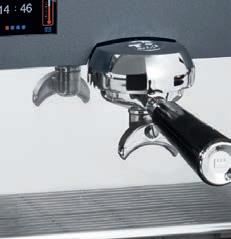



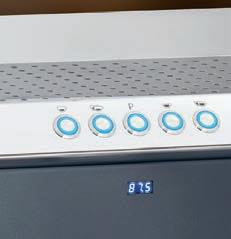
















How Paradox Coffee Roasters’ holistic outlook is helping its café partners build their businesses.
When The Naked Barista Founder Adrian Duquilla was searching for a coffee roaster to supply his newly launched café in Rooty Hill, New South Wales, he wasn’t just looking for a roaster that supplied great beans but one that could also offer the support he needed to get his business off the ground.
“The roaster I chose to partner with when we first opened didn’t work out and that made me realise I needed a local roaster, one that was on the ground and could provide the support I needed,” he says.
Adrian kicked off his barista career in the pandemic by posting brewing videos on Instagram. When he opened his first café, he wanted to offer his customers hands-on and interactive experiences to continue his tradition of knowledge sharing.
“I wanted my customers to be able to experience things that are usually reserved for people in the industry, such as cuppings. The team at Paradox were more than willing to help me host and run the events, which have been really successful,” he says.
It’s this enthusiasm to go above and beyond that many of Paradox’s café partners highlight as the element that makes the Sydney roaster stand out from the crowd.
Celeste Renee, Manager of Picnic Café in West End, Queensland, credits Paradox’s high levels of service and ongoing training as the motivation to move suppliers.
“Since we switched to Paradox four years ago, we’ve trusted the team and grown our business alongside theirs, enjoying everything they have to offer,” says Celeste.
“The team have helped us grow by providing private training for our new baristas. Their training modules are tailored to different skill levels, whether it be barista basics, machine programming, mouthfeel, alternative brewing, or cold brewing courses. You name it and they’ll provide the training.”
Picnic is part of a small group of specialty cafés across Queensland, with Paradox supplying its Paper Moon blend as the house coffee for all three venues. According to Celeste, it stood out in Paradox’s collection as a crowd-pleaser that suits a vast range of coffee serves.
“We get incredible feedback from our customers and love hearing that we serve the best coffee in West End. The amount of

repeat customers we see on a daily basis is evidence of how beautiful a cup of Paradox coffee is,” she says.
The team at Alimentary Eatery in Brighton, South Australia, also attest to the brilliant feedback they receive about Paradox’s coffee. Yet, for Founder Deeb Milky, it was the personal service he received from the team that confirmed he’d made the right choice when he switched coffee suppliers at the end of 2023.
“The biggest thing for me has been the relationship they’ve offered. The constant communication, touching base to ask if everything is going okay and if they can help is very reassuring,” he says.
“We get on well with the Paradox team and the service they provide is like being part of a big family. When we visited the roastery in Sydney, it was like being welcomed into their home.”
It’s this personal touch and holistic approach to partnerships that the team at Paradox strive for with each of their café partners. Drawing on their industry experience, they provide support beyond coffee roasting – from barista education and systematic training to creative branding and equipment solutions.
“We understand the challenges and opportunities in the coffee market to help our café partners grow and succeed,” says
“Cafés are looking for a holistic solution and not just a transaction on coffee. They want to believe in the brand they are buying from and they value the personalised support we provide.”
According to James, personalisation is key to forming long-lasting relationships with their café partners.
“We understand that cafés come to us with different levels of capability and knowledge in specialty coffee. Our team enjoy working with all types of cafés and have the expertise to guide them through the coffee process and uncover opportunities where our specialty coffee range can play an important role in growing their business,” he says.
“We are a brand ‘for the people’,” says Nicole Saleh, Paradox Coffee Roasters Marketing Director.
“From the growers we source from and our team who roasts and shares their knowledge, to our café partners and the baristas who serve our coffee and the customers who enjoy it, we respect the role each person provides on the journey to delivering a great coffee experience.”
For more information, visit paradoxroasters.com


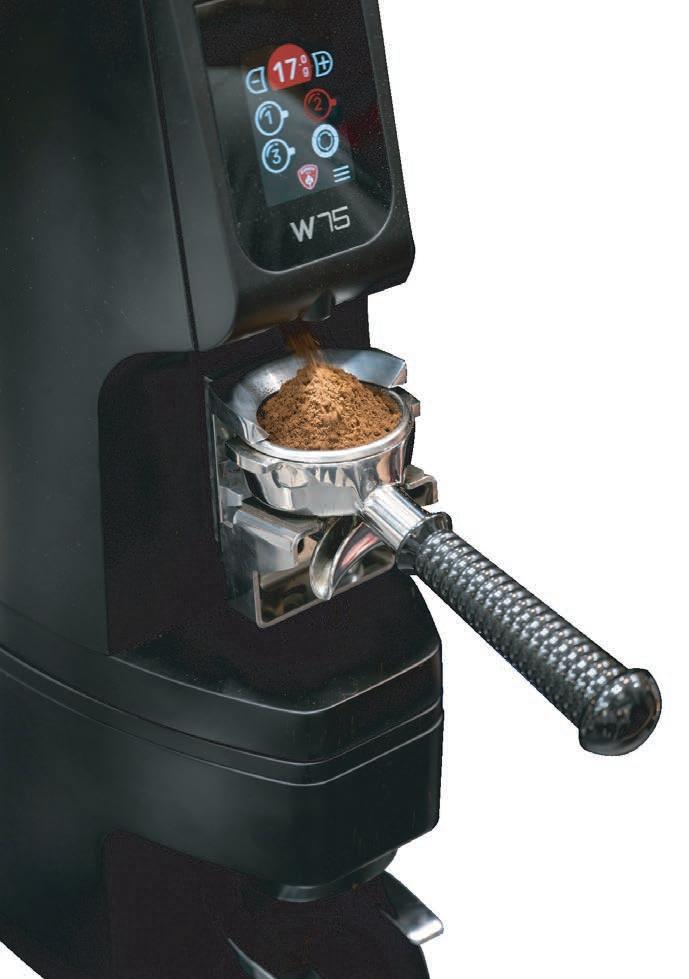



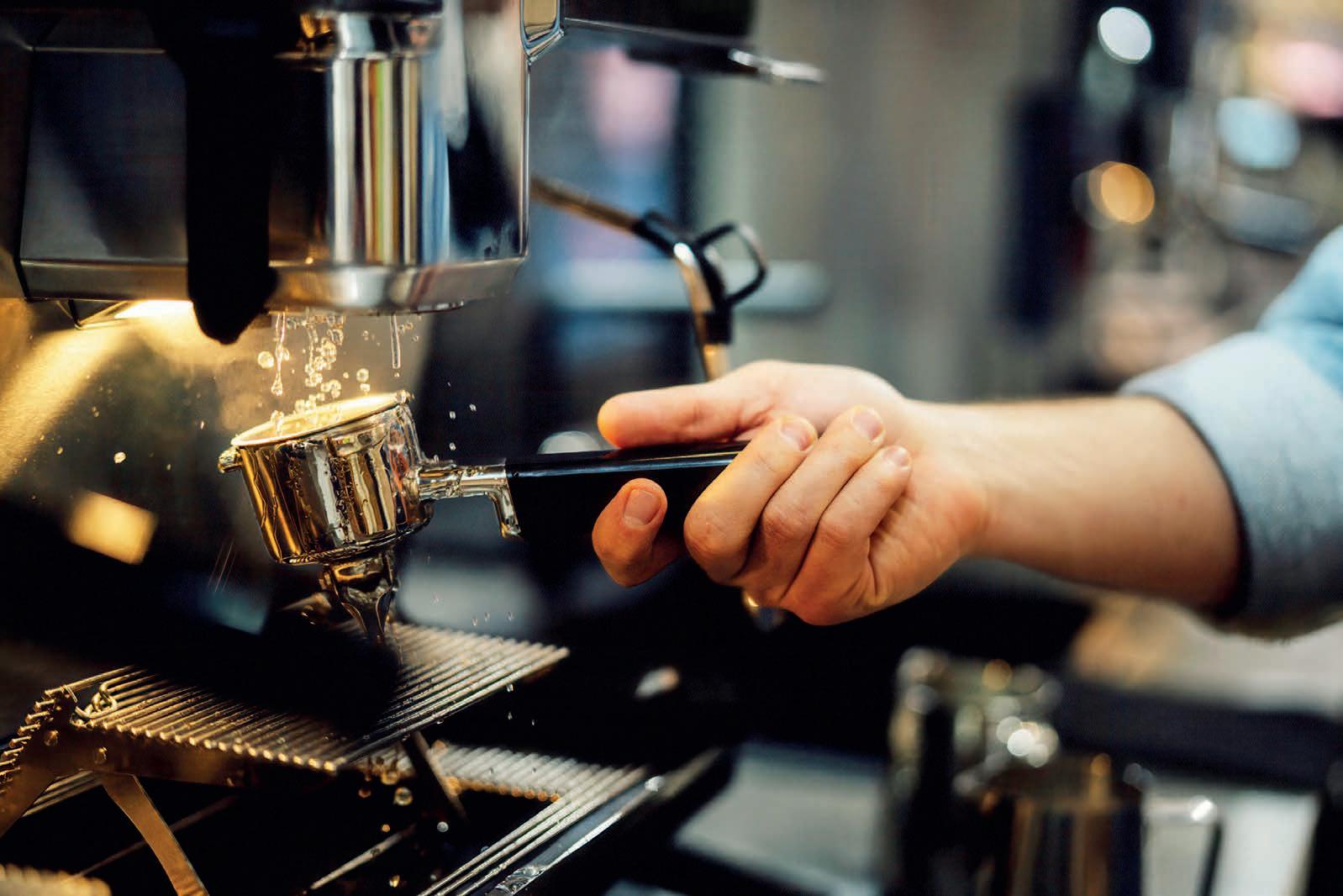
German Latte Art Champion Daniel Gerlach on the trends and challenges within the international barista scene, and his new appointment as a Brand Ambassador for WMF Professional Coffee Machines.
Daniel Gerlach knows a thing or two about competing on the international stage. The Owner of Seven Hills Coffee Roasters in Bamberg has won the German Latte Art Championship not once but three times, going on to compete for the world title on each occasion.
These experiences have firmly rooted the master latte artist in the international barista scene, and his multiple roles within the industry as a competitor, business owner, and, most recently, brand ambassador have equipped him with a unique perspective on the community’s opportunities and challenges.
“I look at the barista scene from three different perspectives, and what I see everywhere is a renewed emphasis on craftsmanship,” says Daniel.
“At the same time, coffee machines are changing. There is a certain hybridisation going on: portafilters are getting more automatic functions, while fully automatic

machines are being equipped with manual controls. Coffee preparation is becoming both more manual and more automated at the same time.”
While some might view automation as a threat to traditional barista culture, Daniel sees the evolution of technology as a positive development for the industry that gives baristas more time to focus on the coffee and customer service.
“I think the modern barista world is moving towards the human factor, which is also the most unstable factor, but is being supported by automation,” he says.
“For example, if I’m not 100 per cent focused on the machine and can only give 80 per cent, perhaps due to stress, I notice this immediately in the end product in the cup. If the machine supports me in this, the product will be much better.”
Daniel draws comparison to the restaurant sector, in which assistive automation has long been commonplace, even in the upper echelons of the industry

such as Michelin-starred establishments.
“Of course, there is a certain community that won’t use any auxiliary products, but that’s not the reality of the world market nor the day-to-day running of a coffee shop,” he says.
Automation is often thought of as one of the solutions to the staff turnover challenge affecting hospitality business owners in Australia and around the world. Daniel believes this issue is increasing the gap between the high and low ends of the café market and is something operators need to address.
“I think we as baristas need to be more open to new technologies,” he says.
“At World of Coffee in Copenhagen in June, we used a fully automatic machine for the first time [in the SCA World Latte Art Championship]. It’s dividing the scene, but I’m also seeing a change in attitude. Many colleagues are realising the products that come out of it can be good.”
Another challenge Daniel highlights is the growing number of home baristas, many whom he says are “bigger nerds than us professionals”. He thinks the trend towards customers crafting coffee at home should be an incentive for professional baristas to keep up to date with innovation and help shape the future café scene.
“Machines and technology are becoming more important, but I think we can love the craftsmanship, the recipes, and the sensory aspects, and still use a certain amount of support to make our lives easier. It’s a bit like changing gears in a car: I love driving manually, but the further the journey, the more grateful I am for the support of an automatic gearbox,” he says.
As a Brand Ambassador for WMF Professional Coffee Machines, Daniel sees his new role as an opportunity to build a bridge between the barista world and fully and semi automatic coffee machines.
“As part of the role, I’m involved in the technical side and do a lot of quality management. I test and present the machines, and regularly exchange ideas with WMF about advantages and disadvantages in the market, target groups, and areas of responsibility,” he says.
The WMF espresso NEXT is the European machine manufacturer’s semi-automatic portafilter machine, which promises to reduce manual coffee preparation by up to 40 per cent and free up the barista’s time to focus on customer service. Daniel thinks it’s a great solution for venues with high staff turnover.
“The WMF espresso NEXT is ideal for all situations in which high-quality coffee is important, but where it’s not possible or feasible to employ a trained barista. The main target group here is classic system catering with many locations and frequently changing staff, such as the hotel industry
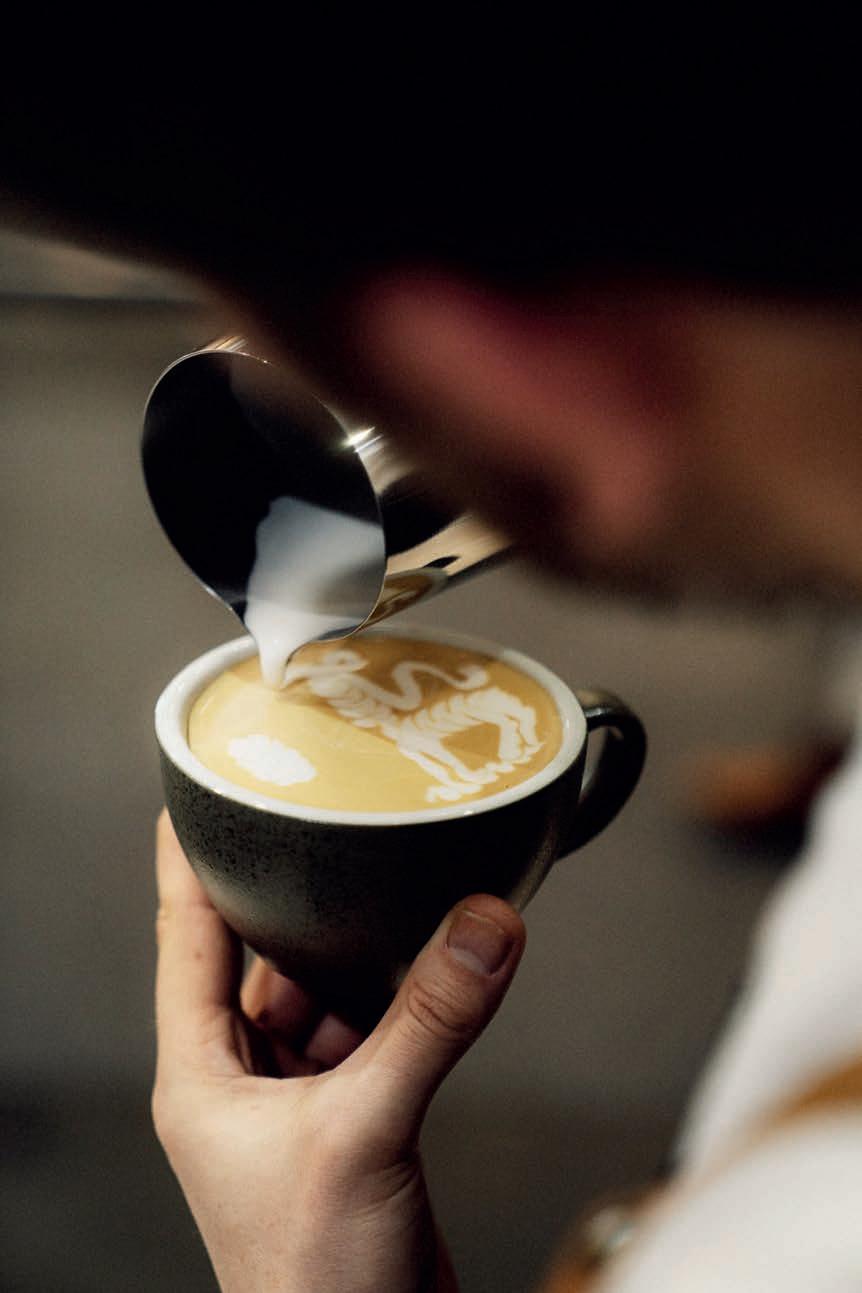
and larger coffee chains. However, the delicatessen sector is also a potential target, whether it’s a chocolatier looking to expand its range, a fine patisserie, or a Michelinstarred kitchen,” he says.
One of the main advantages of the machine, according to Daniel, is its ease of use.
“When I demonstrate the WMF espresso NEXT, I never have to explain much to people – that would be completely different with a classic portafilter,” he explains.
The ability to operate the machine as a classic portafilter machine, or integrate the automated processes, enables new staff members with little experience to start using the WMF espresso NEXT without the need for extensive training. However, Daniel stresses that the automated features also benefit experienced baristas.
“Nobody, including me, is immune to day-to-day form. This automatic support is particularly noticeable during big events [such as coffee expos] when we are confronted with very different circumstances. In the morning, for example, the exhibition halls are cold, then when the visitors arrive the temperature rises. Despite this, the machine still works consistently throughout the day, so I don’t have to keep checking – that’s a big advantage,” he says.
“I also have fewer work steps. This is particularly noticeable in the speed with which the individual coffee drinks can be prepared. There are many little things that make the WMF espresso NEXT a real allrounder for me.”
For more information, visit wmf-espresso-next.com
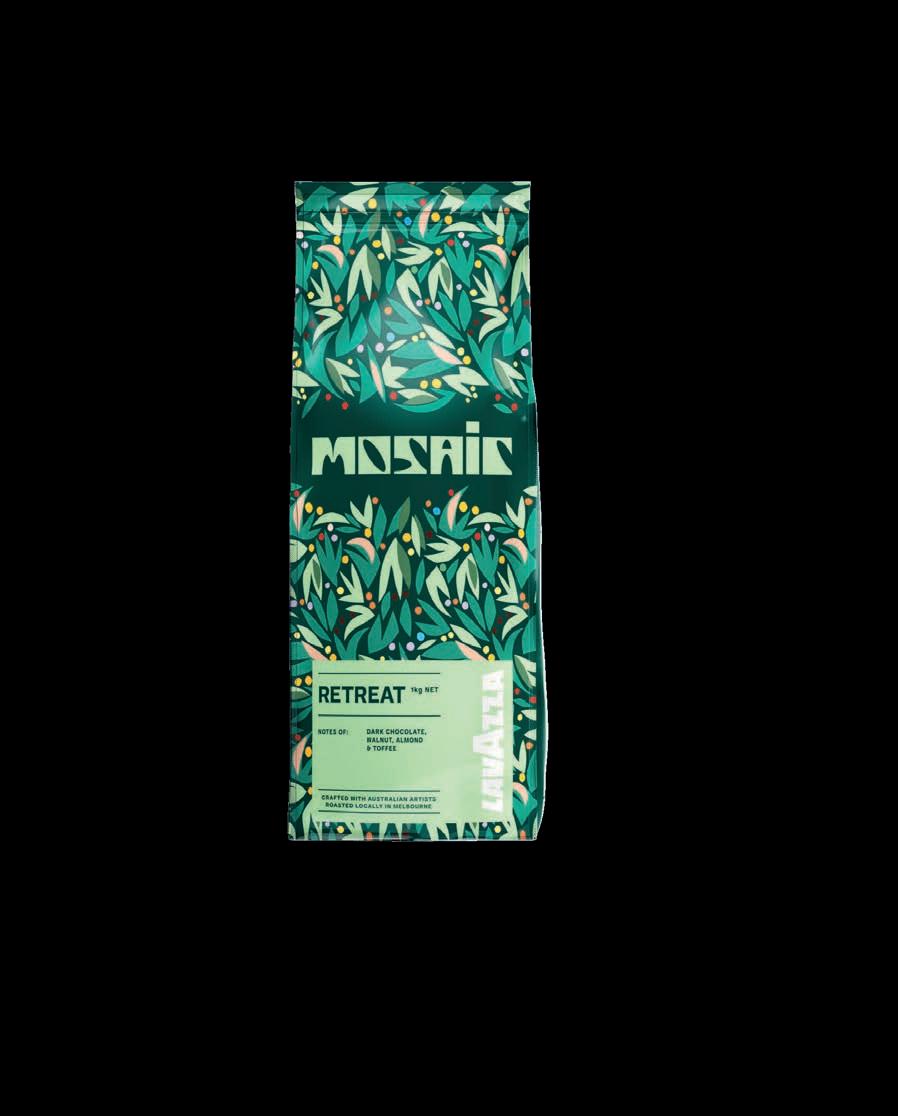

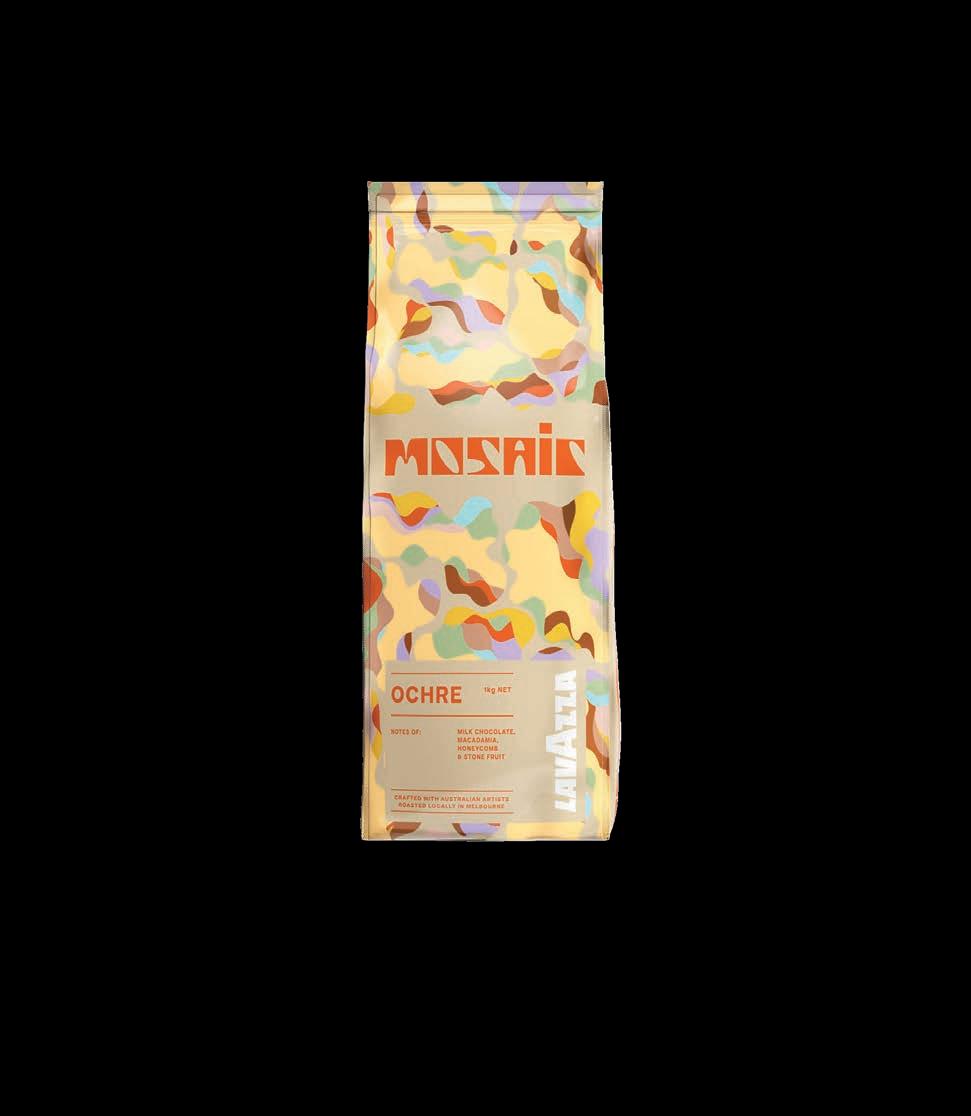
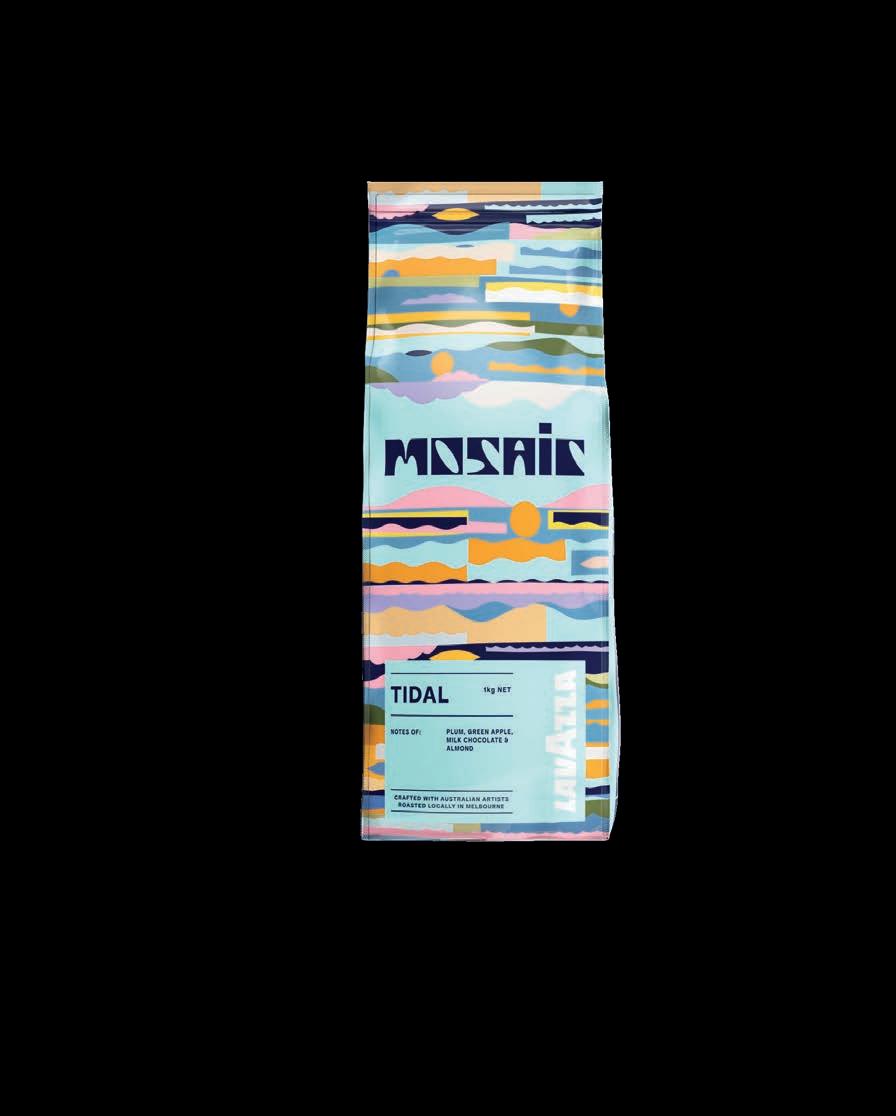


ITwo-time Australian Barista Champion Jack Simpson shares his espresso recipe for the Mazzer Philos grinder.
n the June edition of BeanScene, 2024 Australian Barista Champion and World Barista Championship finalist Jack Simpson shared his tried-and-tested filter formula for the new Mazzer Philos grinder.
To demonstrate the single-dose grinder’s versatility, the Mazzer Ambassador is back to reveal his espresso recipe.
With 64-millimetre flat burrs and zero retention, the premium commercial grinder is designed to help baristas optimise workflow and get the best from every dose. It’s also designed to be compact and spaceefficient, occupying minimal counter space and fitting into even the smallest of areas.
According to the team at Mazzer, the grinder is powered by an asynchronous motor and crafted with precision machining for long-lasting durability. Magnets are used to improve workflow and to ground the equipment, thereby preventing static electricity and coffee dust build-up.
The Philos is equipped with the option of two sets of stainless-steel flat burrs: I200D for well-balanced, pleasant acidity and fruity notes in medium-light roasted
1. Begin by dialling in the coffee grinder by turning the six-micron step dial to 18 for a fine grind.
2. Using Mazzer’s magnetic dosing cup, measure 20 grams of beans and place them in the hopper. Turn the grinder on and open the hopper gate to release the beans and begin the grinding process.
3. Once the coffee is ground, pull and release the chute knocker to discharge the coffee grounds until you have 20 grams out.
4. Put the coffee in the portafilter and tamp. For an extra level of consistency, use the Dose Finisher provided with the grinder and a Weiss Distribution Technique tool to distribute the grounds evenly.
5. Connect the portafilter to an espresso machine group head to extract the coffee blend.
coffees; or I189D to produce full-bodied extractions and a rich velvety mouthfeel for those who prefer medium-dark roasted
coffees. Both burrs work well for filter and espresso drinks.
Philos is suitable for all extraction methods – from V60 through AeroPress to espresso. Jack says he loves its versatility and sleek design, highlighting its ease of use, reliability, and precision.
“It’s not a big grinder, so it also appeals to the home market,” he says. “There aren’t a lot of options in this area of the market at the moment.”
Jack says the Philos grinder reflects the level of quality that has made the Mazzer brand well-known around the world.
“That’s why you’ll see Mazzer on a lot of café benches, because its grinders keep producing consistently high-quality coffee,” he says.
“It’s the kind of product and brand I am happy to associate my name with.
“I’m excited to show those who haven’t tried Mazzer products exactly what they’re capable of.”
For more information, visit Australian Mazzer distributor Coffee Works Express cwe.com.au.

How Smeg’s range of professional and semi-professional machines helped YHA Australia upgrade its properties to suit the modern traveller.
When YHA Australia decided to revamp its Sydney Harbour property to be a simpler and more stylish spot for the contemporary traveller, fitting it out with state-of-the-art professional appliances was a priority.
“We’ve been working with YHA for three years,” says Leon Wolf, Smeg Australia’s General Manager of Professional Division.
“The Sydney renovation came about after we upgraded YHA’s café in Melbourne, where we swapped the coffee machine with one of our La Pavoni models,” says Leon.
“The YHA team not only loved their new machine but also the end-to-end service we provided. Over time, we’ve started to fit out their other locations across Australia with coffee machines, dishwashers, ovens, and other cooking equipment.”
YHA was founded more than 80 years ago by a group of bushwalkers. They introduced a collection of places to stay with
a purpose to equip visitors with valuable life skills best gained through travel, whether by sharing an experience with a community or learning how to navigate a new city.
According to YHA Australia CEO Paul McGrath, the hospitality group has decided to take a new strategic direction, rebranding its line of properties to be recognised as hybrid affordable accommodation.
“When we were established in the 1940s, our priority was accommodating backpackers. Our focus has now shifted to provide low-cost alternative accommodation, which in turn has widened our demographic,” says Paul.
“We have families, vacationers, working holiday makers, corporates, and school groups all staying with us. We want to give people choice and a space that provides them with the opportunity to meet and connect with other people.”
For YHA’s Sydney Harbour renovation, Paul knew having quality equipment was key to aligning with the company’s change
in direction. He also knew that Smeg’s team of professionals could assist.
“The collaboration with Smeg has helped us continue to grow and add to our brand by providing us with the best of the best in terms of coffee machines and equipment,” says Paul.
“We wanted the creature comforts and quality of a hotel, but to put our own spin on it. The partnership with Smeg has enabled us to do that. If people want to cook their own food or make a good coffee, we want to give them the choice.”
As such, installing a quality coffee machine that was easy-to-use was front of mind.
“Previously we had never served food and beverages, so to give our customers choice we introduced an in-house coffee shop, Trail Café,” says Paul.
“Through the introduction of the twogroup La Pavoni machine, Smeg provided us with a point of prestige that people recognise. It really adds to our brand. People unite around having a coffee and a chat, that’s
why it was so important for us to have a great machine.”
When deciding on a coffee machine that was fit for purpose, Leon says the La Pavoni Desiderio was the perfect choice.
“It’s a two-group coffee machine, which is not only aesthetically appealing but also commercially versatile in terms of the setup,” he says.
“It also gives YHA versatility in terms of coffee suppliers, giving the team the option to source beans locally to each hostel, which is a hugely important part of its sustainability agenda.”
For the YHA Sydney Harbour site, Leon and team learned early on that the property sits on a natural structure of sandstone adjacent to the harbour, meaning saltwater seeps into the rock and the water supply.
“We had to run water supply tests to specify the correct filter, not only for the coffee machines but also for the dishwashers,” he says.
“Poor water quality means poor quality coffee, so we made sure we got that right when installing the machine. We know if the coffee tastes good, customers will keep coming back for more.”
Leon highlights that Smeg’s adaptability and range of products gave the hospitality group plenty of choice.
“We have variety in our range that allows YHA to pick whatever equipment it needs based on the property location and size,” he says.


Not having a dedicated barista was another factor to be considered when supplying equipment, and where Smeg had the opportunity to demonstrate its smart solutions.
“Hotels, hostels, and restaurants have many different users, so we also implemented a lot of training,” Leon says.
“When YHA have staff turnover, we go back in and train the new team members to get the best out of the coffee machine. This also includes how to clean and maintain the machine, which is equally important.”
According to Paul, the training has been invaluable.
“Understanding our environment and the nature of our business was pivotal and Smeg and the team were excellent in educating and training our staff on how to brew a good coffee,” he says.
Leon says the team at Smeg understand YHA’s specific needs and are therefore happy to provide a hands-on service, no matter what territory the YHA location is in, or if staff need to be trained or retrained.
“At our core we are a solutions provider. With this partnership we can showcase our end-to-end support for whatever the situation may be,” he says.
For more information, visit smeg-professional.com/au and lapavoni.com/au
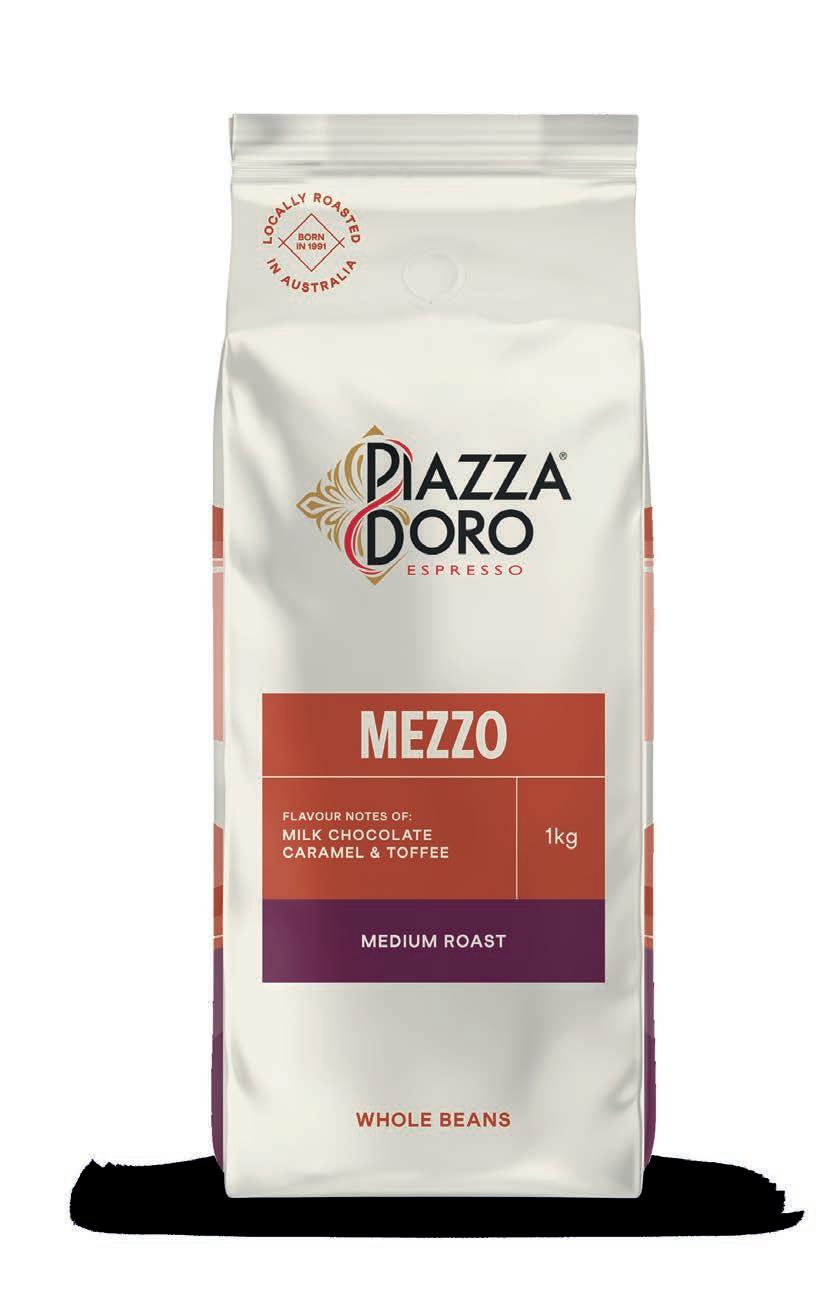
Since 1991, Piazza D’Oro has been consistently providing satisfaction in every cup. Today, we serve 58 million cups every year, offering five unique blends tailored to the different needs of Australians. All our coffee beans are 100% responsibly sourced, for a better future.
Partner with us and benefit from dedicated support to help your business grow.

Speak to us today to learn more about differentiating your coffee offer: 1300 33 1753 or au.hello@piazzadoro.com.au www.piazzadoro.com.au






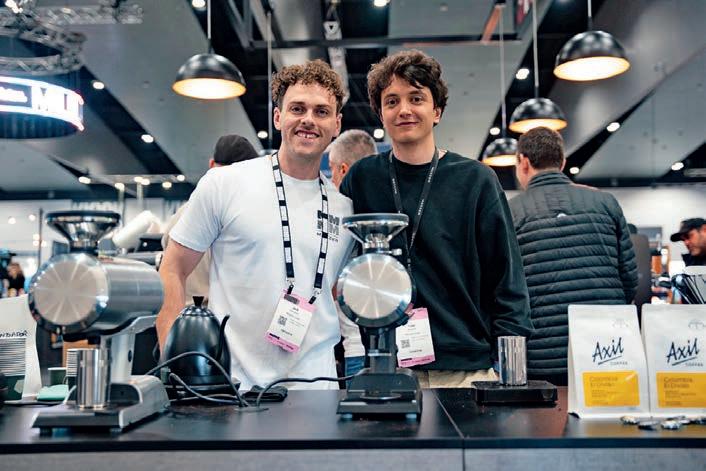

The Melbourne International Coffee Expo has been and gone, but the 2024 edition of the show was a feast for the senses and delivered its purpose to the industry, and so much more.
There’s a certain stereotype that best describes attendees to Melbourne International Coffee Expo (MICE). Picture this: eager eyes scouting the exhibition space in search of coffee, hands full with promotional materials and promo bags, comfortable footwear depicting lessons learned from past experiences, arms open to embrace industry connections that pronounce themselves every metre or so, and a giant smile because coffee makes us happy, after all.
This personifies attendees to MICE2024, and for good reason. A total 10,897 visitors walked through the doors of the Melbourne Convention and Exhibition Centre from 12 to 14 May, and event organisers couldn’t have been happier to have hit their target attendance number.
“This year’s event was vibrant, well attended from representatives of all segments of the global coffee supply chain,
and held its purpose as a space for industry buyers and sellers to do business. It helped generate exhibitor leads, connect café owners and baristas with suppliers, and added more value than ever before,” says MICE Show Director Lauren Chartres.
The Bean Cartel Founder Stacy Visser says MICE2024 was crucial for his company as it allowed the roaster to firmly establish its presence in the competitive coffee market.
“Exhibiting at MICE2024 was an incredibly rewarding experience for The Bean Cartel. The expo provided an unparalleled platform for us to raise brand awareness and showcase our full product range to coffee enthusiasts from around the world. Our vibrant team thrived in the lively atmosphere, engaging with both industry professionals and coffee lovers, which significantly boosted our brand’s visibility and reputation,” says Stacy.
He says the exposure and networking
opportunities were unmatched, but most valuable was the opportunity to connect with so many passionate individuals and businesses.
“We gained invaluable insights, forged new partnerships, and received direct feedback from our customers, which will undoubtedly help us refine and expand our offerings,” Stacy says.
This year’s MICE welcomed a Café Corner education area where hospitality journalist Wendy Hargreaves hosted daily sessions on key topics impacting the local industry.
A two-day Global Coffee Report Leaders Symposium invited guests to learn from leaders in their field, with topics representing the European Union’s Deforestation Legislation, business in Asia, and the infrastructure of the Australian recycling and composting packaging sector.
“It was a wonderful two-days of knowledge sharing. Judging by the sold-

out event, our industry is still hungry for knowledge, to learn and thrive, and will actively seek opportunities to enhance their own business decisions,” says GCR Symposium Moderator Sarah Baker.
Beyond education, MICE2024 hosted the second instalment of Australia’s Richest Barista competition, which gained international entries among the country’s top baristas who fought in the knockoutstyle tournament for their share of $40,000 worth of prize money.
Junnie Phyu of Junnie Coffee Workshop took first place and $25,000 in prize money.
Lucky Salvador of Coffee Man Darwin, and Perk and Palate placed second and won $10,000, and independent barista Jae Kim came in third and won $5000.
“It’s an honour to win this year’s Australia’s Richest Barista competition. It’s an amazing event that has allowed me to showcase my skills in different areas within the coffee industry,” says Junnie.
The first round of the competition had
baristas producing six coffees in under 10 minutes: two espressos, two milk-based drinks, and two signature beverages that must incorporate a flavour option from competition sponsor Naked Syrups.
“I used a natural Ombligon coffee featuring flavours of red cherry, blood plum, and bergamot, produced by Nestor Lasso of Finca El Diviso in Colombia. This was the same coffee that Australian Barista Champion Jack Simpson used in the 2023 Australian Barista Championship,” says Junnie.
For her signature drink, Junnie produced an iced filter coffee with elements of lemon, cheesecake, and osmanthus tea. She used Naked Syrups’ Traditional Lemonade beverage flavouring.
The second round was a latte art challenge, and the third was a nail-biting sprint to the finish line in cupping. Junnie correctly guessed four out of five flights of coffees in a time of 2:19 seconds, with Lucky and Jae also correctly guessing four out of five flights, in a time of 2:55 minutes and 3:47 minutes respectively.
For the first time, MICE attendees were given the chance to vote for their favourite coffee throughout the show, registering their vote via the MICE app or through QR codes on exhibitor stands. Taking home the inaugural top honours this year was Victorian roaster White Owl Coffee.


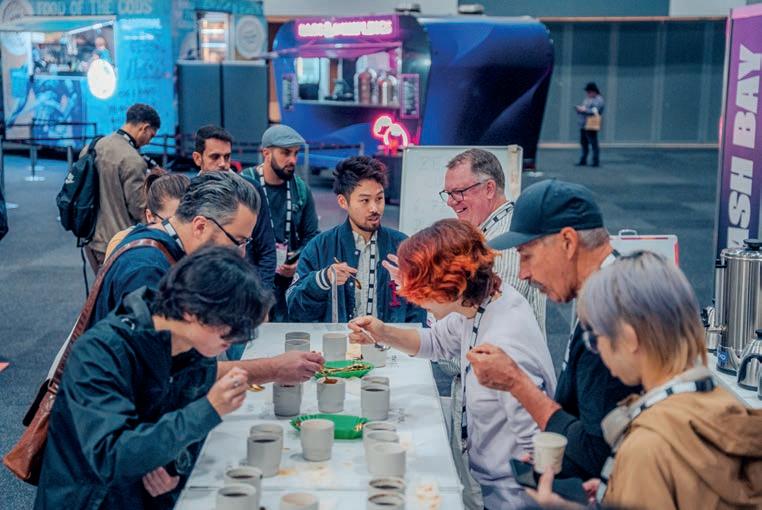
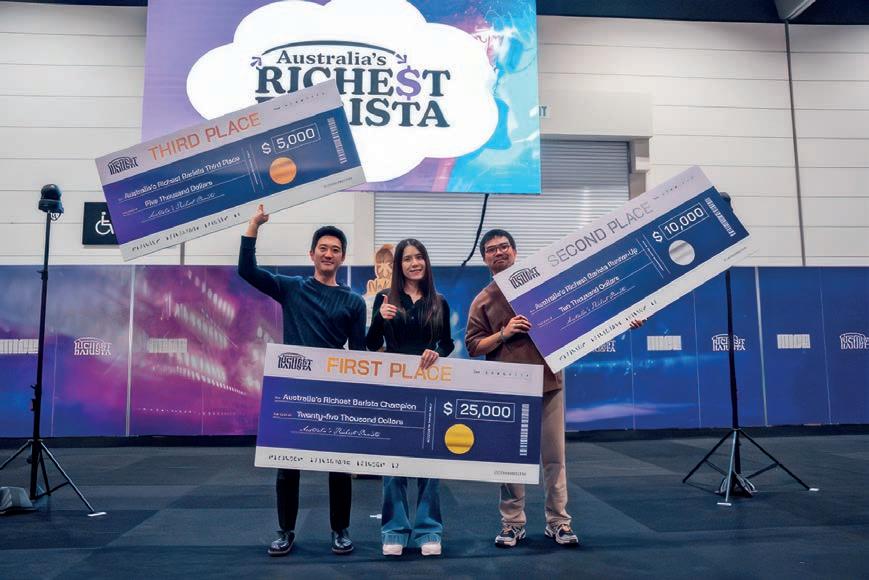


experience. We’re so grateful to the whole coffee community for coming by our stand and trying our coffee,” says Joe Perry, White Owl Coffee’s Head of Coffee.
This was White Owl Coffee’s first time exhibiting at MICE. It showcased its house blend, the Nest Blend, as well as its Hometown Blend.
“I think our Nest Blend really resonated with people because it’s got a classic coffee profile. That, along with our story as a family-owned business, I think pulls at
Rounding out MICE’s annual awards was the Product Innovation category, which recognise the best innovations by MICE exhibitors. This year, Scentible Consumable Sensory Kit by Barista Supplies won both the Judge’s Choice and People’s Choice categories.
“We’re so proud of what we’ve achieved. We’ve worked really hard on this product for the coffee industry, and we believe it’s truly an innovative product that will improve training, as well as the way we
aroma training and palate development.
“It’s amazing to see that not just the judges but the general public are so accepting of this product as a solution for sensory training,” Alec says.
Hario Australia’s V60 Dripper Suiren placed second, and Roastar Coffee Packaging’s BeanShield Vent placed third. And just like that, MICE2024 came to an end. Lots of equipment made their Australian debut, new blends and dairy alternatives were shared and tested on a mass audience, and

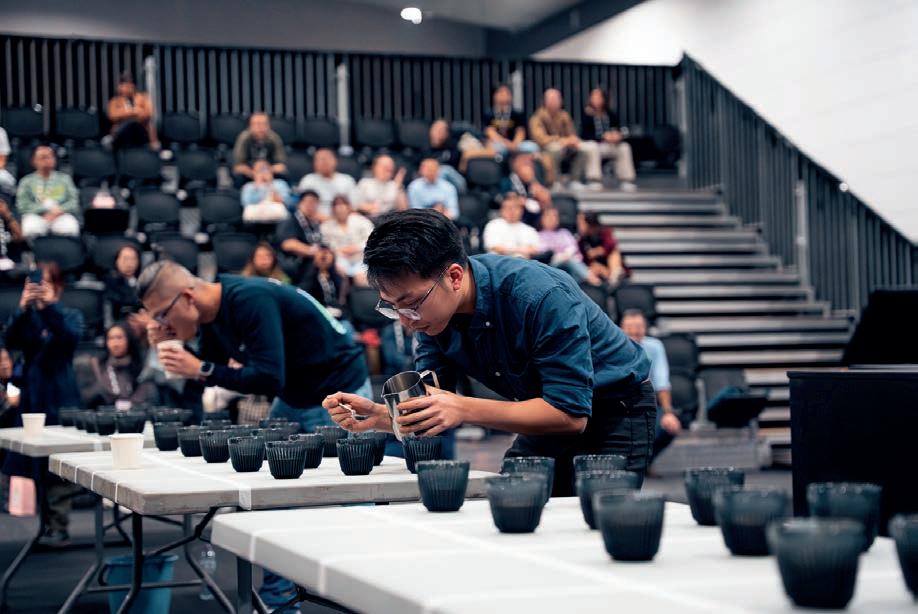
MICE2025 will take place from 20 to 22 March, 2025.
“We are thrilled to bring MICE back to its original home in the month of March, and that we’ve already received overwhelming exhibitor interest in next year’s event, with more than 40 per cent of stands already sold at the conclusion of this year’s event,” says MICE General Manager Siobhan Rocks.
Lauren adds that like all renowned international shows, consistency in scheduling is key to local and overseas participation.


and consequent scheduling backlog postpandemic pushed the expo further in the year,” she says.
“We knew this wasn’t sustainable for exhibitors, therefore MICE will return to its designated position after World of Coffee Dubai in January, and before the Specialty Coffee Expo in the United States in April. MICE will become synonymous with March once again, and we’re excited for how this will positively impact international visitors wanting to travel Down Under and make the most of business in the Asia Pacific.”
Going forward, MICE exhibitors will appreciate a reframed audience that will broaden opportunities and industry connections across the foodservice sector.
“We’re excited to see MICE evolve into the expo Australia deserves,” Lauren says.
The Bean Cartel Co-Founder Alison Visser adds that MICE2025 should be on the agenda for any business looking to connect with a national coffee audience.
“It’s an event that truly brings the coffee community together and offers endless opportunities for growth and innovation,” she says.







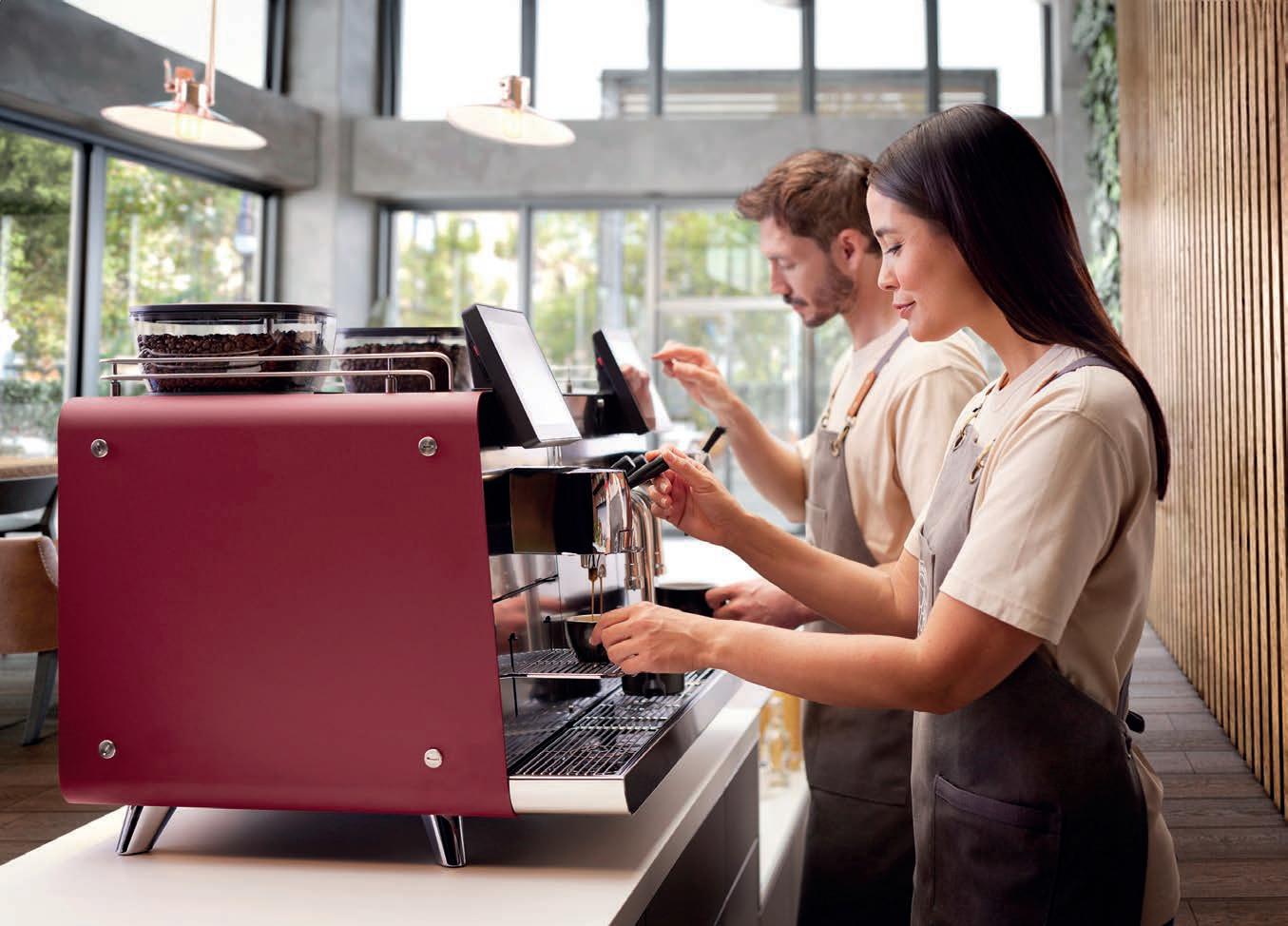
There are two PrecisionFoam spouts on each coffee module, which can deliver up to four different milks.
Franke’s new Mytico Vario PrecisionFoam automatic coffee machine is about to launch in Australia, giving users the opportunity to have as much – or as little – control over their latte art as they desire.
There are days when there’s the time to gently steam milk, give it a moment to settle, and then carefully pour a perfect rosetta; and there are others when time is of the essence and a quality coffee is needed at the touch of a few buttons. Many machines can offer either of these routes to that essential cup of coffee, but few allow the user to switch between different levels of automation within seconds.
Inspired to design a versatile machine to cater to the demands of the many different users that would encounter it each day, the engineers at Franke in Switzerland developed a coffee machine that blended automatic efficiency and traditional manual control. After years of development, the result is its new PrecisionFoam technology, arriving in Australia in winter 2024.
Part of Franke’s Mytico line, the Vario PrecisionFoam is a professional automatic machine that enables baristas to craft highquality drinks with little training, during high-volume peak times, or both. The difference between this new version and the
rest of the Mytico line, however, is that the barista has two options when it comes to milk preparation: fully automatic, where a coffee is selected from the touch-screen interface and prepared from start to finish by the machine; and semi-automatic, where the machine produces the espresso into the cup and delivers ready-steamed and texturised milk direct into a jug.
“The Vario PrecisionFoam is a multifunctional machine that allows you to do everything,” says David Downing, Franke Business Development Director Oceania.
“The most exciting part is that users can press a button and get pre-programmed, texturised milk dispensed into their jug. This enables them to finish the drink with their desired latte art while saving the time needed to steam the milk themselves.”
There are two PrecisionFoam spouts on each coffee module, which can deliver up to four different milks from individual lines stored in milk fridges underneath the bar. This means baristas can swap from dairy to oat to soy at the touch of a button, without the risk of cross contamination.
“Whether the machine is delivering the milk directly into the cup or the barista is using the PrecisionFoam spout, each type of milk is pre-programmed to produce the desired texture and mouthfeel. It’s also pre-dosed as part of the programming, meaning only the exact amount of milk is used, which reduces waste compared to traditional preparation,” says David.
Working with hospitality venues across the world, when designing the Mytico line the Franke team considered the industry’s biggest issues. The Vario PrecisionFoam aims to optimise workflow, reduce time spent crafting drinks, and minimise the training needed to operate it.
David believes the new machine is a great tool for a wide range of venues in Australia, from high-end cafés and restaurants to bars and hotels.
“I see it fitting into top-end cafés that want quality, consistent textured milk, but might not have access to training for their baristas. The ability to switch from manual steaming to automatic also means in busy periods the workflow can be sped up with help from the machine,” he says.

“The system is easy to use. It’s very automated and delivers a quality beverage every time.”
To test the market and garner user feedback, the new version was launched in Europe in 2023. According to David, as word has got out about the machine and users have shared positive experiences, interest has gained moment. In Australia, one of the key focuses will be connecting with the roaster market.
“The roasters have to be confident in the system’s capabilities to deliver their product in the best form possible,” he says.
“We’re getting a lot of positive feedback so far. In recent years, the perception of automation has changed greatly as we’ve seen innovations such as automatic steam wands and software-controlled brewing times being adopted. A lot of what we see in the café scene now has been incorporated in the Mytico.”
With many people returning to the office post pandemic, David has also seen demand for high-quality, intelligent coffee options in corporate settings.
“One of the drivers for people to return to work is having quality coffee in the office,” he says.
“We have a corporate client in New Zealand where the office workers hold their own barista competitions, competing to prepare the best latte art and posting the results on Instagram. Having that quality coffee offering in the office, the management have actually seen an improvement in productivity as the staff aren’t leaving the building to go and buy coffee. They’re turning the mid-morning coffee break into their own barista experience and boosting morale.”
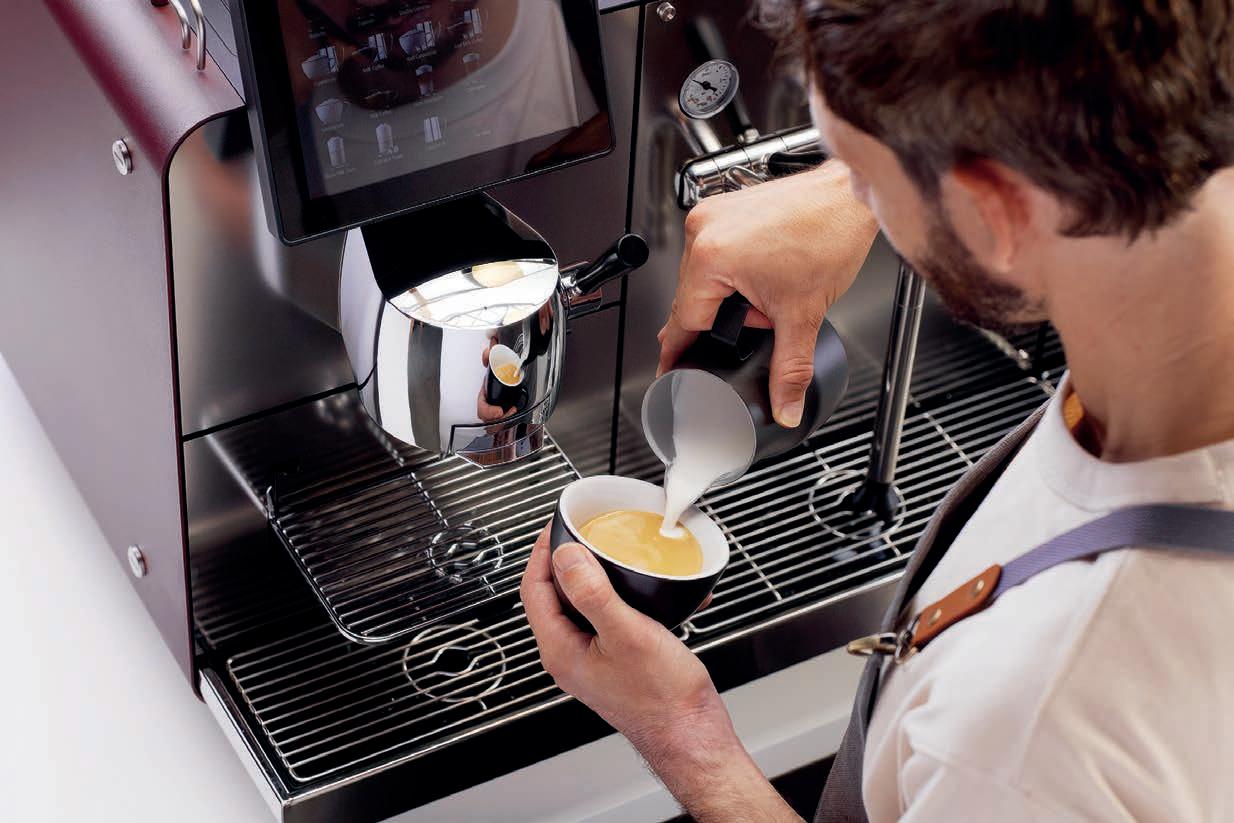
installed, users benefit from an automatic cleaning system which requires minimal input from the operator. Even the cooling units have a self-cleaning function that utilises a self-dispensing cartridge of cleaning products.
In all settings in which the machine is
David also highlights the design of the Mytico line as being a huge selling point of
the product.
“We’ve recently won more than half a dozen prestigious awards for the Mytico line, which are a great testimony to the system. It’s not just the technology, but also the design and look of the machines,” he says.

“I think that has appealed to a lot of the companies that have purchased them, whether they be roasters, architects, or restaurant owners.”
Those recent awards include the Red Dot: Best of the Best in Product Design award, the highest accolade from the international design competition.
“We are particularly pleased to receive this exclusive award,” says Marco Zancolò, Franke Coffee Systems CEO.
“The Red Dot Award is one of the most coveted quality labels for design. And with the Red Dot: Best of the Best award, not only has Mytico’s innovative design and exceptional quality been recognised, but it is also a reward for everyone involved in the development of this game-changing coffee machine.”
David and the team are excited to share the new Vario PrecisionFoam with the coffee lovers of Australia, with the first machines landing in August 2024.
For more information, visit mytico.franke.com




Emma McDougall is the Communications and Administration Coordinator of the NZSCA.
Emma McDougall shares an update on the NZSCA’s partnership with the Energy Efficiency & Conservation Authority, including the new carbon-reduction tools available to its members.
During the May NZSCA AGM, Second Vice President Scott Pepler presented sustainability as a dedicated portfolio. While significant progress has been made in various areas over the years, this new portfolio will provide enhanced support and guidance to our members. We aim to foster increased collaboration for the betterment of both the environment and our industry.
Our primary focus has been on advancing our partnership with the Energy Efficiency & Conservation Authority (EECA) and its Coffee Decarbonisation Pathway, a collaboration that has been instrumental in driving sustainability initiatives within our industry. Our relationship with the EECA was cemented with an Industry Collaboration Agreement, and we worked closely with Program Lead Insa Errey and the EECA team.
Year one highlights included hosting three workshops around New Zealand to engage with coffee roasters. We then created and collaborated with a working group of roasters to measure and target energy usage. This led to the development of an energy calculator, which is now available in Excel format on the Pathway. The working group also helped identify cost-saving measures and productivity enhancements, resulting in a checklist to guide roasters in optimising and automating their processes, which is also available as part of the Pathway.
The next year will focus on reducing energy demand. With EECA funding and the help of experienced engineer Cameron Russell, we conducted a global technology scan which involved cooperation with suppliers, roasters, and the EECA. The Coffee Roasting Technology Scan Report is now live online and part of the EECA and NZSCA Coffee Decarbonisation Pathway. The report is divided into three main sections: Fuel Switching, which explores

options such as electric, hydrogen, and nearinfrared technologies; Demand Reduction, addressing issues such afterburners, which can triple gas usage, and investigating alternatives; and Heat Recovery, covering techniques such as preheating of air and green beans.
We highly encourage all members to review the report, especially those who are considering purchasing new equipment. This will help to future-proof their operation with the latest technology or future alternatives.
Fuel switching, particularly for larger roasters, may seem daunting, but incremental steps can lead to significant advancements. By following this Pathway, our industry can be at the forefront of adopting new sustainable technologies while also delivering delicious coffee.
We encourage members to utilise the tools provided to achieve efficiency and
optimisation gains. Recognition from EECA and NZSCA awaits the member company demonstrating the most significant improvements.
We extend our gratitude to the numerous roasters and suppliers who supported this report. Special thanks to Alex Sholtz of Probat and Ron Kleist of Vortx, who attended the AGM to share alternatives and innovations. We also extend our congratulations to Scott and the team for producing an incredible document for the benefit and progress of our industry.
In the future, we plan to hold a webinar to further discuss and collaborate on these findings, inviting suppliers to participate.

For more information on the New Zealand Specialty Coffee Association, or to join, visit nzsca.org
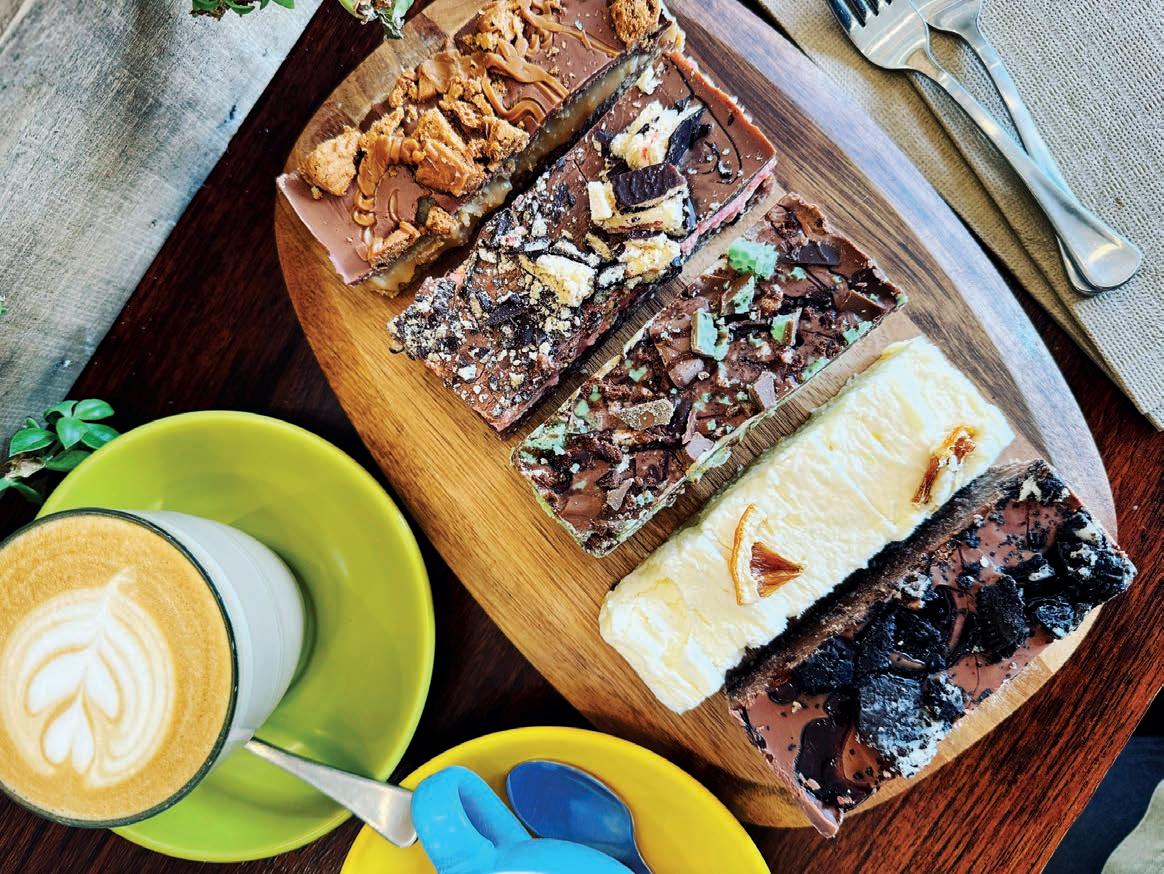
THE COURT COFFEE BAR
Shop 2, 20/30 Sussex Court, Sunbury, Victoria, 3429
Open Monday to Friday 6am to 3pm, Saturday 8am to 3pm.
Located in Sunbury, a Melbourne suburb known for its country feel and strong sense of community, The Court Coffee Bar is a welcoming spot to sit back and relax with a well-crafted cup of coffee.
Taking over the café in 2023, in a short space of time new Owner Amy Jones renovated the premises to create the humble, vibrant oasis The Court Coffee Bar is now.
Priding herself on giving the best possible customer experience, Amy dishes out her infectious positivity and enthusiasm alongside a range of blends and single origins from local specialty coffee roasters The Bean Cartel.
“I wanted to give people an experience when they visit: an escape from the hustle and bustle of the city. A place where they can meet friends and family, bring their pets, and sit down for a minute – or a couple of hours,” says Amy.
“I rotate the coffees each week, so when one finishes another starts. This means customers can get a taste for the next origin of beans and are always expanding their palates.”
El Capitán is the most popular blend among the café’s regulars, striking the
perfect balance between red wine and berry sweetness, with a creamy hazelnut body and dark chocolate finish.
“I wanted a black and a milk-based coffee, so The Bean Cartel suggested La Patrona for black and El Capitán for milk,” she says.
“We also have a grinder that rotates
through single origins for batch brew. This way there’s always something new for our customers to try. I like to showcase exciting coffee varieties from all around the world –from Peru to Mexico, India to Ethiopia.”
Building on the success of the batch brew, Amy is looking forward to installing batch taps at the café, with help from the team at The Bean Cartel. She hopes to have them up and running in time for the summer cold-brew rush.

To pair with the coffee, Amy and team serve a delicious range of baked slices, which are all made in-house using seasonal ingredients.
“Everyone raves about the coffee, it’s so smooth and you can taste all the flavours which makes it such an experience for the customers. It also goes well with our slices, which fly out the door – the Biscoff slice is the most popular,” she says.
Taking inspiration from The Bean Cartel’s bold branding, Amy blended her own style with the vibrancy of the roaster’s distinct designs to create a unique space in which to explore interesting coffees.
“I wanted the café to be somewhere you can walk through the doors and instantly feel calm and happy,” says Amy.
“Our coffee machine is a beautiful blend of mint green and pink, and all our mugs come in lively colours – very much like The Bean Cartel designs. I’ve made use of every inch of space to infuse it with colour and, most importantly, coffee.”
26 Metro Parade, Mawson Lakes, South Australia, 5095
Open Monday 7.30am to 12.30pm, Tuesday to Friday 6.30am to 2pm, and Saturday 7.30am to 12pm
When Adrian DiGirolamo tried a particularly eye-opening espresso while working in an Adelaide café, he knew instantly that one day he’d run his own café.
The espresso, an Ethiopian single origin he described as tasting like blueberries, had a huge impact on him, and prompted him to buy a Sunbeam coffee machine to experiment with making coffee at home.
“It was this lightning bolt moment that made me realise I wanted to do a deep dive into the coffee industry, and things just snowballed from there,” says Adrian.
A few years later, in November 2021, Adrian finally scratched his itch and established Giro Espresso in Mawson Lakes, Adelaide.
“I couldn’t wait any longer, I had to get it done. Come hell or high water, it just needed to happen,” he says.
Finding a coffee roaster to work with was easy: Adrian called up his friend Ben

CURLY’S ON THE CORNER
77 Pitt Road, North Curl Curl, New South Wales, 2099 Open Monday to Sunday, 6.30am to 2.30pm
When Jay and Angeline Barthaw decided to take a leap of faith and enter the world of café ownership, they saw Curly’s on the Corner as the perfect opportunity.
“The café was well known on the northern beaches of Sydney and had a great community feel, so it made our decision to

just outside of Adelaide CBD.
“We originally met over a trade of Nintendo items, and then we got chatting. It turned out he was a coffee roaster; this was when BLK MRKT Coffee was in its really early stages.
One day, he gave me a bag of coffee and I loved it,” says Adrian.
Friendship aside, BLK MRKT Coffee being a local roaster was also a huge consideration for Adrian, who supports local brands as much as possible.
Adrian describes Giro Espresso’s decor as both “rustic and retro”, and one of his favourite parts of the space is the feature shelf filled with vintage coffee grinders.
take the plunge much easier,” says Jay.
The couple thought it was important not to change too much when they took over, keeping the vibe welcoming and familiar for the locals who’ve visited for over 20 years. With its blue and white beach-hut style and a laid-back, surfy feel, the café fits right into its coastal surrounds.
“It’s where people can come in after a surf or swim to relax with a cup of good coffee and chat with friends,” says Jay.
“We wanted to put our mark on it, but felt it was more important to pay our respects to the previous owners.”
Thanks to the strong community it has created over the years, Curly’s on the Corner has established itself not only as a café for good food and coffee but also as a meeting place for the busy suburban town.
“We have a lot of regulars who come in every day and we know all their names,” says Jay.
To suit the palate of the café’s more mature audience, Jay and Angeline wanted a bold medium roast that would be a guaranteed crowd-pleaser. They decided to work with Sydney roaster Paradox Coffee Roasters, which now supplies its Penny Lane blend for all of Curly’s on the Corner’s serves.
“I wanted something that was strong in taste. Penny Lane is rich in flavour and has notes of chocolate, which our customers love. They’re looking for a great-tasting
While making good coffee is the core focus, the Giro team also emphasise the importance of having something delicious alongside coffee.
“The truffle and mushroom toastie is probably my favourite thing on the menu, because nobody else really does anything like it around here. It’s got mushrooms, truffle oil, herbs, and just a bit of mozzarella,” says Adrian.
There’s also a range of sweet treats, which make the perfect pairing to the locally roasted coffee. The house-baked gluten-free muffins are wickedly indulgent, as are the s’more cookie cups.
coffee with nicely textured milk. With Paradox Coffee Roasters we’ve been able provide that,” he says.
For food, the menu centres around a longstanding Curly’s staple: the breakfast roll.
“Food is our strong point. We’re famous for our bacon and do a lot of rolls,” says Jay.
“Our most well-known roll is our Curly Roll, which comprises cheese, avocado, sweet chilli, and, of course, bacon. Paired with a coffee, it’s the best combination as it really brings out all the flavours.”
For Jay and Angeline, the most important thing going forward is focusing on their customers while maintaining the café’s status as a communal hub of activity.
“The most rewarding part of taking over
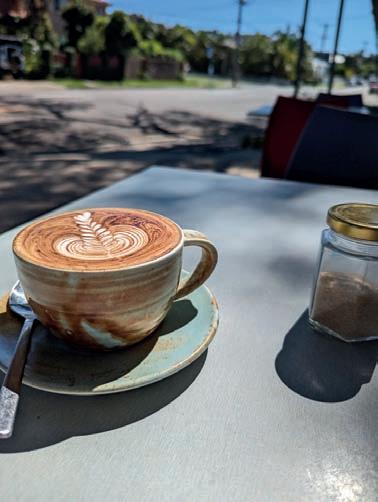

SCROGGIN COFFEE AND EATERY
71 Ardmore Street, Wānaka, New Zealand, 9305
Open daily from 7am to 3.30pm
Following a brief stint in law school, in 2021 Lucy Conway pursued her dream of owning her own café. After moving back to her hometown of Wānaka in New Zealand, she found an old café for lease, which she took the time to renovate from top to bottom to create Scroggin Coffee and Eatery.
A unique and homely café where you can taste local produce in traditionally inspired dishes, its interior design is reflective of the beautiful New Zealand landscape and backcountry huts of Wānaka.
“When people walk into the café, I wanted it to feel like an extension of the environment, so we only used natural materials to create a warm and earthy feel,” she says.
Lucy’s desire to encapsulate the café’s surroundings and culture expands to the food menu, where seasonal ingredients are prioritised.
“Since day one, our Scroggin Benedict has been the best seller. It’s a simple breakfast sandwich, but people just love it,” she says.
“We also have a lamb toast to showcase local produce. With these richer dishes, I always recommend pairing it with a black coffee.”
As for sweet treats, all of Scroggin’s croissants, cakes, and breads are baked in-house and served alongside its range of specialty coffees.
“It is a growing part of our business and,
so far, it’s been well received. The best way to start the morning is with a croissant and cortado,” says Lucy.
The café’s name takes inspiration from the colloquialisms of the area, something Lucy says is fitting considering the inspiration behind her food and interiors.
“The name Scroggin is the New Zealand term for trail mix. Trailmix is sweet and salty, so the café represents all the good things mixed in one.”
This idea is also reflected in Lucy’s choice of coffee, which is provided by local roaster Wolf Coffee.
“We use a light to medium roast which has chocolate and blueberry notes; I describe it as being light and delicate,” she says.
“I really wanted our coffee to be different. I love to educate my customers on our blend, especially why it’s different to some of the other darker roasts available in the area.
“Using a small local roaster is important to us in terms of sustainability too, having the team close by is great and they deliver beans in reusable tins.”
Four years into the business, Lucy is planning her next moves and is looking to expand by introducing another location in the town.
“I’ve been looking to open another café for about a year and a half now, but I am taking my time until I find a property that looks and feels right,” she says.
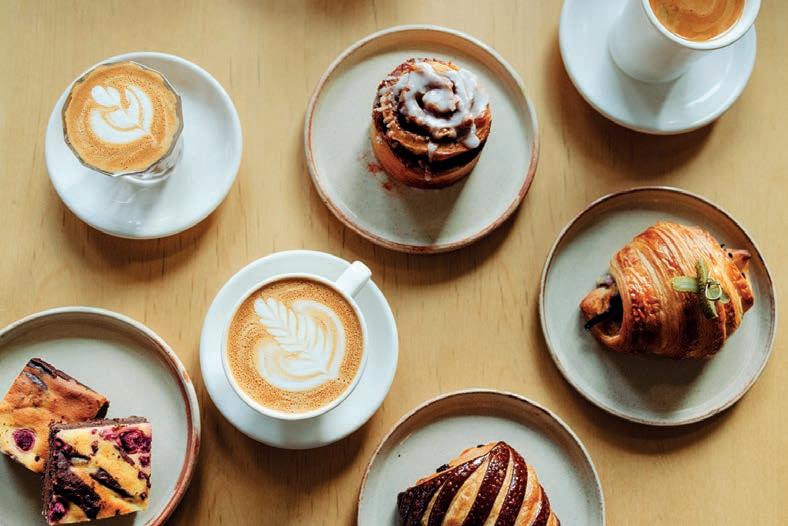
29 Logan Road, Woolloongabba, Brisbane, Queensland, 4102
Open Tuesday to Sunday, 6am to 3pm
When Cerin Pasticceria opened its doors in May 2024, Co-Founders Giuseppe Caputo and Matteo Cerin were not prepared for the huge crowds that arrived from day one.
“It was unexpected but amazing,” says Giuseppe.
“Now, every day we have a queue that forms from early in the morning and we sell out of our pastries by around 12.30pm.”
While French bakeries have long been a part of the Brisbane food scene, prominent Italian bakeries were scarce until recently. With Giuseppe and Matteo both hailing from Italy, they saw an opportunity to introduce a slice of Italian culture to Queensland.
“It’s common in Italy to head to a pasticceria, where you will get one or two kilograms of little cakes to share with your family. You don’t have the same tradition if you go to a French or Australian bakery,” says Giuseppe.
“We are almost 17,000 kilometres away from home, but this is something we can do to bring the Italian community together.”
Cerin Pasticceria has quickly turned into a go-to spot for Brisbane’s Italians, but it’s also attracted enthusiastic followers from locals and other expats in the city.

“Someone showed me the social media platforms and we’ve gone viral. We are super happy because we don’t just target Italians, and knowing that we are also popular among the Asian community, and Australians in general, is fantastic. It is very rewarding for us,” says Giuseppe.
The bakery serves a wide variety of cakes, tarts, and baked goods, but one of its most popular offerings is the humble cornetto: an Italian croissant.
Giuseppe estimates that they sell at least 300-400 cornettos on a typical day, and
on weekends up to 600 can fly out of the doors before noon.
To pair with its Italian treats, Cerin Pasticceria serves Veneziano Coffee Roasters’ Elevate blend, which was chosen after a careful screening process.
“We had six tastings with different companies. We tried other Italian blends, but Veneziano was the best,” says Giuseppe.
“Veneziano is also a very appealing name, and we love the logo. I think it marries perfectly with our products.”


Hot from his appearance at the World Latte Art Championship 2024 in Copenhagen, Australian Latte Art Champion Victor Vu shares his cheeky raccoon design.
Followers of the World Latte Art Championship (WLAC) 2024 in Denmark would have seen Victor Vu progress to the semi-finals of the competition with his jungle-inspired designs. His impressive animal artwork included a jungle fowl, howling wolf, mighty lion, and wise owl, which he says were influenced by the great outdoors.
“I love nature and this year, with the use of the automatic machines in the competition [the first time a super automatic machine has been permitted for baristas to use], it was nice to bring an element of this
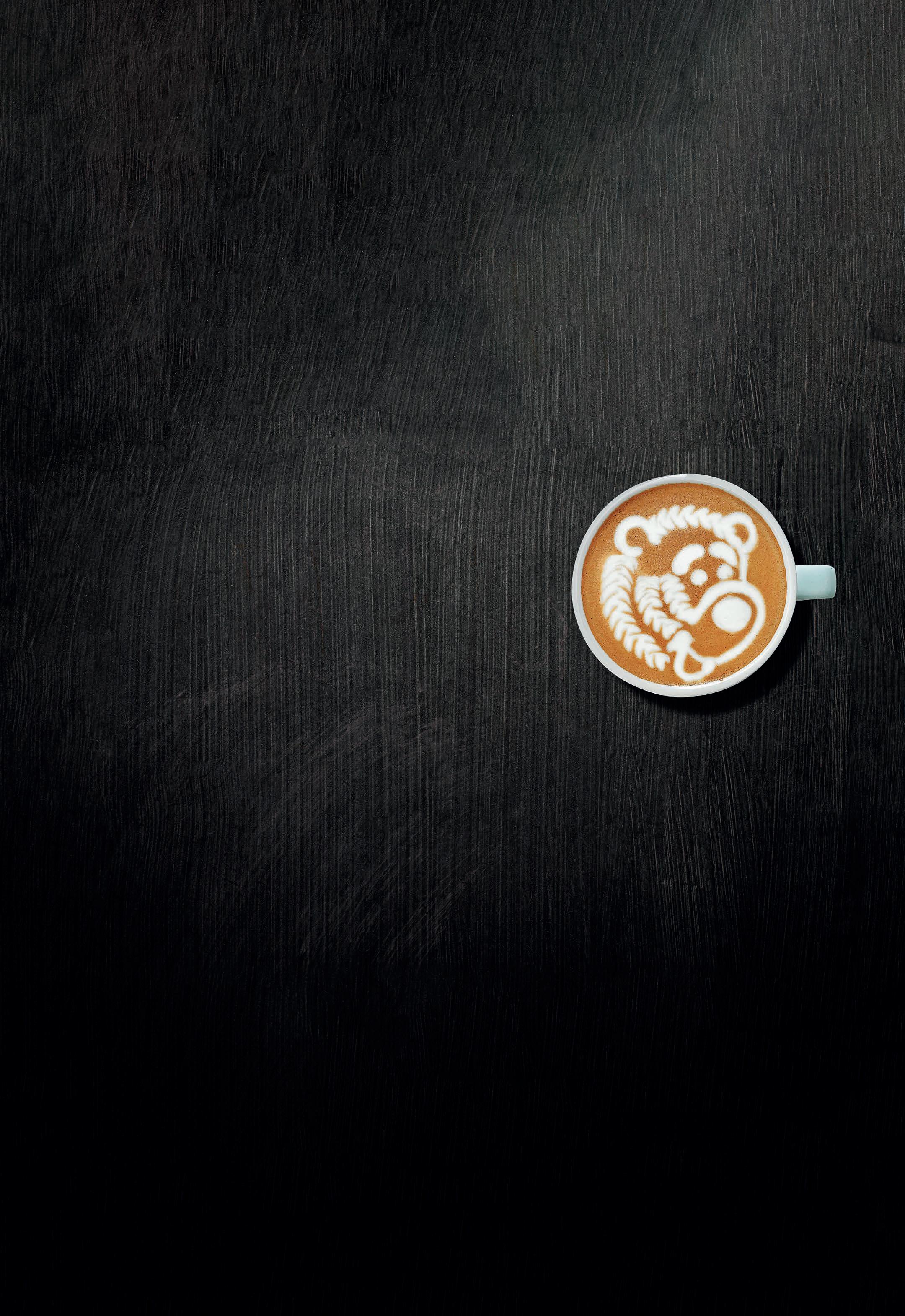
into my work and to make a connection between nature and coffee,” he says.
“Since I was a child, I have always loved the jungle, so all of the animals I design are from there.”
While not part of his WLAC routine, the raccoon is member of Victor’s wider family of animalinspired designs.
“This is quite a difficult design to reproduce because there are a lot of technical steps. You’ll need to be able to pour a good rosetta, as these form the base of the branches and the raccoon’s body,” says Victor.

Start with your cup handle at six o’clock and build your base, chasing any whites. To form a large leafy branch, pour a 12-leaf rosetta on the left-hand side of the cup. Pull through.

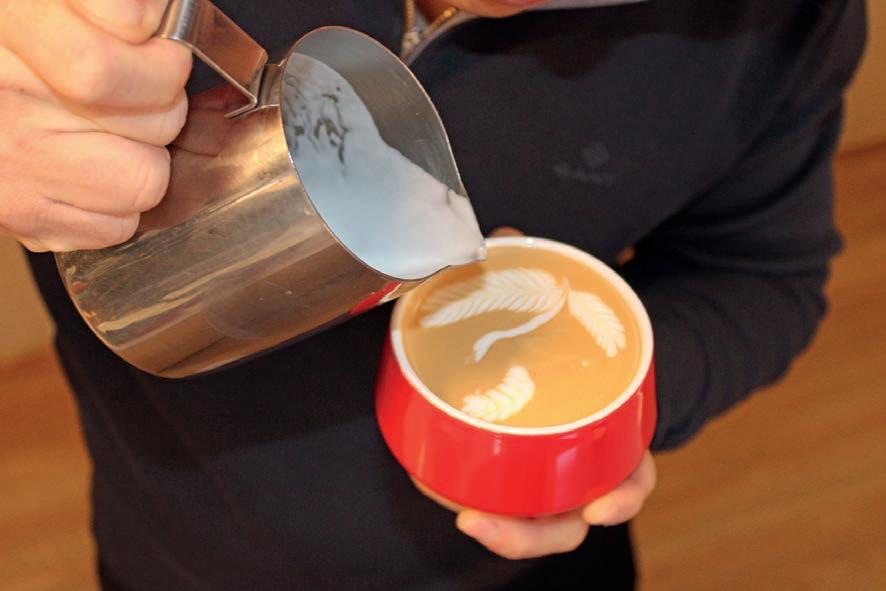
Using the weight of the flow, drag the milk from the centre of the leafy branches up to the body of the
Rotate the cup clockwise 90 degrees and pour a six-leaf rosetta above your first rosetta so the ends meet. This will form a smaller leafy branch that curves along the top rim of the cup. Rotate the cup and aim your pitcher at 12 o’clock. Pour a four-leaf rosetta curving into the centre of the cup. This will form the raccoon’s body. Pull up.
From the base of the raccoon’s body (four-leaf rosetta), drag a curved line down the cup to form the tail, and another one beside it to add thickness to the tail. Link the two side of the tail with three spaced lines.




With the handle at six o’clock and in one continuous motion, aim your next pour at 12’clock at the top of the cup and draw a diamond shape to create the raccoon’s head. Draw a line through the middle and a small circle at the end, leaving a gap of crema to form the nose. Draw a small curved line above the head and pour two drops of milk to create ears.
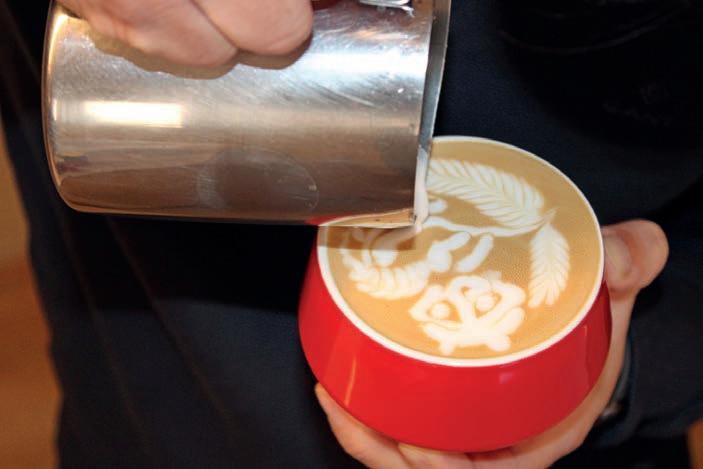
Aim the pitcher close to the cup surface and slowly pour two drops of milk either side of the racoon’s face to form eyes.

Finally, drag the milk to add the legs, making the front legs thinner than the back .
Name: Junnie Ph yu
Nationality: Australian/Burmese
Company: Junnie Cof fee Workshop
Instagram: @junnie.77
When and where was your first job in the coffee industry?
Around 10 years ago I started working at a Malaysian coffee shop in Abbotsford, Melbourne. I had zero experience and knew nothing about coffee, but the manager was kind and taught me how to make an espresso. After the café closed in the evenings, I would stick around to practise pulling shots and steaming milk.
What inspired you to pursue a career in coffee?
I was really curious about latte art, and that attracted me to the industry initially. The more I learnt about coffee, the more I started to enjoy dialling in new beans and understanding different flavour profiles.
Favourite part about being a barista trainer?
I’ve always loved making coffee and chatting with customers, but as a barista trainer I enjoy sharing my experiences with others who are also interested in coffee.
Biggest accomplishment to date?
Launching Junnie Coffee Workshop. I started it at the back of my kitchen with a small training studio, and it’s grown really well over the past few years, gaining respect from people in the industry.
Most memorable coffee experience?
My first proper date with my husband, who also works in the industry, was at Factory Coffee in Bangkok, Thailand. We shared two coffees – one pourover, one white – and they were both fantastic.
What’s your usual coffee order?
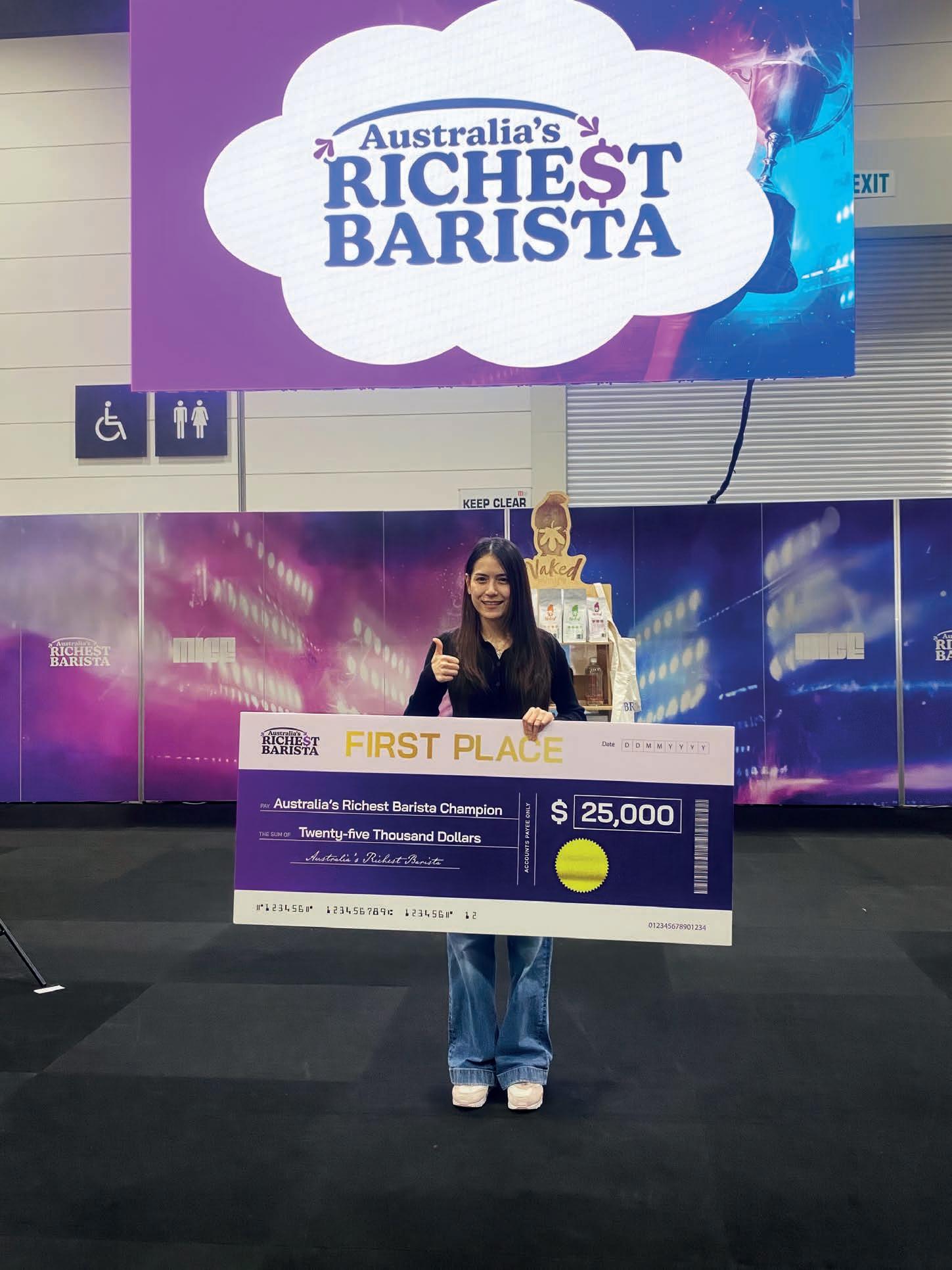
I make myself a pourover every morning as soon as I wake up, but if I go out for coffee I’ll order both a filter and a white coffee to compare the two.
Favourite local place to drink coffee?
In Melbourne, I like Ona Coffee in Brunswick and The Flour in West Melbourne.
What’s your brunch order?
If it’s on the menu, I’ll always order eggs benedict with pulled pork. Failing that, I’ll go for a salmon dish – we recently went to Mister + Miss in Mont Albert which did a great salmon brunch.
How did it feel to be crowned Australia’s Richest Barista 2024?
I was happy and surprised. Cupping is not my strong point, I only started training in it when I entered the competition, so I was unsure how well I’d do in the final round. Even though I’d done a lot of training in preparation, during the competition I still doubted myself, so I was very humbled when I won.
What will you do with the $25,000 prize?
I’m hoping to go on a family holiday: either to New Zealand when it’s warmer, or to Japan so I can take my daughter to Disneyland.
Your advice for baristas looking to compete?
Enter a few smaller competitions before taking part in something bigger such as Australia’s Richest Barista. It’s important to have experience presenting on stage to crowds to build your confidence.
Future goals in the coffee industry?
I’ve recently started roasting my own coffee with an Aillio Bullet, which I’ve kindly been loaned. I’m still new to roasting, but I’m looking forward to learning more.

